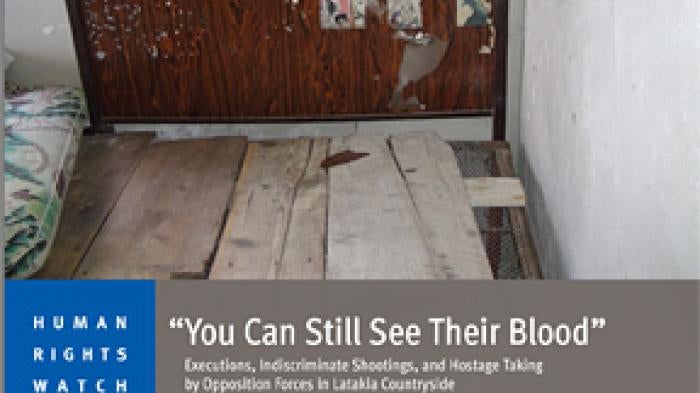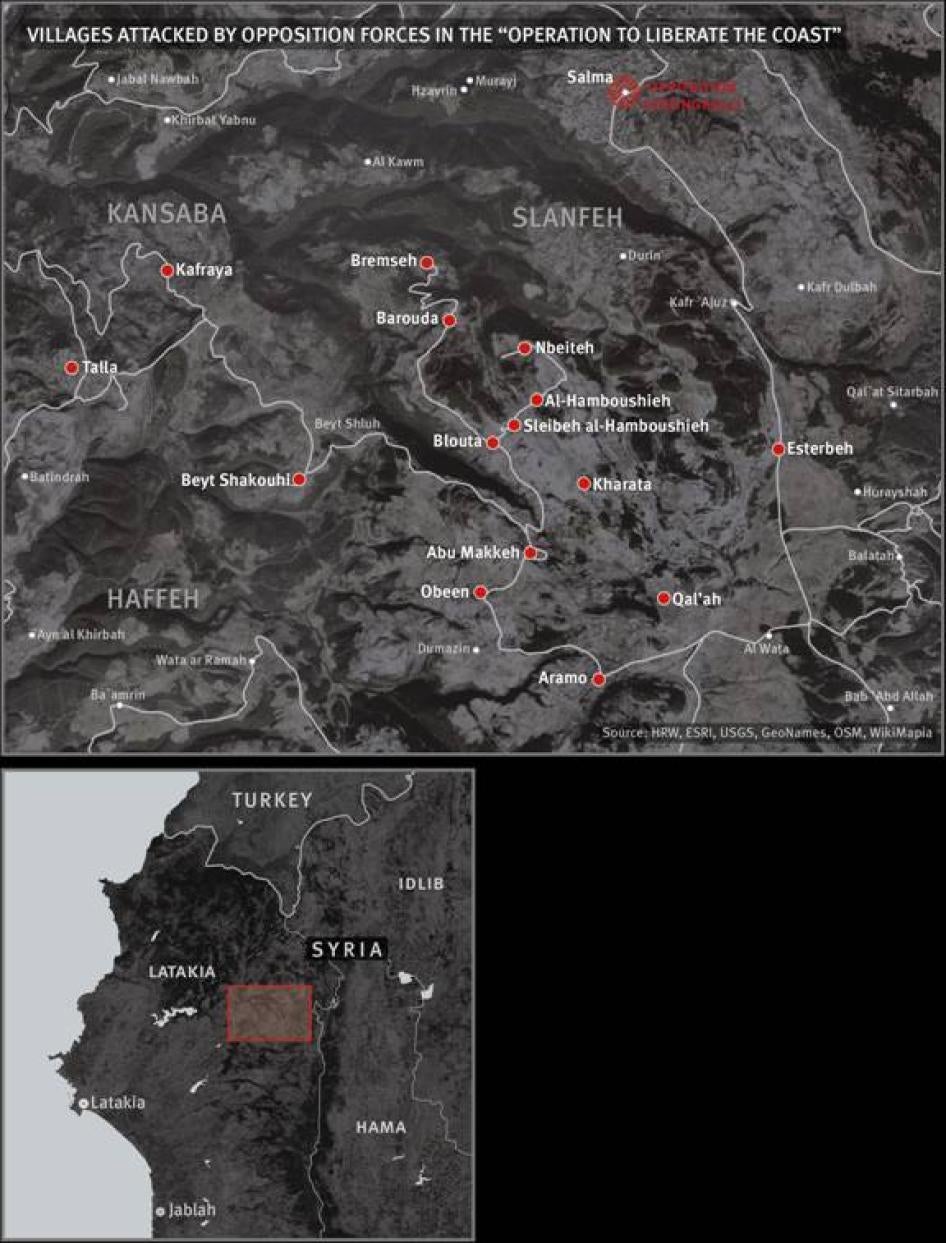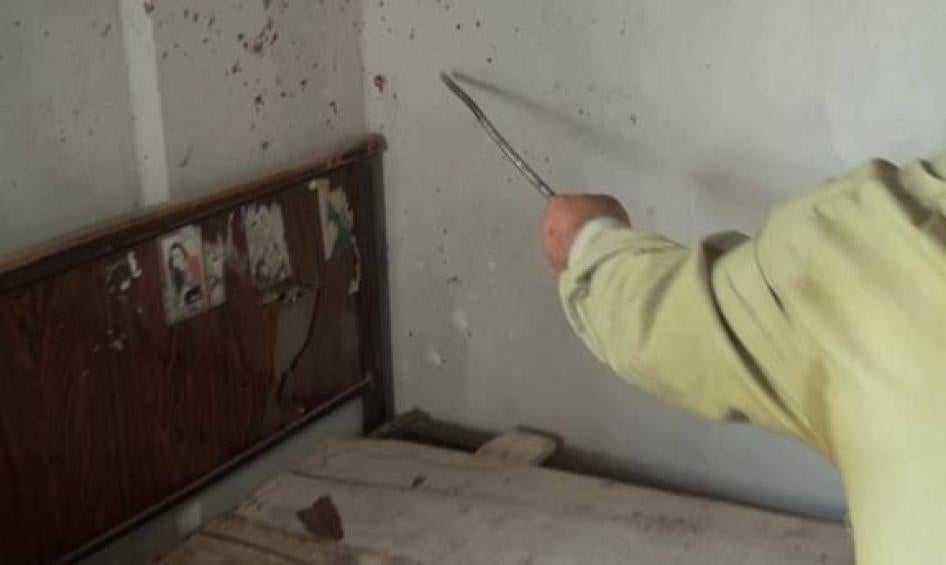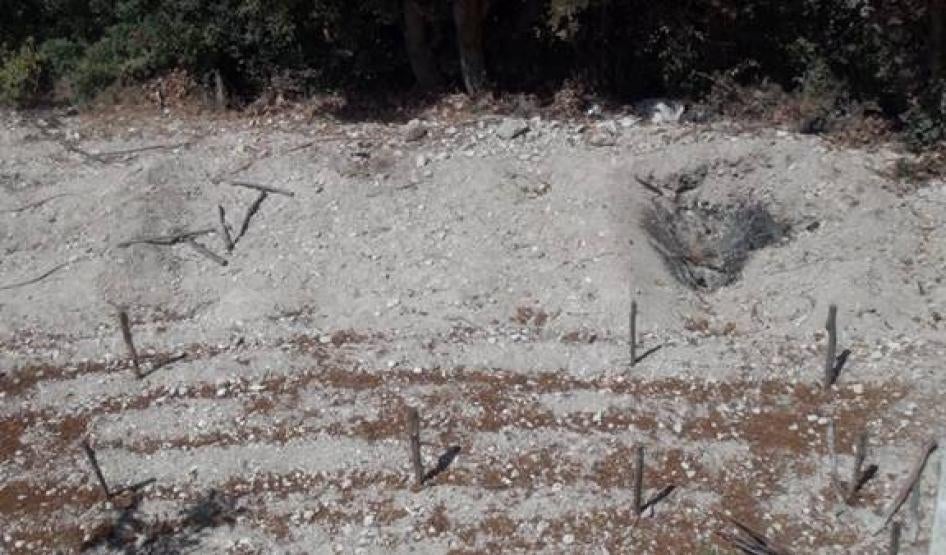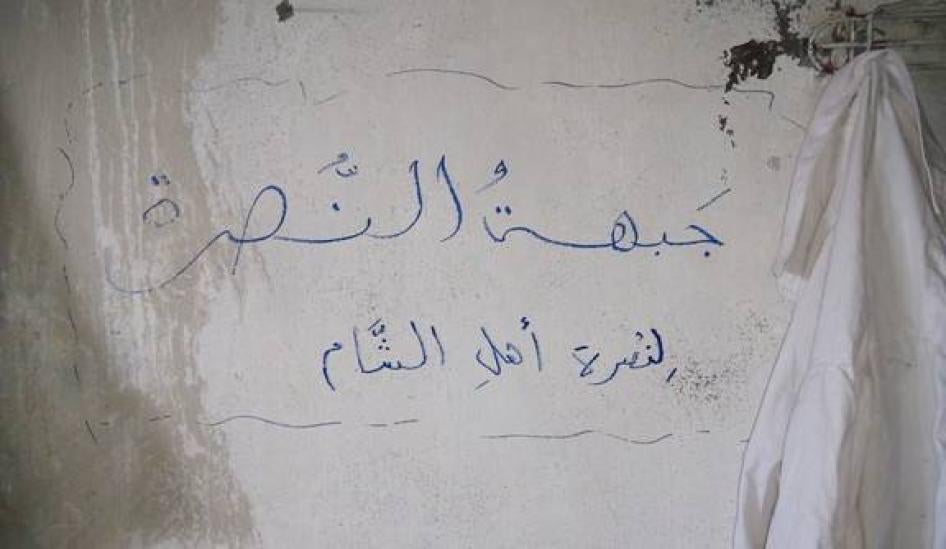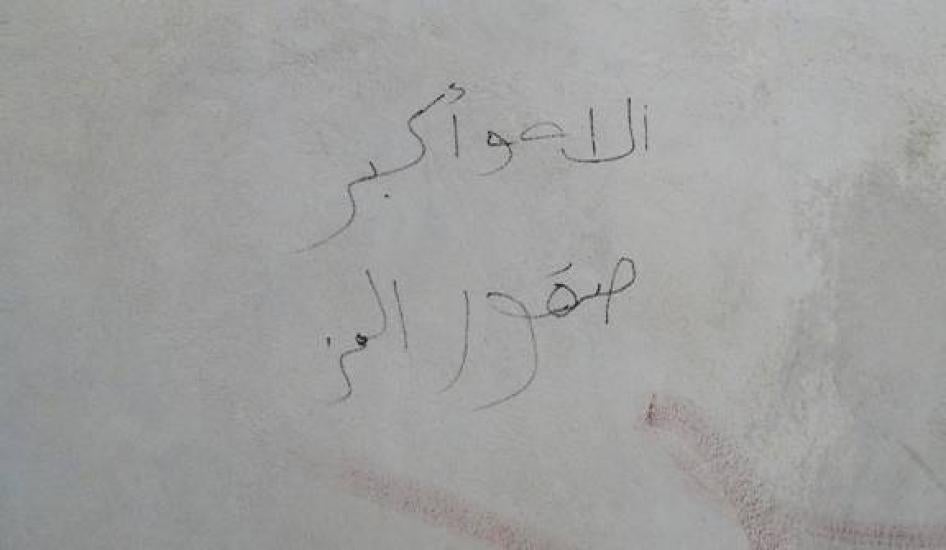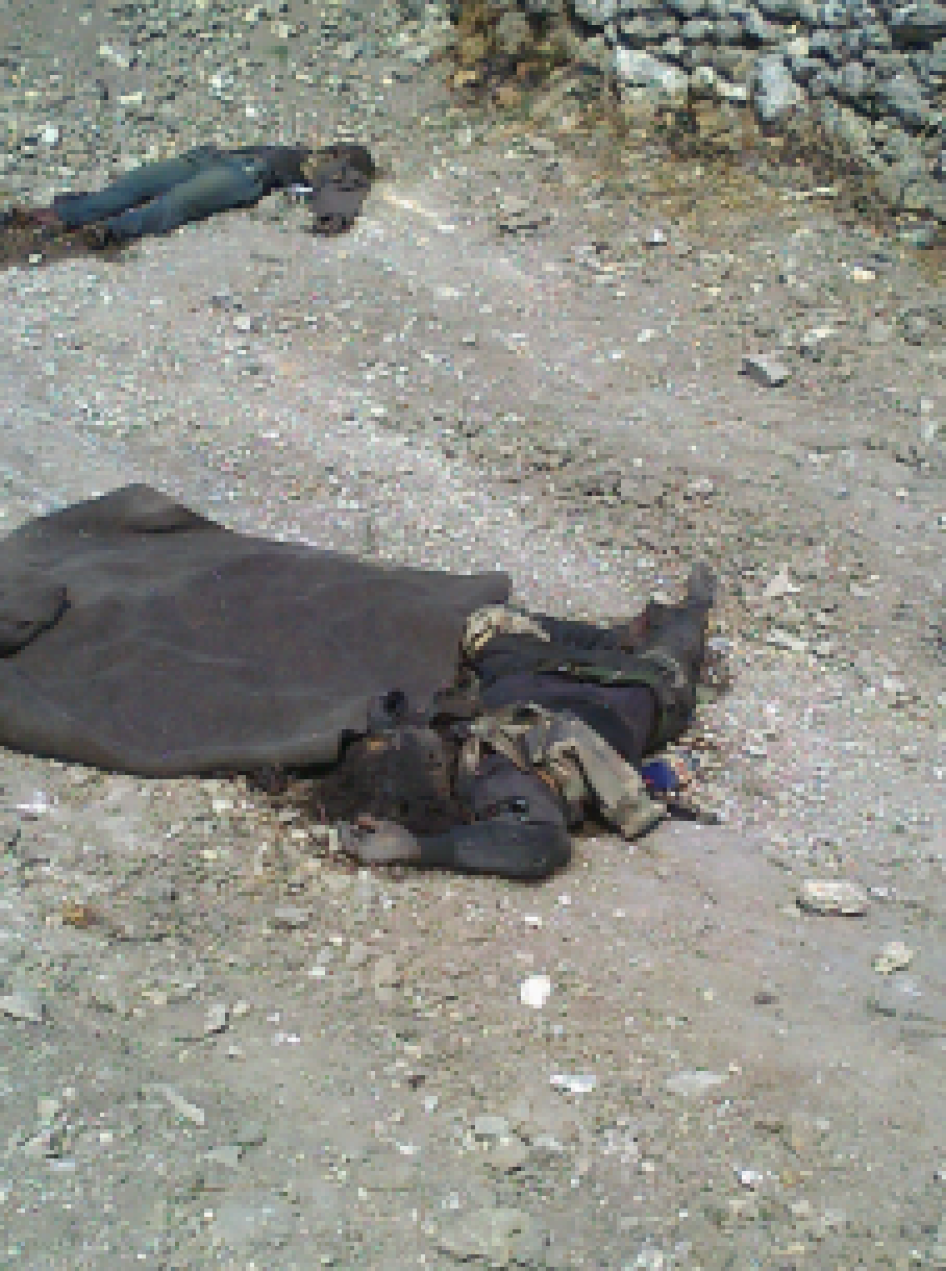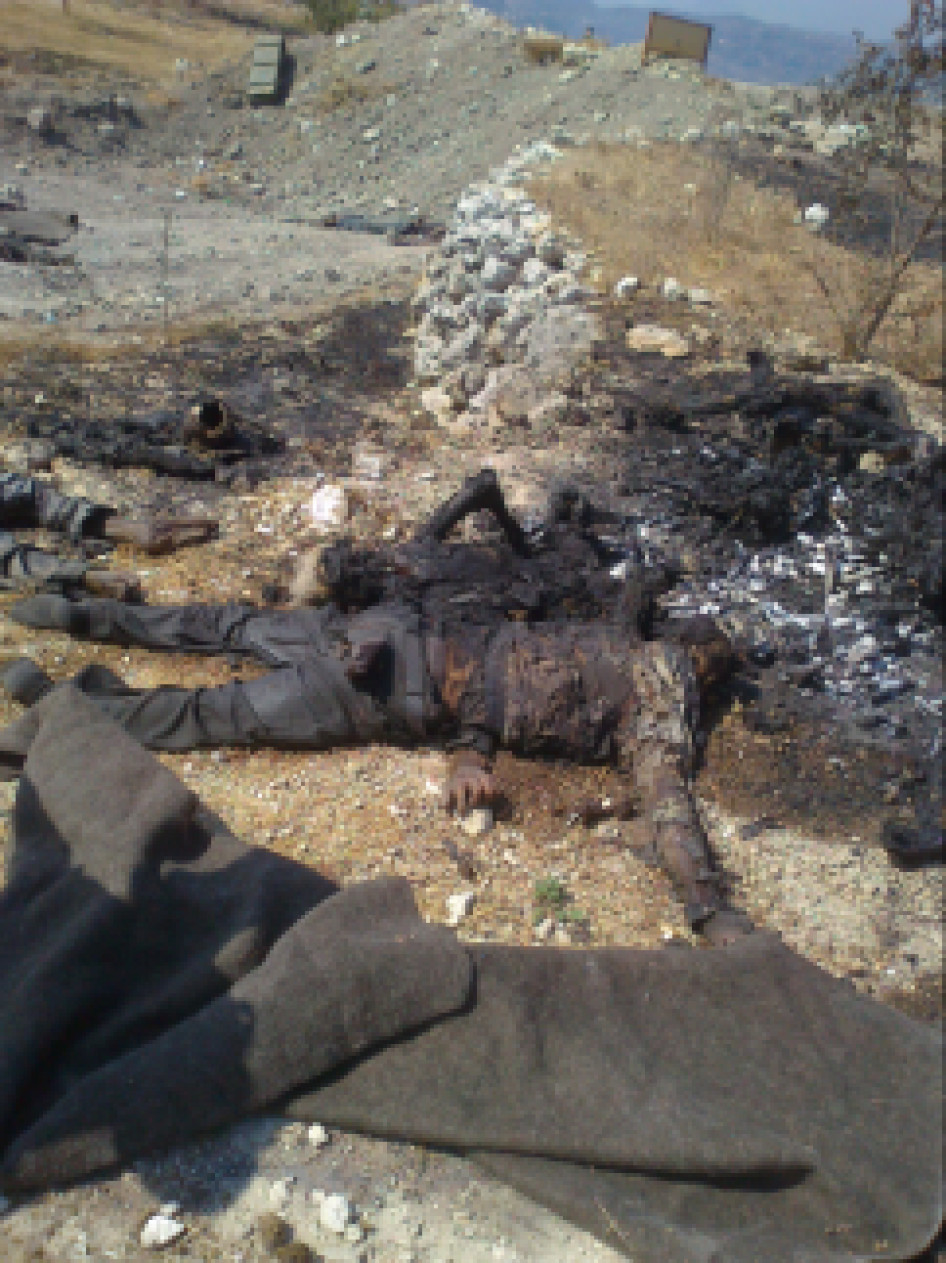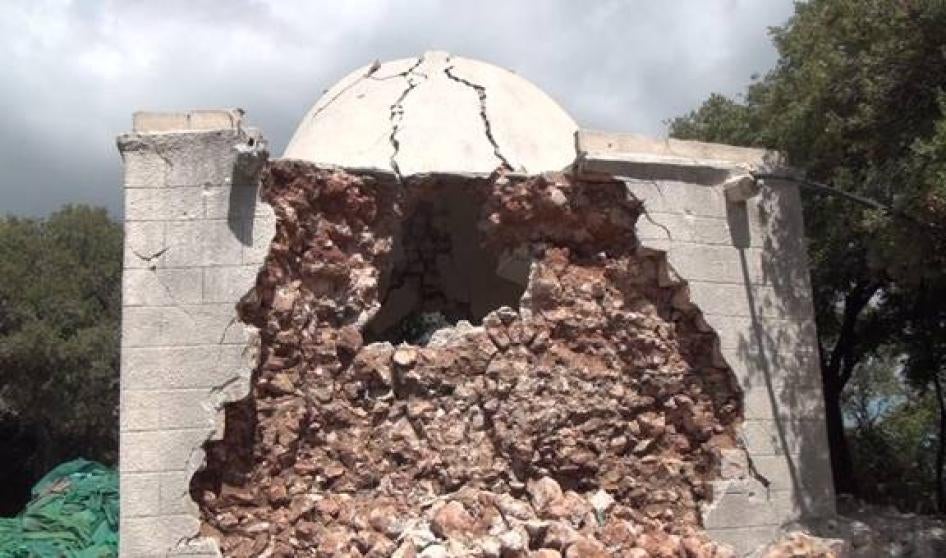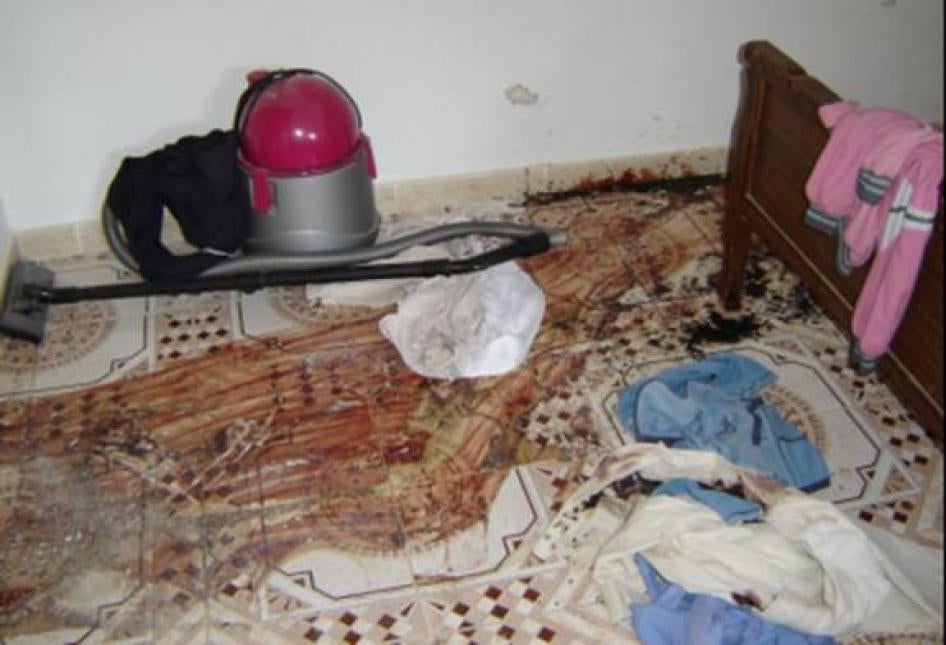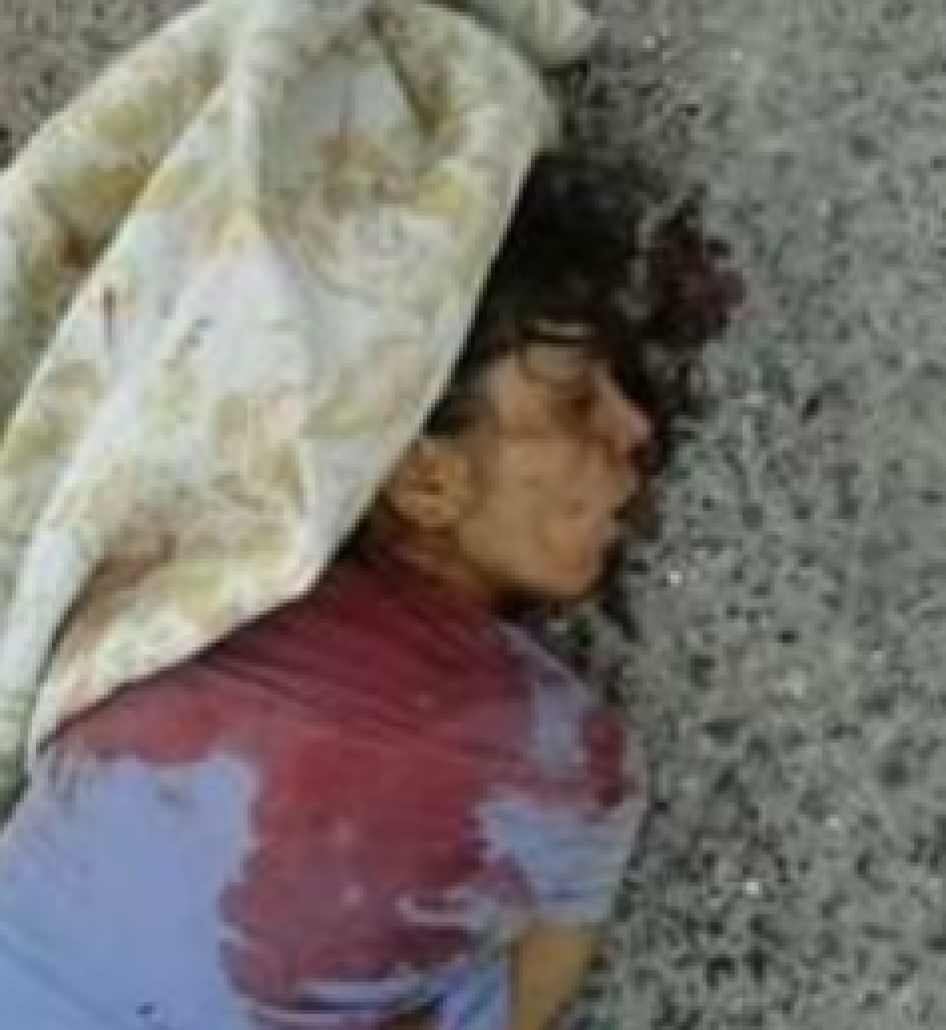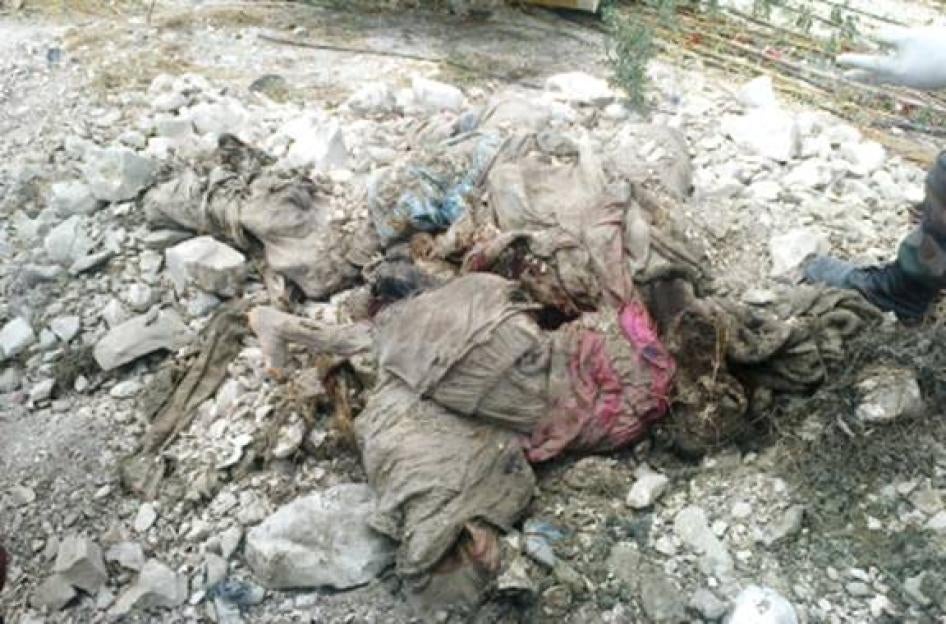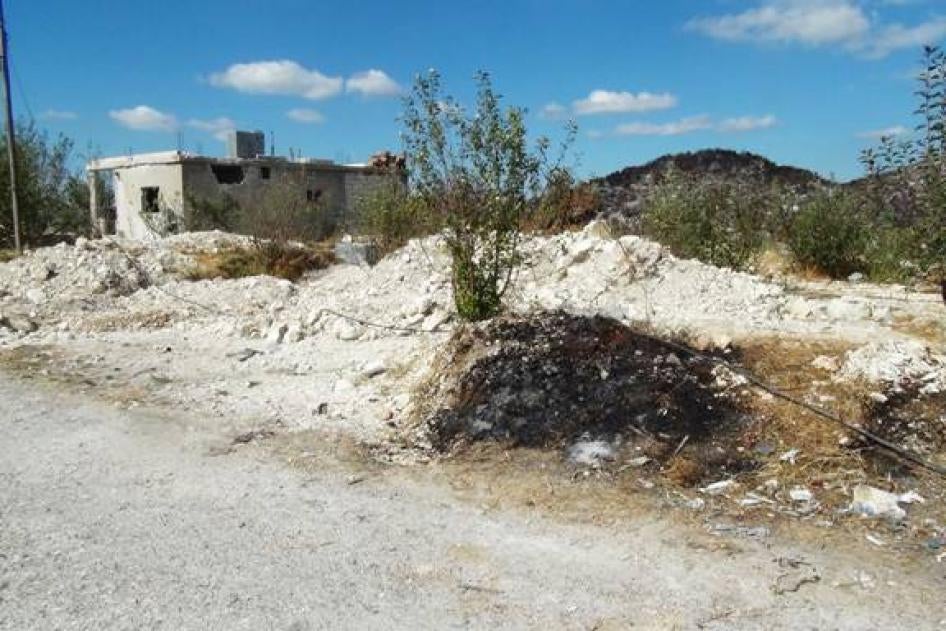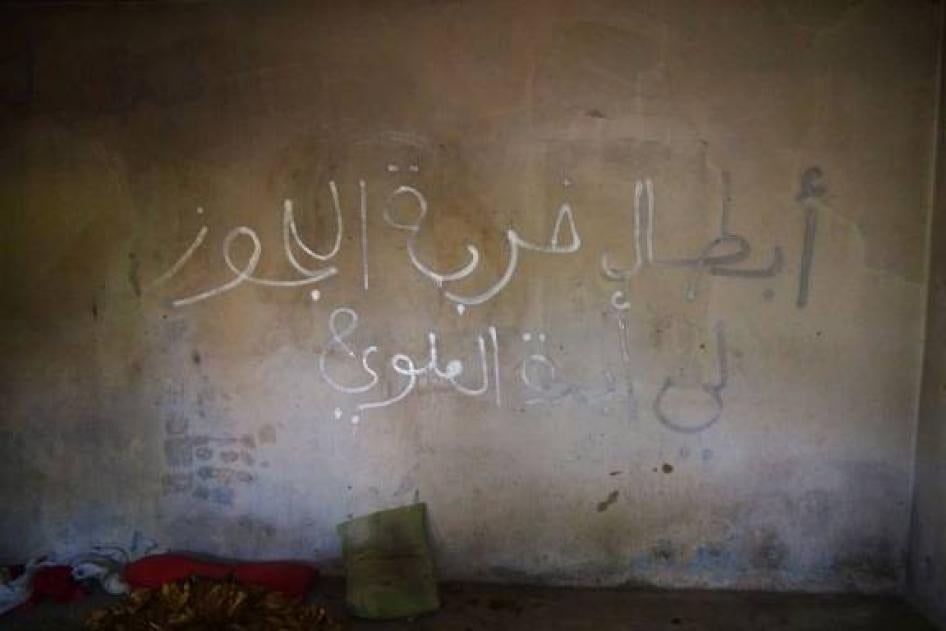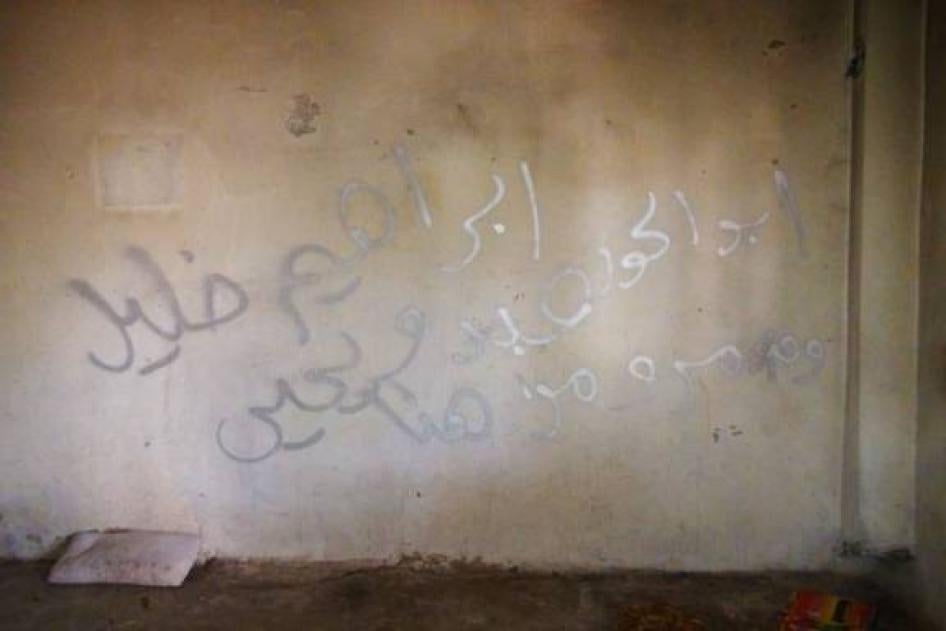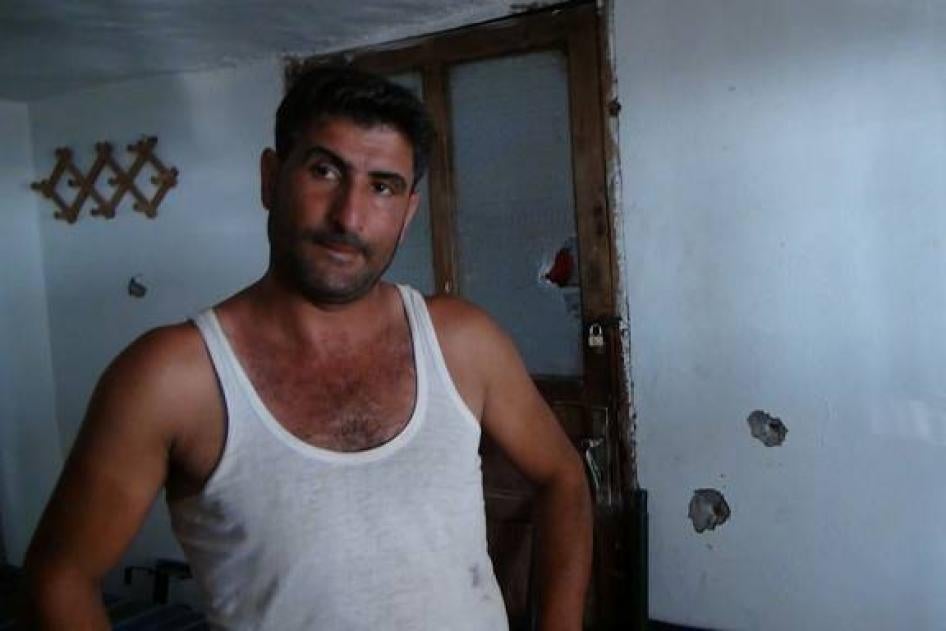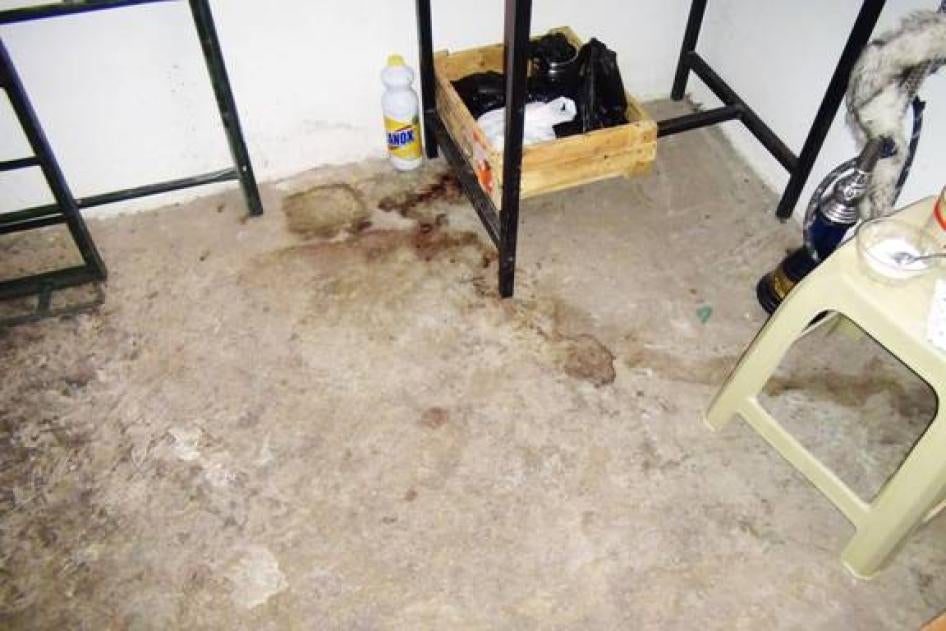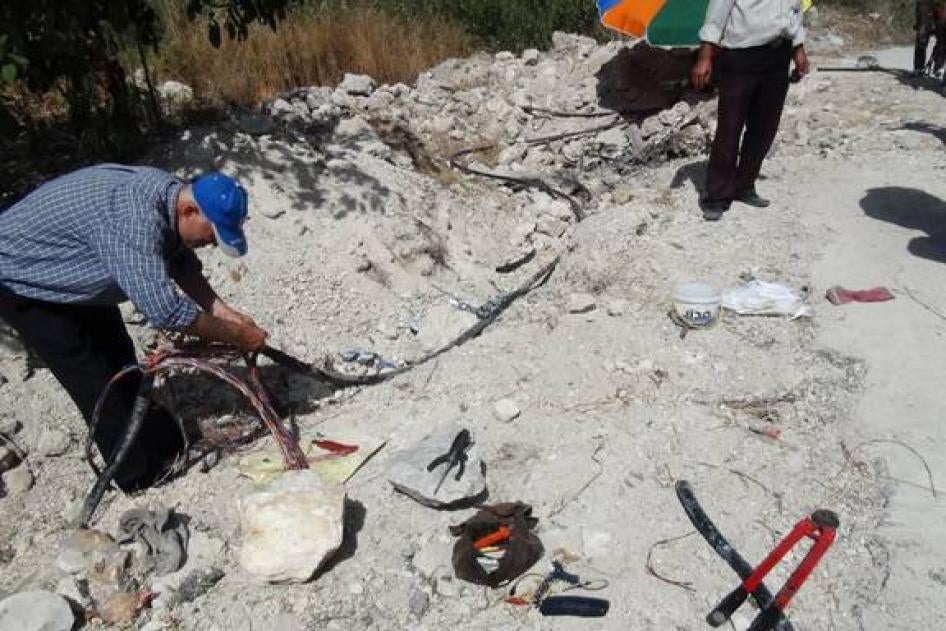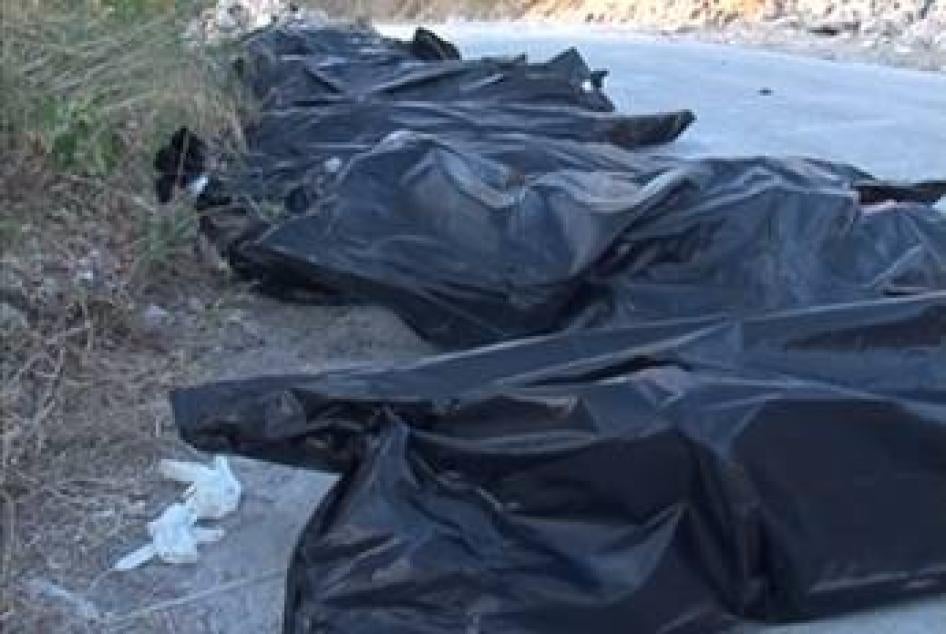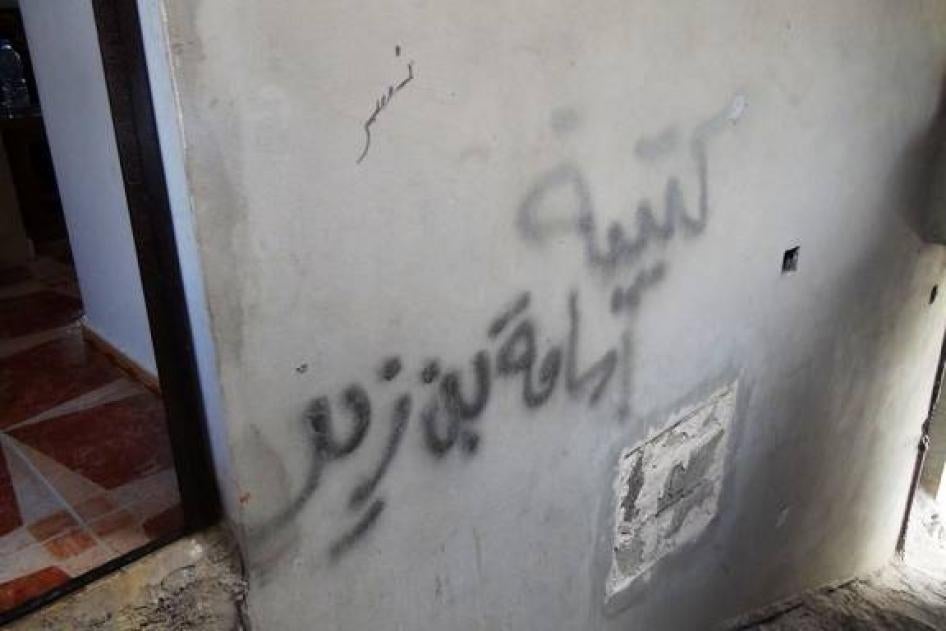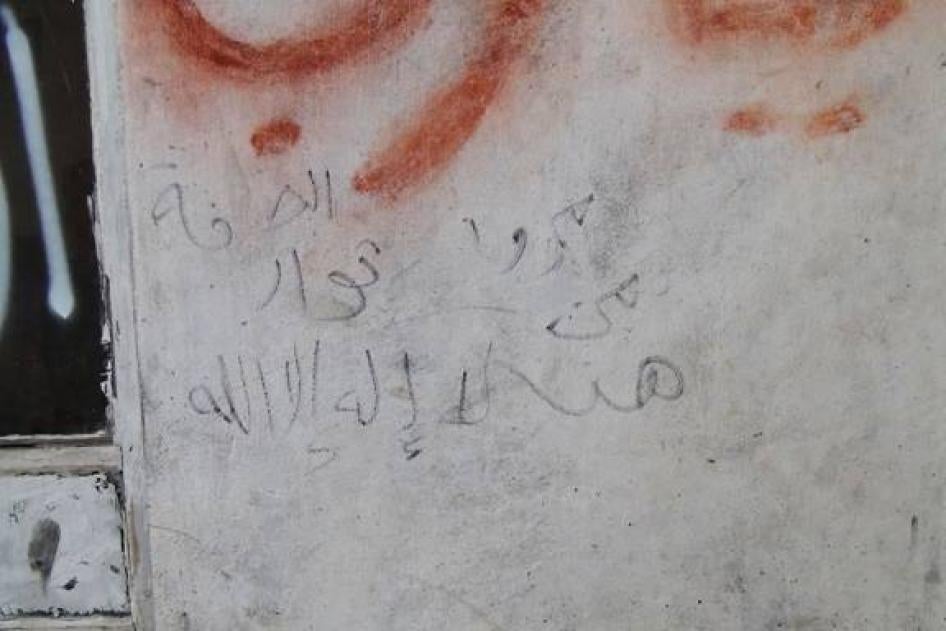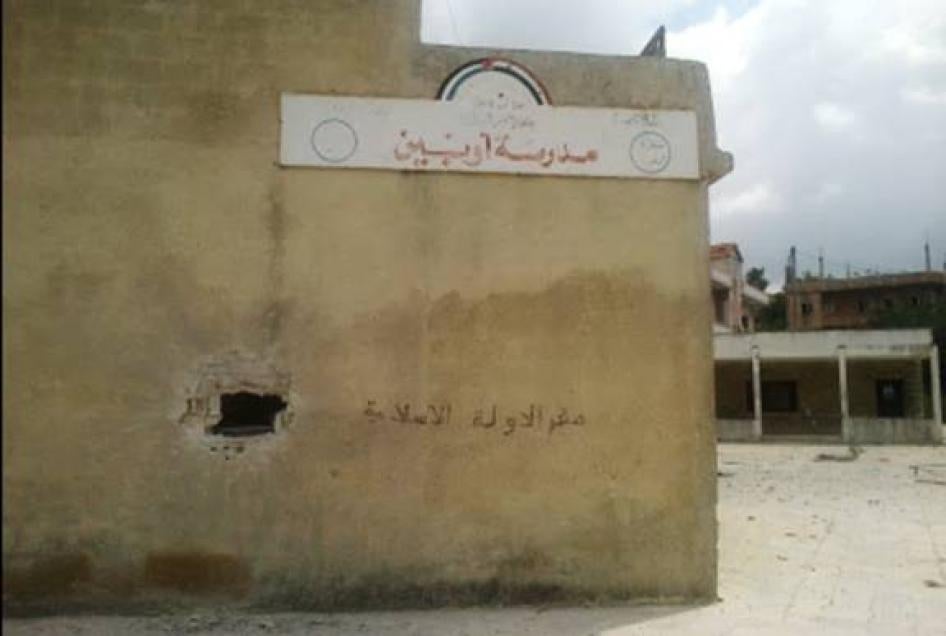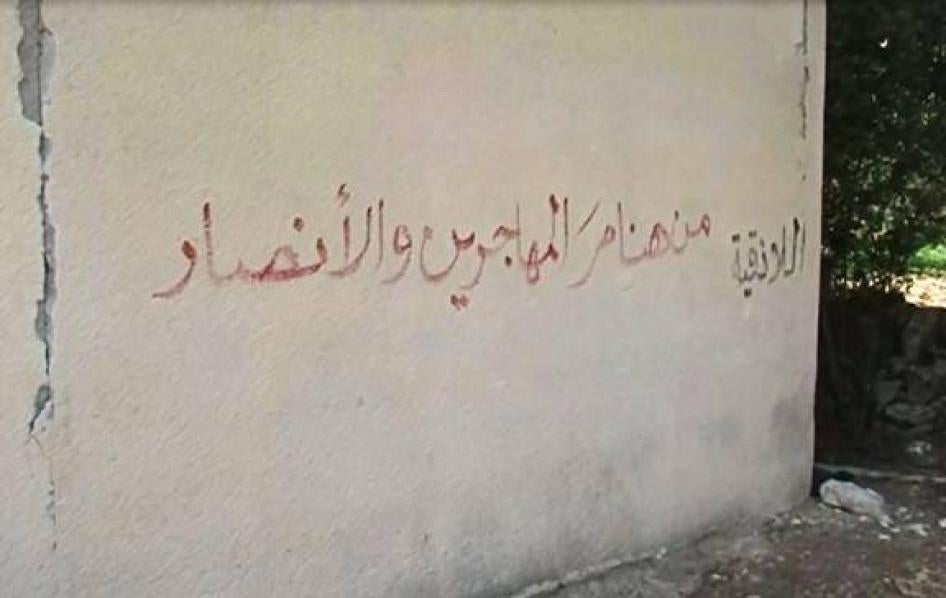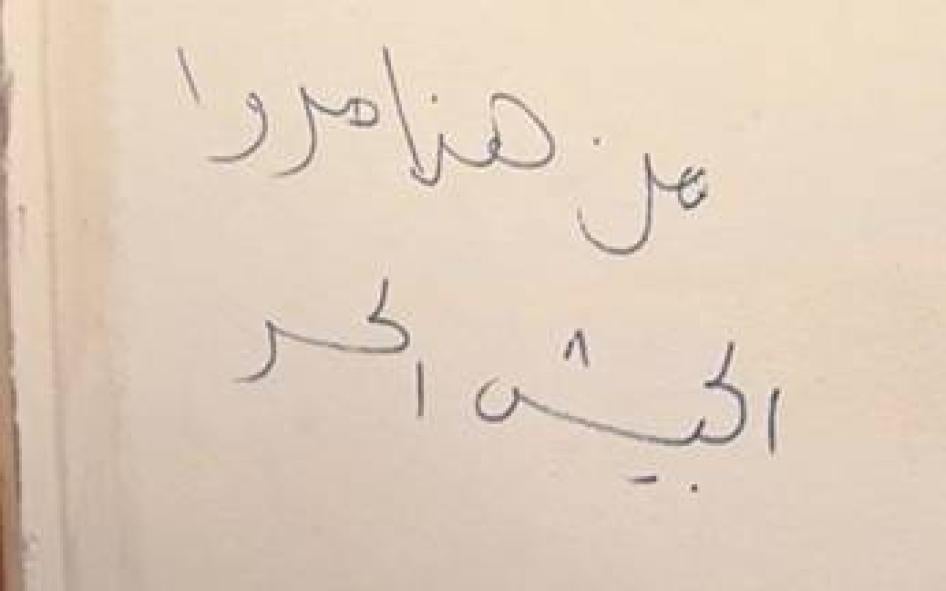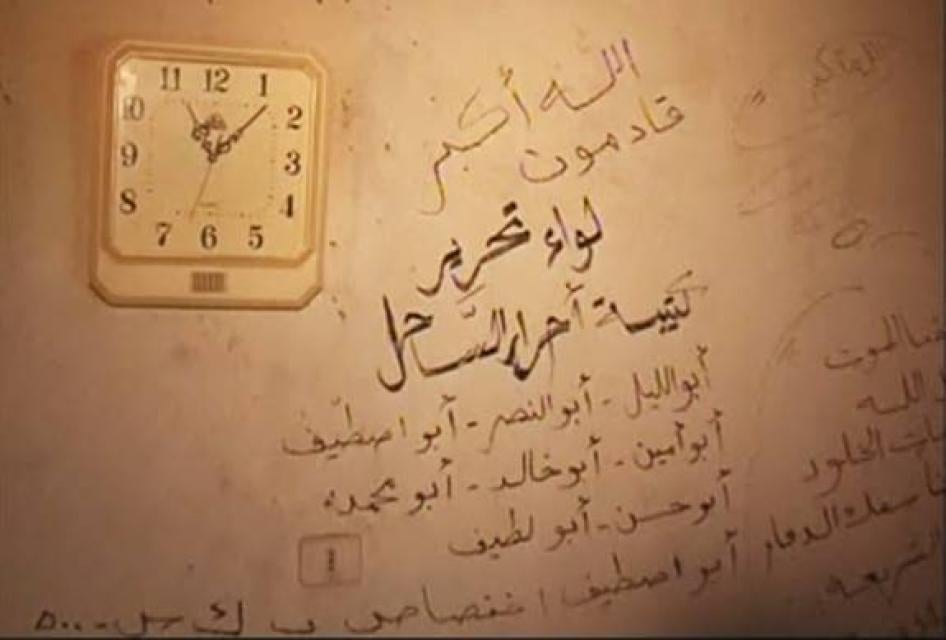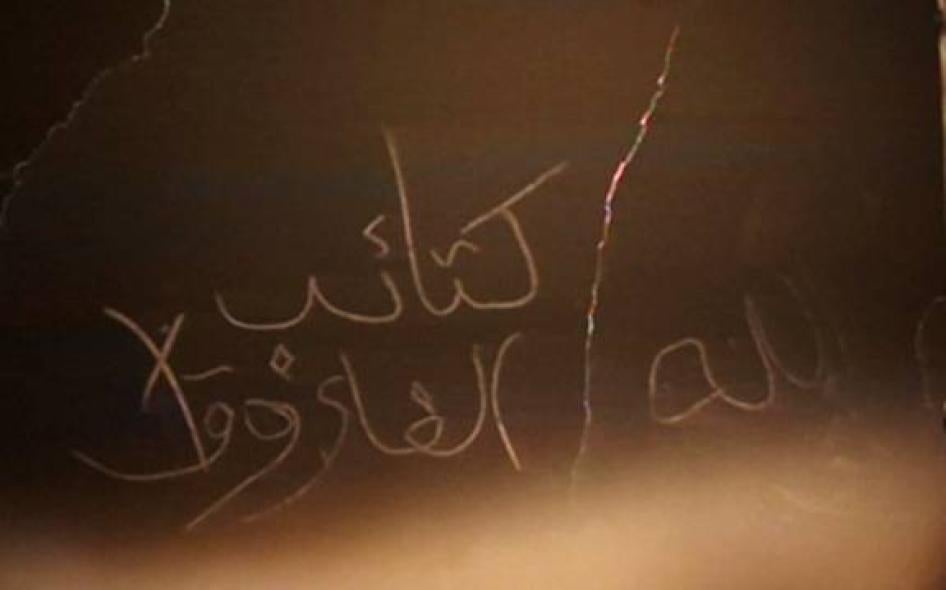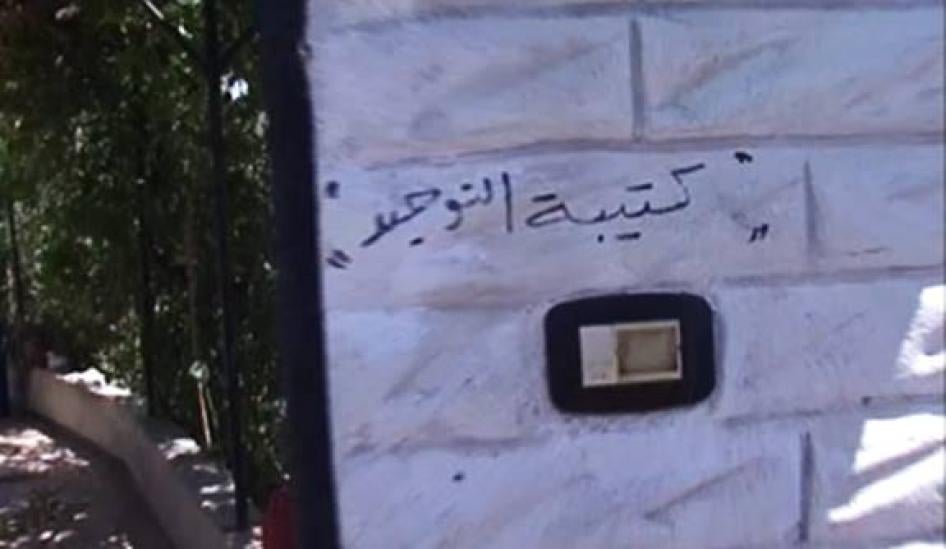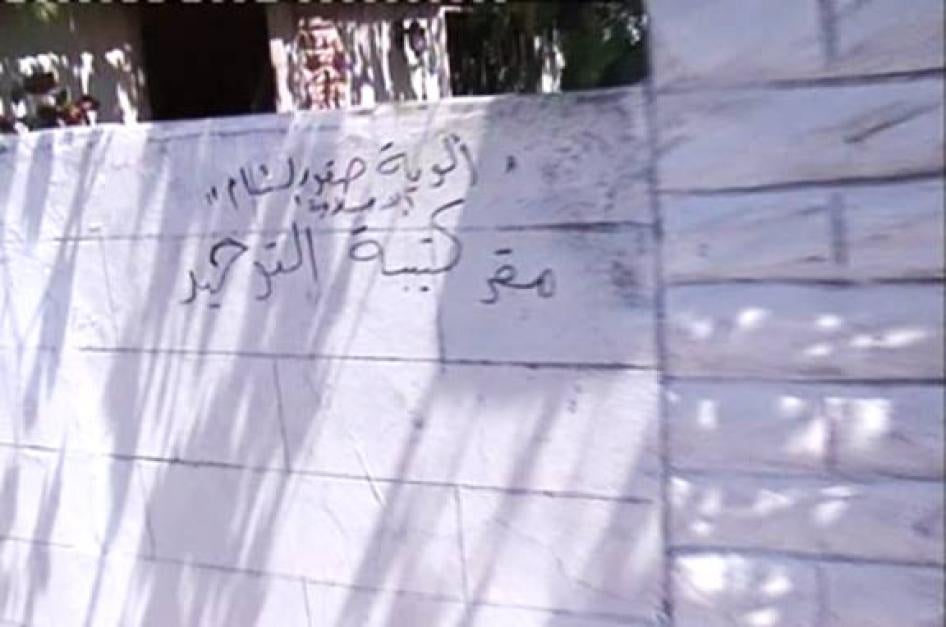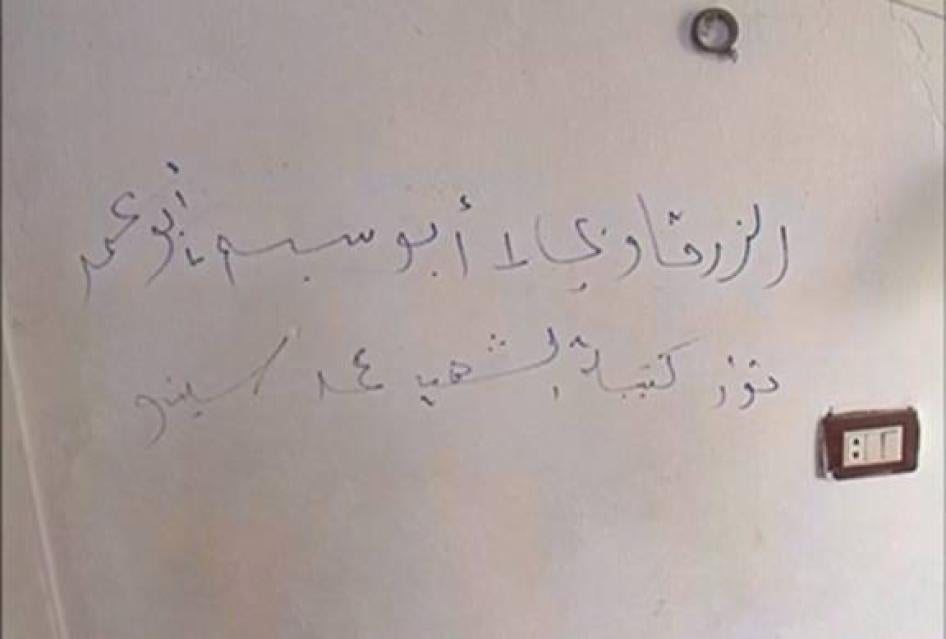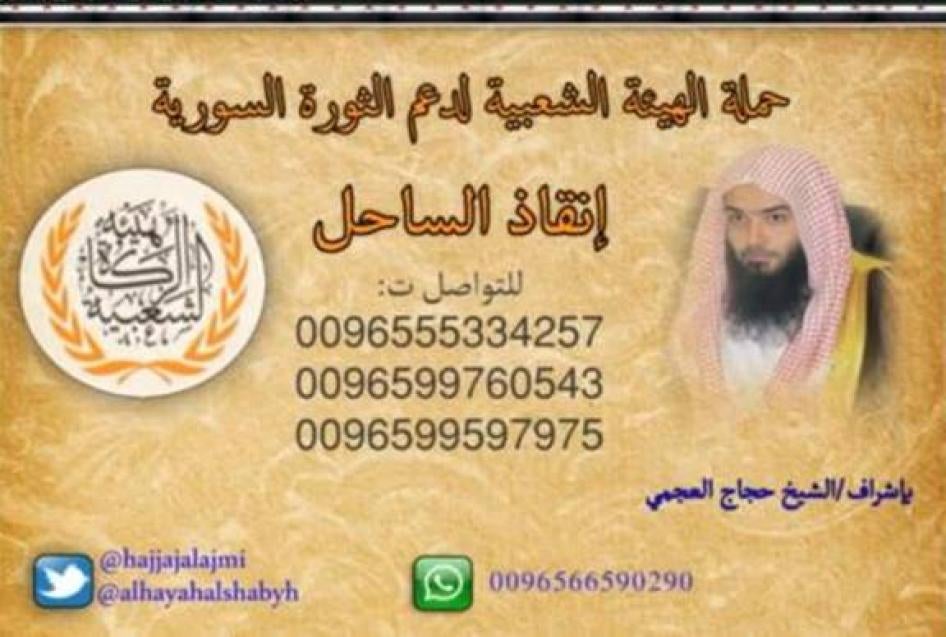Summary
On August 4, 2013, on the first day of the Muslim Eid al-Fitr holiday which marks the end of Ramadan, fighters from several different armed opposition groups launched a large scale offensive in Latakia countryside. Between 4:30 a.m. and 5:00 a.m., the opposition fighters attacked and overran the government army positions guarding the area and in the following hours entered into and occupied more than 10 Alawite villages. The government launched an offensive to retake the area on August 5 ultimately regaining full control on August 18.
This report documents serious abuses committed by opposition forces on August 4 during their attack on the villages. Eight survivors and witnesses described how opposition forces executed residents and opened fire on civilians, sometimes killing or attempting to kill entire families who were either in their homes unarmed or fleeing from the attack, and at other times killing adult male family members, and holding the female relatives and children hostage. At the time of writing, according to opposition sources, over 200 civilians, the vast majority of whom are women and children, continue to be held by the Islamic State of Iraq and Sham (ISIS) and Jaish al-Muhajireen wal-Ansar, groups that led the opposition offensive.
Human Rights Watch visited five of the villages after the government retook control and conducted an in-depth investigation into the events of August 4, 2013 and their aftermath. Human Rights Watch interviewed 19 residents present during the operation including 3 wounded during the attack. We also interviewed three additional relatives of missing or killed people, as well as six Syrian security, army, and militia force members who participated in the fighting, three medical and emergency response staff, an activist from Latakia city, and an opposition member who is not a fighter but who was present during the operation. In addition we interviewed two armed opposition leaders who did not participate in the fighting, an international humanitarian worker with knowledge of the opposition groups who participated in the operation, and a western diplomat with knowledge of the use of Turkish territory by opposition fighters. We corroborated much of the information gathered from witnesses through our own onsite investigation on September 7-8 and by analyzing photos and video footage of the events and their aftermath.
Human Rights Watch has collected the names of 190 civilians who were killed by opposition forces in their offensive on the villages, including 57 women and at least 18 children and 14 elderly men (see Annex 1 for list of victims). The evidence collected strongly suggests they were killed on the first day of the operation, August 4. We identified these individuals as civilians through interviews, video and photographic evidence, or a review of hospital records. Given that many residents remain missing, and opposition fighters buried many bodies in mass graves, the total number of dead is likely higher.
Human Rights Watch has documented that opposition forces executed or unlawfully killed at least 67 of these 190 civilians even though they were unarmed and trying to flee. The evidence gathered by Human Rights Watch indicates that all those unlawfully killed were civilian non-combatants. There is no evidence that they could have posed, or could have been perceived to pose, any threat to the fighters.
For the rest of these killed, further investigation is required to assess the precise circumstances of the residents’ deaths and whether or not the deaths were the result of unlawful killings. However the high civilian death toll, the nature of the recorded wounds, for example multiple gunshot or stabbing wounds, and the presence of 43 women, children, and elderly among the dead all indicate that most of these individuals were either intentionally or indiscriminately killed by opposition forces.
According to local residents and a Military Intelligence officer serving in the area, at the start of their attack opposition fighters entered the Sheikh Nabhan area of Barouda where government soldiers were positioned in the early hours of August 4, 2013. According to an army soldier who was stationed there, the opposition fighters overran the government position and two neighboring bases protecting the area, killing approximately 30 soldiers and wounding many more. The opposition fighters then entered the villages of Barouda, Nbeiteh, al-Hamboushieh, Blouta, Abu Makkeh, Beyt Shakouhi, Aramo, Bremseh, Esterbeh, Obeen, and Kharata. In the following days, opposition fighters also gained control of Qal’ah, Talla, and Kafraya.
Fourteen residents from eight of these villages told Human Rights Watch that they awoke to the sounds of gun and mortar fire and the voices of incoming opposition fighters on August 4. They described frantically attempting to flee as opposition fighters stormed the area, opening fire apparently indiscriminately, and in some case deliberately shooting at them while they tried to flee. Many of those who were unable to flee were killed or taken hostage.
The residents and members of the Syrian government security forces whom Human Rights Watch interviewed all said that on August 4 there were no government forces or pro-government militias in the town once opposition forces had overrun the military positions. Only one resident told Human Rights Watch that he had a firearm in his home that he used to protect himself. An activist from Latakia city who was collecting information about the attack, but was not present during the offensive, also told Human Rights Watch that, according to information she gathered about the operation from locals, four residents who were killed had tried to defend themselves with hunting rifles or other personal weapons. A resident who was present during the attack also said that his father, who stayed behind at home with a hunting rifle, was also killed. All of the other residents indicated that they and their neighbors were not armed, and that despite this, they were targeted by opposition fighters.
In some cases families in their entirety were executed or gunned down by opposition fighters, in others, surviving family members had to flee leaving loved ones behind. One resident in the hamlet between the villages of Blouta and al-Hamboushieh described how he was able to flee his home with his mother as fighters entered his neighborhood but that he had to leave his elderly father and blind aunt behind in their house because of their physical infirmness. He said that when he returned to the hamlet after the government retook the area he found that his father and aunt had been killed:
My mom was here in the house with me. She came out of the house first, and I was behind her. We saw the three fighters just in front of us, and then we fled on foot down behind the house and into the valley. The three fighters that I saw were all dressed in black. They were shooting at us from two different directions. They had machine guns and were using snipers. My older brother came down and hid with us as well. We hid, but my dad stayed in the house. He was killed in his bed. My aunt, she is an 80 year old blind woman, was also killed in her room. Her name is Nassiba.
Fourteen residents and first responders told Human Rights Watch that they witnessed executions or saw bodies that bore signs of execution after opposition forces were pushed out of the area on August 18 by government forces, including in some cases corpses that were bound, and bodies that had been decapitated. A doctor working in the National Hospital in Latakia who was receiving the dead and wounded from Latakia countryside told Human Rights Watch that they had received 205 corpses of civilians killed during the August 4-August 18 operation. The doctor showed Human Rights Watch a medical report the hospital prepared on August 26 stating that the, “[c ]ause of death in several of them [the bodies] was multiple gunshot wounds all over the bodies, in addition to stab wounds made with a sharp instrument, given the decapitation observed in most bodies…Some corpses were found in a state of complete charring, and others had their feet tied…” The medical report reflected that the amount of decay the corpses received by the hospital after opposition forces left the area exhibited was consistent with having been killed around August 4. An opposition activist who was present in the affected villages during the operation told Human Rights Watch on the night of August 4 that on that day there were “160 or 200 Alawite dead.”
In a number of cases, on August 4 opposition forces killed adult male villagers and held their female relatives and children hostage. According to opposition sources, they are still holding over 200 civilian hostages at this writing. Several residents from Latakia countryside told Human Rights Watch that they saw their relatives in the background of a video published on YouTube on September 7 in which civilians from the area being held hostage by Abu Suhaib, the Libyan local leader of Jaish al-Muhajireen wal-Ansar, are shown.
Some of the opposition abuses had clear sectarian motivations. For example, in Barouda opposition fighters intentionally damaged an Alawite maqam (a site where a religious figure is buried) and appear to have intentionally damaged and dug up the grave of the religious figure buried there as well. On August 4 opposition fighters also abducted and later executed Sheikh Bader Ghazzal, the local Alawite religious authority in Barouda who presided over the maqam. According to Jabhat al-Nusra, the opposition group that executed him, the sheikh, who was a relative of Fadl Ghazzal, an advisor to the former Syrian president, Hafez al-Assad, was killed because of his support for the Syrian government.
The investigation found that at least 20 distinct armed opposition groups participated in the operation they termed the “Campaign of the Descendants of Aisha the Mother of Believers,” the “Barouda Offensive,” or the “Operation to Liberate the Coast,” which lasted from August 4-August 18. It is not clear however whether all or most of these groups were present in the villages on August 4 when the evidence Human Rights Watch has collected suggests the vast majority of the abuses took place. Five groups however, who were the key fundraisers, organizers, planners, and executors of the attacks were clearly present from the outset of the operation on August 4. These are:
- Ahrar al-Sham
- Islamic State of Iraq and Sham
- Jabhat al-Nusra
- Jaish al-Muhajireen wal-Ansar
- Suquor al-Izz
Human Rights Watch also has evidence, collected through interviews, an onsite investigation, and a review of opposition statements and videos, linking all five to specific incidents that amount to war crimes.
Sheikh Saqr, the leader of Suquor al-Izz, seems to identify himself on what is believed to be his Twitter account as the person responsible for the finances for the operation and that Abu Taha from Ahrar al-Sham was his deputy in this regard. The operation was reportedly largely financed by private Gulf based donors.
In the case of the other groups who participated in the operation, the extent of their involvement in fundraising, planning, and leading it, and direct participation in abuses is not clear. It is also unclear whether their fighters were present and involved in the operation on August 4, the date when Human Rights Watch believes the abuses took place.
One of these groups is the Supreme Military Council of the Free Syrian Army which is led by Salim Idriss, the Chief of Staff. Several statements from Idriss, days after the beginning of the operation, indicate that fighters under his command were participating in it days after August 4.
International human rights law unequivocally prohibits summary and extrajudicial executions. In situations of armed conflict in which international humanitarian law applies, deliberately killing civilians and injured, surrendered, or captured soldiers (those hors de combat) would constitute a war crime.
The evidence collected by Human Rights Watch strongly suggests that the serious abuses carried out by the opposition groups on August 4 were not the actions of a group of rogue fighters. The coordinated nature of the overall operation in which at least 20 distinct groups participated and the number of villages affected, in combination with the organized manner in which they carried out the crimes on August 4—the simultaneous arrival of fighters that surrounded the villages, the systematic killing of entire families or killing of adult male relatives and holding women and children as hostages, and the statements from fighters and others who are holding these civilians hostage regarding their intentions to exchange them for detainees held by the government—suggests that the crimes were premeditated and organized.
The evidence gathered by Human Rights Watch strongly suggests that the killings, hostage taking, and other abuses committed by the opposition forces on August 4 rise to the level of crimes against humanity. The scale and organization of these crimes indicate that they were systematic as well as being planned as part of an attack on a civilian population.
The local commanders of Ahrar al-Sham, Islamic State of Iraq and Sham, Jabhat al-Nusra, Jaish al-Muhajireen wal-Ansar, andSuquor al-Izz who led the operation may bear responsibility for the killings, hostage taking, and other abuses described in this report. The senior leaders of these groups may also bear responsibility for these abuses. For both war crimes and crimes against humanity, the principle of “command responsibility” applies to military commanders and others in position of authority who may be criminally liable for crimes committed by forces under their effective command and control. This covers situations when they knew or should have known of crimes being committed by their subordinates and failed to prevent the crimes or hand over those responsible for prosecution. In addition, fighters from these and other groups who directly ordered or perpetrated abuses, should be held criminally accountable for their actions.
All concerned governments with influence over these armed opposition groups should press them to end deliberate, indiscriminate, and disproportionate strikes and other attacks on civilians. In addition, all governments, companies, and individuals should immediately stop selling or supplying weapons, ammunition, materiel, and funds to these groups, given compelling evidence that they have committed crimes against humanity, until they stop committing these crimes and perpetrators are fully and appropriately held to account. Arms sales and military assistance to the groups may make the individuals supplying them complicit in crimes they commit.
Governments should also not permit the use of their national territory for the shipment to these groups of arms, ammunition, and other materiel. Given that most foreign fighters in these groups reportedly gain access to Syria via Turkey, from which they also smuggle their weapons, obtain money and other supplies, and retreat to for medical treatment, Turkey should increase border patrols, restrict entry of fighters and arm flows to groups credibly found to be implicated in systematic human rights violations. Under the principle of universal jurisdiction and in accordance with national laws Turkey should also investigate and prosecute those in Turkey suspected of committing, being complicit in, or having command responsibility for international crimes.
The UN Security Council and Turkey’s allies should call on Turkey in particular to do more to verify that no arms are passing through Turkey to these groups.
Human Rights Watch has previously documented and condemned executions carried out by opposition fighters in areas under their control in Homs and Aleppo governorates. Human Rights Watch has also documented and condemned summary and extrajudicial executions by government and pro-government forces following ground operations in many parts of Syria, including in Daraya, a suburb of Damascus, Tartous, Homs and Idlib governorates.
Human Rights Watch has long called on the UN Security Council to sanction individuals credibly implicated in serious human rights violations and to take up the issue of accountability for these crimes by referring the situation in Syria to the International Criminal Court (ICC).
Recommendations
To Armed Opposition Groups
- Immediately stop indiscriminate attacks and targeted attacks against civilians including summary and extrajudicial executions;
- Immediately release civilian hostages and ensure that while they are held, hostages are not mistreated;
- Suspend members against whom there are credible allegations of human rights abuses;
- Cease cooperation and coordination with groups credibly found to systematically perpetrate abuses against the civilian population;
- Publicly condemn targeted attacks against the civilian population and indiscriminate attacks by opposition forces.
To the Syrian Opposition Coalition
- Cease cooperation and coordination with and support to armed groups credibly found to perpetrate systematic abuses against the civilian population; and in particular Ahrar al-Sham, Islamic State of Iraq and Sham, Jabhat al-Nusra, Jaish al-Muhajireen wal-Ansar, and Suquor al-Izz;
- Publicly condemn these and other targeted and indiscriminate attacks by opposition forces against the civilian population;
- Publicly call on opposition groups to release civilian hostages in their custody;
To the Syrian government
- Provide immediate and unhindered access and cooperation to all of Syria to the UN special rapporteur on extrajudicial, summary or arbitrary executions; the Office of the High Commissioner for Human Rights; and the UN Human Rights Council Commission of Inquiry on Syria.
To the UN Security Council
- Refer the situation in Syria to the International Criminal Court (ICC);
- Adopt targeted sanctions on commanders from all sides whose fighters are shown to be implicated in the most serious abuses or who are themselves responsible for serious abuses;
- Require states to suspend all military sales and assistance, including technical training and services, to all forces credibly implicated in the commission of serious human rights violations in Syria including the Syrian government and Ahrar al-Sham, Islamic State of Iraq and Sham, Jabhat al-Nusra, Jaish al-Muhajireen wal-Ansar, and Suquor al-Izz, given the real risk that the weapons and technology will be used in the commission of serious human rights violations until such time as they stop committing these crimes and perpetrators are fully and appropriately held to account;
- Demand that the Syrian government and opposition groups cooperate fully with the UN Human Rights Council Commission of Inquiry, including by giving it unrestricted access;
- Demand safe and unimpeded access anywhere in Syria for independent human rights organizations.
To the Government of Turkey
- Under the principle of universal jurisdiction and in accordance with treaty obligations and national laws, investigate and prosecute members of the armed groups suspected of committing, being complicit in or having command responsibility for international crimes in Latakia countryside or elsewhere in Syria that enter into Turkey;
- Through increased border patrols, restrict entry of fighters and arm flows to groups credibly implicated in systematic human rights violations;
- Use any influence over armed opposition groups that hold civilian hostages to release those hostages.
To Gulf States
- Publicly condemn abuses committed by opposition groupsand deny any military support to Ahrar al-Sham, Islamic State of Iraq and Sham, Jabhat al-Nusra, Jaish al-Muhajireen wal-Ansar,and Suquor al-Izz;
- Through increased monitoring, restrict money transfers from Gulf residents to groups credibly implicated in systematic human rights abuses;
- Investigate and prosecute individuals in the Gulf found to provide support to groups committing systematic human rights violations in Syria;
- Use any influence over armed opposition groups that hold civilian hostages to release those hostages.
To All Countries
- Acting individually or jointly through regional mechanisms where appropriate, adopt targeted sanctions against leaders credibly implicated in the serious violations of international human rights law in Syria, including in Latakia countryside;
- Under the principle of universal jurisdiction and in accordance with national laws, investigate and prosecute members of armed forces suspected of committing, being complicit in or having command responsibility for international crimes in Syria including in Latakia countryside;
- Call on the UN Security Council to refer the situation in Syria to the ICC, as the forum most capable of effectively investigating and prosecuting those bearing the greatest responsibility for abuses in Syria.
Methodology
This report is based on a field investigation in September 2013 by a Human Rights Watch researcher to Latakia and its countryside. Human Rights Watch visited five of the villages—Barouda, Blouta, Abu Makkeh, Esterbeh, and Qal’ah—that the opposition fighters attacked during the operation. Human Rights Watch requested and received permission from the Syrian government to operate officially in the country for the purpose of conducting this investigation.
While in Latakia governorate Human Rights Watch met with the head of the Syrian government’s Military Intelligence security branch in Latakia city to obtain permission to operate in Latakia countryside and with a Military Intelligence officer in Latakia countryside whom he assigned to ensure our staff’s security while operating in the area. Security personnel did not limit the movements of our staff beyond indicating which areas remained subject to heavy fighting, and did not restrict who researchers spoke to in the areas visited. Government officials were not present during interviews with residents.
During the mission Human Rights Watch interviewed in person 29 individuals. Of these 19 were residents present during the operation including 3 wounded during the attack. We also interviewed two relatives of missing and killed people, six Syrian security, army, and militia force members who participated in the effort to retake the area, and three medical and emergency response staff. Human Rights Watch also interviewed by phone, Skype or email an activist from Latakia city, and two residents from the affected villages. On the opposition side a Human Rights Watch consultant interviewed an opposition member who is not a fighter but who was present in the villages during the opposition offensive as well as evacuated fighters who were wounded, and two armed opposition leaders who did not participate in the fighting. We also interviewed a foreign humanitarian worker working in Turkey who had detailed information on the attacks and a western diplomat with knowledge of the use of Turkish territory by opposition fighters. We corroborated much of the information gathered from witnesses through our own onsite investigation as well as though analysis of photos, video footage, and other publically available information about the operation.
All interviews were conducted in Arabic. Human Rights Watch explained the purpose of the interviews to interviewees and obtained their consent to use the information they provided in this report.
With their permission, Human Rights Watch has identified some interviewees by name where we have assessed that doing so would not expose them to any additional risk. In other cases where interviewees asked to not be named or Human Rights Watch assessed that naming them would jeopardize their security, Human Rights Watch has not named them.
In addition, Human Rights Watch obtained hospital records from the staff at the Latakia National Hospital in Latakia city which received the wounded and dead from the August 4 opposition offensive including a medical report analyzing the cause and time of death, a list of fatalities, and photographs of deceased residents killed in the attack taken at the hospital.
Human Rights Watch reviewed approximately 200 videos posted on YouTube by opposition activists and fighters before, during, and in the immediate aftermath of the attack on the villages. We also reviewed photographs and footage filmed by local residents, Syrian security members, media outlets close to the Syrian government, and footage, including of mass graves and destruction of the villages that the Syrian Ministry of Health shared with us.
Information about which opposition groups were involved in the operation, and to what extent, was gathered primarily through our onsite investigation, in particular identification of graffiti tags left by the groups, an interview with an opposition member who is not a fighter but who was present during the fighting and was evacuating the wounded, interviews with two armed opposition leaders who did not participate in the fighting, a review of public statements made by the opposition groups and their purported financial supporters in videos and on social media sites, including statements identifying fighters killed in the operation and the groups to which they belonged, and a review of other publicly available sources including media reports.
I. Background: Opposition Offensive in Latakia Countryside
Northern Latakia countryside, home to members of Syria’s religious minority communities and Sunni Syrians, has been the site of months’ long battles between the Syrian government and armed opposition forces. Starting in 2012 opposition forces took control of towns and villages in the northeastern parts of the governorate in both the Jabal Turkman and Jabal Akrad areas advancing in June 2012 to the town of Salma and the neighboring Jabal Doreen, a strategic military point that overlooks government held areas.
During a visit to some of the opposition held areas in Northern Latakia in late December 2012, Human Rights Watch observed that residents from Alawite villages, such as al-Nassra, that had fallen to the opposition, had largely fled. According to opposition activists, Alawite residents also fled from these other Alawite villages in Northern Latakia as the opposition approached: Kindisiya, Zraro, Beyt Sweiha, Jurat al-Mai, Ayn Aghazal, and Mazraa. Opposition fighters and residents from some of these villages told Human Rights Watch that those who left withdrew with Syrian government forces when they retreated from the areas. Human Rights Watch also observed in December 2012 that the Shia population of Zarzour, a predominately Sunni village, also fled fearing attacks by the armed opposition groups and that Christian villages in the area including Ghasaniyeh and Jdeideh were largely abandoned by residents when opposition fighters came in. In Zarzour, Ghasaniyeh, and Jdeideh villages, opposition fighters damaged and looted the Shia and Christian religious sites after taking control of them.[1]
On August 4, 2013 between 4:30 a.m. and 5 a.m., armed opposition groups launched a new and large scale offensive on government controlled areas in Latakia countryside, according to 16 witnesses, including a government soldier and a Military Intelligence officer who were present that day.
The opposition fighters first attacked the three government bases in the area.[2] A Military Intelligence officer serving in the area at the time said that the opposition fighters first attacked the Sheikh Nabhan military position in Barouda village.[3] He said that there, with the help of two army soldiers who defected, opposition fighters overran the army position, capturing two tanks, and successfully weakening government forces leaving them incapable of defending against the opposition’s offensive on Barouda and nearby villages. An opposition activist who was present in the affected villages during the operation told Human Rights Watch that the attack was facilitated by a suicide bomber who attacked the tank unit.[4] However, the Military Intelligence officer who spoke to Human Rights Watch, a military intelligence member, and a soldier present at Sheikh Nabhan military position reported that two defected soldiers were the ones that facilitated the operation and denied that there was a suicide bomb attack on August 4.[5] According to the soldier:
There were 40 people in our group…We had two tanks at Sheikh Nabhan…We knew that something was coming and we were preparing for it. It was 4 a.m. They surrounded the villages and started hitting us with rockets and mortars…from Salma and Doreen…They would shoot six rockets in a matter of seconds and would land all in one place…They hit and we returned fire…The attack was at sunrise. At that time we are facing the sun, so we couldn’t really see and were at a disadvantage. We were like this for less than an hour hitting back and forth…When the fighters got into the area, then two of our soldiers shot at us from behind. They were hitting us from both sides…They were 50 meters to 100 meters behind us…I was at my station at the tank with seven others protecting the tank…I saw them approach between the trees. There must have been hundreds of them. They had a Jabhat al-Nusra black flag with them. Some were wearing camouflage and many were dressed in black. Some were wearing Shalwar Kameez with vests. Some had long beards.[6]
The soldier told Human Rights Watch that after about 40 minutes opposition fighters penetrated the military position. He said that opposition fighters quickly overwhelmed him and the other soldiers and forced them to retreat. “We were just 10 in the end,” he said. “Some were injured, [including me] and we had to withdraw. We fled toward Barouda, down the hill, and hid.”[7]
According to the Military Intelligence officer and the soldier, opposition forces killed approximately 30 soldiers during the fighting, and wounded many more, out of the 100 to 110 soldiers from this and two neighboring positions protecting the area.[8] The opposition also lost fighters in the battle. According to the opposition activist who assisted in evacuating the dead and wounded, the opposition lost 25 fighters in the offensive on August 4.[9]
The residents and Syrian government security force members that Human Rights Watch interviewed all said that government forces were only based in three government positions outside the villages and that once these bases were overrun on August 4 and the soldiers had retreated there were no government forces or pro-government militias inside the villages on that day.
The member of the Military Intelligence security branch that spoke to Human Rights Watch said that after opposition fighters entered the Sheikh Nabhan base on August 4 they pushed their offensive on the small Alawite farming villages of Barouda, Nbeiteh, al-Hamboushieh, Blouta, Abu Makkeh, Aramo, Bremseh, Esterbeh, Obeen, and Kharata which they took later that day.[10] According to witnesses, videos, and photographic evidence, opposition fighters also entered the village of Beyt Shakouhi on August 4 and Qal’ah, Talla, and Kafraya in the following days.
The villages, which neighbor one another, are all in the Slanfeh sub-district of the Haffeh district in Latakia governorate. They fall approximately 50 kilometers to the east of Latakia city. According to the 2004 census, the population of the town of Slanfeh and the surrounding 25 villages in the sub-district was under 20,000.[11]
The Military Intelligence officer who spoke to Human Rights Watch said that the opposition fighters that entered the villages had snipers with them and attacked with cannons, mortars, multiple rocket launchers including grad rockets, Shilkas (armored vehicles that have antiaircraft cannons as their main armament), DShKs (heavy machine guns, typically seen mounted on the turret of a tank), and the tanks they had captured, in addition to small arms. He estimated that thousands of opposition fighters were involved in the attack.[12]
Opposition groups announced the offensive on various websites, in some cases even before the operation began. Multiple names were used for the offensive including the “Campaign of the Descendants of Aisha the Mother of Believers,” the “Barouda Offensive,” and the “Operation to Liberate the Coast” (herein after Operation to Liberate the Coast).[13]
The Military Intelligence officer who spoke to Human Rights
Watch said the government began its operation to push back the fighters on
August 5.[14] Army,
Military Intelligence, and members of the National Defense Forces participated
in the operation according to members of those units.[15]
On August 7 SANA, the Syrian
official news agency, reported that the army had regained control of the villages of
Aramo, Esterbeh, Talla, Beyt Shakouhi and Kafraya on August 6, and that they
had destroyed a Jabhat al-Nusra encampment in Obeen village.[16]The pro-government website Syria News reported
on August 19 that on that day Syrian forces regained control over all of the
villages taken by the opposition during the August 4 campaign.[17]The Military Intelligence officer and a member
of the National Defense Forces who took part in the fight said the government
regained complete control of the affected villages on August 18.[18]
The member of the National Defense Forces told Human Rights Watch that
170 fighters from the National Defense Forces were involved in the battle, and that 44 of them were killed in the fighting.[19]
At the time of writing, the government was still in control of the affected villages. Many surviving residents had not returned to their villages, they said, in some cases because their homes were damaged, from fear, trauma, and because some areas remained susceptible to sniper and mortar fire from opposition positions including Salma and Jabal Doreen. Government forces were still conducting air and artillery strikes against these and other opposition positions from the area.
II. Killings in Latakia Countryside
Executions and Other Unlawful Killings of Civilians
Fourteen residents of Barouda, Nbeiteh, al-Hamboushieh, Blouta, Abu Makkeh, Bremseh, Qal’ah and Talla villages told Human Rights Watch that in the early hours of August 4, just after the Muslim morning prayer that they awoke to the sounds of gun and mortar fire and the voices of incoming opposition fighters. At least eight of the residents from five of the villages— Barouda, Blouta, Nbeiteh, al-Hamboushieh, and Abu Makkeh—told Human Rights Watch that after opposition fighters entered their villages that they and others were shot at while trying to flee despite being unarmed.
The residents and Syrian government security force members whom Human Rights Watch interviewed all said that government forces were only based in three government positions outside the villages and that once these bases were overrun on August 4 there were no government forces or pro-government militias inside the villages on that day. Only one resident told Human Rights Watch that he used a firearm to protect himself.[20] An activist from Latakia city who was collecting information about the attack, but was not present during the offensive, told Human Rights Watch that, according to information she gathered about the operation from locals, three of the residents who were killed used hunting rifles or other personal weapons in an effort to defend themselves.[21] A resident who was present during the attack also said that his father, who stayed behind at home with a hunting rifle, was also killed.[22] All of the other residents indicated that they and their neighbors were not armed, and that despite this they were attacked by opposition fighters.
Residents described how opposition forces in some instances killed or attempted to kill entire families who were either in their homes unarmed or fleeing from the attack, and in other cases killed adult male family members and held their female relatives and children hostage (see Section III below).
Human Rights Watch has identified the names of 190 civilians, including 57 women and at least 18 children and 14 elderly men, killed by opposition forces on August 4. We documented this number of dead and assessed that the victims were civilian non-combatants through witness statements, onsite visits to four of the villages, Blouta, Barouda, Esterbeh, and Abu Makkeh, hospital records, and analysis of video and photographic evidence (see Annex 1 for list of victims).
Given that many residents remain missing, and opposition fighters buried many bodies in mass graves, the total number of dead civilians is likely higher. A doctor working in the National Hospital in Latakia who was receiving the dead and wounded from Latakia countryside told Human Rights Watch that they received 205 corpses from the area. She said all 205 were civilians as bodies of dead soldiers were sent to the Military Hospital in Latakia.[23] Syrian military brought 53 of these corpses to the National Hospital in Latakia during the August 4-18 battle, while the remaining 152 were collected from homes, streets, and mass graves in the villages after government and pro-government forces regained control of the area.[24] The hospital has identified by name 147 of the 205 bodies they had received. On August 26, after the hospital already received 192 civilian bodies hospital officials reported that 68 of these were adult males, 58 adult females and 11 children.[25] There were 33 males and 22 female unidentified bodies.[26]
Many of the corpses could not be identified because they were burned, badly disfigured, or had decomposed significantly. There was significant overlap between the names collected by Human Rights Watch and those collected by the hospital. Human Rights Watch identified names in addition to those that appear in the hospital’s list through witness statements.
The doctor and residents who spoke to Human Rights Watch both stated that the opposition fighters had carried out the killings of these civilians on August 4 or shortly thereafter and not during the following government offensive to retake the area. Residents consistently said that residents from the affected villages who were not captured fled the area on August 4. The medical report shared with Human Rights Watch by the doctor reflected that the decay of the corpses received by the hospital after opposition forces were pushed out of the area was consistent with the killings having taken place around August 4.[27] An opposition activist who was present in the affected villages during the operation told also told Human Rights Watch on the night of August 4 that there were “160 or 200 Alawite dead” on that day.[28]
Evidence gathered by Human Rights Watch indicates at least 67 of the 190 civilian deaths we documented were executed or unlawfully killed while unarmed and trying to flee. The evidence indicates that all those unlawfully killed were civilian non-combatants who posed no threat to the fighters.
Fourteen residents and first responders told Human Rights Watch that they witnessed executions or saw corpses that bore signs of execution, including some that were bound, and bodies that had been decapitated.
Further investigation is required to assess the circumstances of the deaths of the remaining 123 civilians, however the large number of deceased civilians, the nature of the recorded wounds, for example multiple gunshot or stabbing wounds, and the presence of 43 women, children, and elderly among them indicate that opposition forces either intentionally or indiscriminately killed these civilians.
The doctor working at the National Hospital in Latakia shared a medical report prepared on August 26 that contained these additional observations:
Cause of death in several of them [the bodies] was multiple gunshot wounds all over the bodies, in addition to stab wounds made with a sharp instrument, given the decapitation observed in most bodies. Time of death is estimated to go back 14-20 days from the date of initial examination, August 19, 2013. Some corpses were identified by their clothing, ID cards and other items found in the victims' clothes. Those who remained unidentified were subjected to DNA sampling for identification, with the exception of some whose extreme decay precluded the measure. Only three skulls were found, and were photographed by Criminal Investigations Dept. agents. Some corpses were found in a state of complete charring, and others had their feet tied.[29]
Unlawful Killings in Barouda
The village of Barouda, along with Nbeiteh and Bremseh, is exposed and particularly vulnerable to sniper and mortar fire from opposition strongholds in Salma and Jabal Doreen. Located near the site of the Sheikh Nabhan military position, Barouda was one of the first villages opposition fighters shelled, encircled, and finally entered on the morning of August 4. Human Rights Watch visited the village on September 8, 2013. Evidence Human Rights Watch gathered by working with survivors, other witnesses, and through onsite investigation, a review of videos, photos, and medical and police records, strongly indicates that at least 13 residents from Barouda were unlawfully killed by opposition fighters on August 4. Human Rights Watch has also received information about the killing of an additional 20 residents, but not enough information to establish the exact circumstances of the killings. Further investigation is required to establish whether these killings were unlawful (see Annex 1 for list of victims). The opposition fighters also attacked a religious Alawite site and abducted Sheikh Bader al-Ghazal, the sheikh of the village who oversaw the site, and later killed him.
Killing of Shebli Family members
Local residents told Human Rights Watch that opposition forces killed multiple members of the Shebli family when they entered the village. Hassan Shebli, a Barouda resident, told Human Rights Watch that opposition forces killed his wife Shamieh Ali Darwish, in her 60s, and his son Safwan Hassan Shebli, 23, in their home.[30] Hassan told Human Rights Watch that he fled his home at around 4:30 a.m. when it appeared opposition fighters were nearing the village, but that he had to leave behind his wife and son who could not flee because of physical disabilities. Safwan, a former soldier, suffered from an illness that left him paralyzed, and his mother was only able to walk with the assistance of crutches. After killing them, opposition fighters buried them behind their house, according to Hassan.
When he returned to his home after government forces pushed opposition forces out of the area, he found new graves had been dug in his backyard and blood spattered in the room where his wife and son slept. He told Human Rights Watch that members of the Civil Defense Forces along with local residents unearthed the bodies later on, and that he identified them as belonging to his wife and son. Human Rights Watch visited Hassan’s house and observed bullet markings and blood splatter that indicated that Safwan was shot while in his bed. There was also a blood stain next to the mother’s bed on the floor, but it was not clear if she had been killed there. As Hassan told Human Rights Watch, “You can still see their blood.”[31]
On August 22, the YouTube channel of Ansar al-Deen, an armed opposition group, posted a video showing Safwan Hassan Shebli in his bed while opposition fighters were still in his home.[32] In the photo, the distinctive photographs on Safwan’s bedframe are visible. Seconds later the videographer cuts to footage of Shamieh Ali Dariwsh with an opposition fighter, while she is still alive.[33] In the video, the elderly woman is seen walking with the assistance of two canes. An activist from Latakia city identified the individuals who appear in the video as Safwan and Shamieh.[34]
While at their home, Human Rights Watch also saw the site of their initial burial, just behind their house.
Screenshot from footage filmed in Barouda on September 8, 2013 of Safwan Shebli’s bed.[35]
Hassan Shebli’s backyard where his son Safwan and wife were buried © 2013 Human Rights Watch
Hassan also showed Human Rights Watch graffiti tags on his home walls apparently left behind by opposition fighters who he believed were responsible for the killings. The graffiti mentions the names of the groups Jabhat al-Nusra and Suquor al-Izz.
Graffiti on an internal wall in the house reads “Jabhat
al-Nusra to bring victory to the people of Syria”
© 2013 Human Rights Watch
Graffiti on an external wall in the backyard reads “God is great Suquor al-Izz” © 2013 Human Rights Watch
Human Rights Watch reviewed eight photographs provided by the Latakia National Hospital of Shamieh Ali Darwish and Safwan Hassan Shebli after they were taken out of their initial grave. Safwan’s body had decayed significantly and his skull clearly shows a large hole where he was likely shot. Shamieh’s body has also decayed significantly.
Hassan told Human Rights Watch that opposition fighters in Barouda also killed his relative Mouneer Salah Shebli, in his 70s, and his wife Samella Ibrahim Badour, in her 60s, on August 4, but did not provide details on the circumstances of their death. Human Rights Watch reviewed two photographs provided by the Latakia National Hospital of Samella Ibrahim Badour’s corpse.
Another resident said that opposition fighters also killed Wassim Shebli, aged 23 or 24.[36] The head of police for the Slanfeh region of Latakia which encompasses the affected areas shared several photos and two videos showing corpses in a group, some of them burnt, in Barouda. The photos show both dead civilians, including children, and combatants.[37] In one of the videos that Human Rights Watch reviewed, a resident identifies one of the killed as “Wassim.”
Screenshot from footage provided by the head of police for the Slanfeh region of Latakia of corpses found in Barouda. The deceased on the left is identified as “Wassim.”[38]
According to the Latakia National Hospital records, the only Wassim killed during the August 4 operation is Wassim Shebli. So while Human Rights Watch cannot confirm with certainty that the corpse in the video footage is that of Wassim Shebli, it is very possible that it is the case. Human Rights Watch has not been able to identify the other deceased that are visible in the videos and photos.
Photo provided by the head of police for the Slanfeh region of Latakia of burnt bodies in Barouda. © 2013 Slanfeh police
Killing of Badour Family members
Ghazi Ibrahim Badour, who is Hassan’s neighbor in Barouda and is related to him through marriage, told Human Rights Watch that opposition groups opened fire on his family when they entered the village on August 4. He said that opposition fighters intentionally opened fire on them as he, his wife, and his 10 children were fleeing their home despite the fact that they were unarmed and running away. Two of his children were killed in the attack.
When the fighting began [at around 4:45 a.m. on August 4] I went to the nearby army checkpoint to see what was going on. They said they [the opposition] were hitting us from Salma. The checkpoint was hitting back. I went back to my house and got my wife and kids. I have 10 kids. They [opposition fighters] cut off the road so we tried to escape through the trees [on foot], but they were shooting at us and two of my daughters died. My wife and another daughter were hurt. My daughter Sefah Badour, who has a masters in Arabic literature and my daughter Sara who has a degree in philosophy were killed. One was shot in the head twice and the other four times in the chest. My wife was hit in her right arm and another one of my daughters in the leg.[39]
Human Rights Watch reviewed 21 photographs provided by the Latakia National Hospital of Sefah and Sara Ghazi Badour’s corpses. The photos show that Sefah was shot in the head and that Sara sustained injuries to the chest and leg.
Ghazi Ibrahim Badour also told Human Rights Watch that he saw a girl from the al-Qusaybeh family lying dead on the street while he was fleeing with his family.[40] He said that her throat was slit.
Killing of Ftaymeh Family members
Based on the evidence collected by Human Rights Watch opposition fighters also killed at least nine members of the Ftaymeh family in Barouda. A member of the National Defense Forces told Human Rights Watch that after they retook the villages on August 18, they located the bodies of Zeina Ftaymeh, her father, and mother, in their home.[41]
According to resident Ghazi Ibrahim Badour, 80 year old Salman Yousef Ftaymeh was also killed, along with his son Bassam Salman Ftaymeh and several other relatives.[42] Human Rights Watch observed graffiti tags that read “Suquor al-Izz” and “the men of the Islamic State passed through here” in Salman Yousef Ftaymeh’s house.
Human Rights Watch reviewed nine photographs of Salman and Bassam’s corpses. Both corpses appear to have been burnt, and a large piece of Salman’s skull is missing, indicating he may have been shot in the head.
According to the Latakia National Hospital records obtained by Human Rights Watch two of Salman’s brothers were also killed during the operation, likely on August 4, and may have also died in Barouda: Mohamed Yousef Ftaymeh and Younes Yousef Ftaymeh.[43] Human Rights Watch reviewed eight photos of their corpses provided by the Latakia National Hospital. Younes’ body had decayed significantly and the cause of death is not apparent in the photos. A large piece of the front of Mohamed’s skull is missing, indicating that he may have been shot in the face.
Killing of al-Qusaybeh Family members
A local resident showed Human Rights Watch a photo of a death announcement that was posted which identified 18 Barouda residents, including eight women and two children, who had been killed there.[44] The announcement indicates that they were killed on August 4 as part of a “collective massacre committed by the armed terrorist groups.” These include, Ahmad Assad al-Qusaybeh, 80, Ali Assad al-Qusaybeh, 70, Sleiman Mustafa al-Qusaybeh, 70, Ghassan Mohamed al-Qusaybeh, 50, Mohamed Maqsoud al-Qusaybeh, 45, Nader Ali al-Qusaybeh, 33, Jassem Mohamed al-Qusaybeh, 40, Narjess Ahmad Al-Qusaybeh, 45, Hamama al-Qusaybeh,70, Ruwaida Yousef al-Qusaybeh, 20, Reem Yousef al-Qusaybeh, 18, Batoul Ghassan al-Qusaybeh, 10, Sondous Ghassan al-Qusaybeh, 18, Waqar Ghassan al-Qusaybeh, 6, Aziza al-Nuwa, 75, Labiba Hameed Deeb,75, Yusra Selman al-Qusaybeh, 36, and Ibrahim Ahmad al-Qusaybeh, 30. The resident identified all of the individuals as civilians. Human Rights Watch was unable to investigate the circumstances of their deaths.
The Killing of Sheikh Bader Ghazzal and Attack on a Religious Site
During its visit to Barouda village on September 8, Human Rights Watch visited a local Alawite maqam, a religious site where a religious figure is buried. The maqam, named after Sheikh Nabhan, a prominent Alawite cleric buried there, was badly damaged after opposition fighters intentionally hit it.[45] In addition, opposition fighters appear to have intentionally desecrated and dug up the sheikh’s grave. The member of the National Defense Forces who spoke to Human Rights Watch also showed us religious books in the maqam that he said were torn up by opposition fighters when they controlled the area.[46]
Screenshot from footage filmed in Barouda on September 8,
2013 of the maqam of Sheikh Nabhan.[47]
© 2013 Human Rights Watch
On August 21, the YouTube channel of Suquor al-Izz, one of the opposition groups that took part in the fighting, published a video with their logo on it in which the intentional destruction of the Maqam is filmed. [48]
Under international humanitarian law, parties in an armed conflict have a responsibility not to intentionally attack religious buildings that are not being used for military purposes. They are prohibited from seizing, destroying, or doing willful damage to religious buildings or institutions and from theft, pillage, or vandalism directed against important cultural property. Deliberate attacks on religious sites that are not military objectives are war crimes.
That same day opposition fighters abducted Sheikh Bader Ghazzal, the sheikh of the village who oversaw the maqam. Sheikh Ghazzal was a relative of F adl Ghazzal, who was an advisor to late Syrian president Hafez al-Assad, and is from a prominent Alawite religious family. [49]
Sham al-Islam, an opposition group that participated in the operation, claimed responsibility for abducting Sheikh Bader. The group subsequently handed him over to Jabhat al-Nusra who later executed him.[50]
On August 6, Sham al-Islam stated in a video that they captured the sheikh along with Alawite women and children from Latakia countryside (see Section III below) to exchange them for Sunni women detained in the al-Nusairieh (derogatory word used by Sunnis for Alawites) detention facilities.[51] On August 26 Jabhat al-Nusra released a statement acknowledging that they executed Sheikh Bader claiming they did so because of his support for the Syrian government.[52] A video posted on YouTube on August 26 appears to show the deceased sheikh.[53] He is lying in the dirt with his hands above his head and appears to have been stabbed multiple times.[54]
Unlawful Killings in Nbeiteh
Evidence Human Rights Watch gathered by working with survivors, other witnesses, a review of videos, photos, and medical and police records, strongly indicates that at least 11 residents from the Shihadeh, Ibrahim and Mariam families were unlawfully killed by opposition fighters in Nbeiteh on August 4. Human Rights Watch also received information about the killing of an additional 14 residents but not enough information to establish the exact circumstances of the killings. Further investigation is required to establish whether these killings were unlawful (see Annex 1 for list of victims).
Killing of Shihadeh and Ibrahim Family members
In neighboring Nbeiteh, a surviving resident from the Shihadeh family, an elderly man, told Human Rights Watch the harrowing story of his escape from the village the morning of August 4, and how opposition forces killed injured or captured several members of his family.
He said that he was at home during the early morning hours on August 4 with his wife, son, and four daughters. When the attack on his village began, he went out onto the street.[55] There, he reported seeing the corpse of his brother Jawdat Mehrez Shihadeh, who was unarmed, in front of his house. He told Human Rights Watch that he and his immediate family fled into the hills on foot, where they came under fire and that his 10 year old daughter was shot. He, his other daughters, and extended family members which they had met on the road continued to flee while his wife and son stayed behind with his injured daughter. The three of them were captured by the opposition fighters and held hostage.
The opposition fighters sent the injured girl first to Salma, and then to Turkey for medical treatment. Turkish authorities later returned her to her family in Turkey. This child was one of two children who were reportedly shot by opposition fighters who then transported them outside of the area for medical treatment. Human Rights Watch saw the girl and spoke with her father in the National Hospital in Latakia where she was still recovering from her injuries. At the time of writing his wife and son were still being held hostage by the opposition fighters (see Section III below).
The girl’s father also told Human Rights Watch that another brother Kamal was missing, but that he feared he may be dead because after the opposition took control of the village, “his house was full of blood.”[56] An activist from Latakia city shared a photo of Kamal Shihadeh’s home with Human Rights Watch corroborating the surviving Shihadeh family member’s statement.
Picture of Kamal Shihadeh’s house provided by activist from Latakia city. ©2013 Private
The family member said that in addition to his brother Jawdat, whose corpse he saw, opposition forces shot and killed six other Shihadeh family members: His brother Adib Mehrez Shihadeh, 80, Adib’s daughter Khitam Adib Shihadeh, 23, and his other nieces Oula Nazim Shihadeh, 18, and Tamadur Salim Shihadeh, 19, as well as Abdulkareem Shihadeh, 82, and Mehrez Barakat Shihadeh, 14.[57] Two local residents indicated that all were civilians.
A second Nbeiteh resident told Human Rights Watch by phone that he saw Adib Mehrez Shihadeh’s corpse in front of his house after opposition forces began their attack.[58] He said the elderly man was not armed. He told Human Rights Watch that when the Syrian army secured the area almost two weeks later he also saw the bodies of the women Tamadur Salim Shihadeh and Khitam Adib Shihadeh in different places along the road between Nbeiteh and al-Hamboushieh. He said they had each been shot multiple times and appeared to have been killed while they were running away. During the operation on August 4 he also saw Mehrez Shihadeh, a 14 year old boy, being shot by opposition fighters while he ran from the village. He said, “They were yelling at him to stop…he was running on the road between Nbeiteh and Barouda. I was on another hill facing them and I saw them shoot him as he tried to get away.”[59]
Human Rights Watch reviewed 19 photographs of the 7 Shihadeh bodies provided by the Latakia National Hospital. The cause of death was not apparent in the photos. All of the deceased who were still clothed were wearing civilian clothing. Jawdat’s remains were not intact.
The death announcement for the seven Shihadeh family members also referred to the death of Marah Imad al-Sheikh Ibrahim, 20, a neighbor. Marah’s brother told Human Rights Watch that his sister was supposed to flee the village with his mother and other siblings, but that she was delayed waiting for her friend and neighbor Oula Nazim Shihadeh to get ready to go. He said that both she and Oula were shot on the street as they fled. He did not witness their killing, but said that he saw their corpses on the road after they were shot. He said, “My sister was shot around 15 times, all over the body, and the face.”[60]
He told Human Rights Watch that his mother and younger siblings fled with the help of an older sister toward al-Hamboushieh, where they thought it would be safe. The opposition groups kidnapped all of them on their way there. Since then opposition fighters have been in touch with the family to try and arrange a prisoner exchange.
According to the Latakia National Hospital records obtained by Human Rights Watch at least three other civilian members of the Shihadeh family were killed during the operation, although it is not clear where or how they were killed: Bilal Ahmad Shihadeh, Ali Rafiq Shihadeh, and Ahmad Shaban Shihadeh. [61]
Human Rights Watch reviewed photographs provided by the Latakia National Hospital of the corpses of Bilal and Ali Shihadeh. Each of the deceased appears to be wearing civilian clothes. The cause of death is unclear.
Marah Ibrahim’s brother told Human Rights Watch that his father, Imad al-Sheikh Ibrahim, was also killed during the operation. His father had remained at home with a hunting rifle to protect the house from the fighters. Human Rights Watch also received information about his death and a photo showing him lying dead in a field from an activist from Latakia city.[62]Further investigation is required to assess whether he was killed unlawfully.
Killing of Mariam Family Members and Other Residents
Marah Ibrahim’s brother said that he fled Nbeiteh and sought shelter in the valley separating the village from al-Hamboushieh, and that from his hiding spot there, in a bush, he saw opposition fighters execute several of his neighbors. From his hiding spot about 70 meters away he first saw opposition fighters shoot and kill Lamya Shihadeh, an elderly woman. He told Human Rights Watch that the opposition fighters kidnapped a number of the younger women in the group including, Israr Mariam, Intisar Mariam, Lama Mariam, and Dalal Darwish, but shot and killed the male relatives that were with them, including Taher Mariam, Fadi Yousef Ibrahim, and Hamza Mariam, the son of Dalal Darwish. He said the male relatives held their arms in the air saying they were civilians, and were shot. Afterwards the opposition fighters tied the women together and took them hostage. He told Human Rights Watch, “I couldn’t do anything to help them.”[63]
According to the activist from Latakia who spoke to Human Rights Watch opposition fighters also killed Rifaat Masoud Mariam in Nbeiteh and his son Ayman who fought in the village. Opposition fighters reportedly took hostage Ayman’s wife, Lena Qadro and her five children, Ahmad, Farah, Dl’ah, Marah, and Mohamed.[64] Human Rights Watch reviewed five photos provided by the Latakia National Hospital of Rifaat’s body and observed that he was dressed in civilian clothing.
Human Rights Watch reviewed photographs of the corpses of Lamya Shihadeh, Taher Mariam, Hamza Mariam, and Rifaat Masoud Mariam provided by the Latakia National Hospital. The cause of death is not apparent in the photographs. Each of the deceased is wearing civilian clothing where clothing is visible. Fadi’s corpse is badly burnt.
Unlawful Killings in al-Hamboushieh
The village of al-Hamboushieh, along the front lines of fighting with opposition forces, was among the hardest hit by opposition fighters during the opposition offensive on August 4. Due to ongoing fighting between opposition and government forces, Human Rights Watch was unable to visit the village to speak with residents there or to see the mass grave that witnesses said opposition fighters dug in the village. However, we gathered information on the killings by interviewing by phone two residents who had taken refuge elsewhere in Latakia. Human Rights Watch also collected information provided by an activist from Latakia city who is documenting the killings, and the member of the National Defense Forces that spoke to Human Rights Watch. In addition we reviewed medical records, photo, and video evidence.
Evidence Human Rights Watch gathered strongly indicates that at least eight al-Hamboushieh residents were unlawfully killed by opposition fighters on August 4. Human Rights Watch has also gathered information about the killing of an additional ten residents but not enough information to establish the exact circumstances of the killings. Further investigation is required to establish whether these killings were unlawful (see Annex 1 for list of victims).
Human Rights Watch was able to speak by phone to a member of the Darwish family from al-Hamboushieh who told us about eight of his relatives who were killed during the opposition offensive. According to the witness, all of his relatives were civilians and did not take part in any fighting. He said these were: Ali Marshad Darwish, 80, his father, Mona Salah Shibli, 55, his mother, Barakat Ali Darwish, 45, his brother, Mohamed Ali Darwish, his brother, Fatima Ali Darwish, 22, his sister, Yazen Ali Darwish, 18, his brother, Reem Hussein Mohamed,21, his niece, and Muneef Sharif Darwish, 53, his cousin.[65] A local resident shared a photograph of the death announcement for seven of these eight Darwish family members killed on August 4 along with Sharif Marshad Darwish,76.
The resident who spoke to Human Rights Watch survived the attack because he was outside of the village on August 4. He told Human Rights Watch that the morning of the attack, after a neighbor called him to tell him that opposition fighters had entered his village, he tried to reach all of his relatives, only to be able to speak very briefly with his sister who was injured. He said,
I heard about the news of the attack around 5:45 am. I got a call that there was a problem in our village. I called and tried to speak to all my brothers, but no one answered. I called Fatima Darwish, my sister, who answered the phone screaming “help me, rescue me, I’m injured.” She was on the roof of the house and told me that the fighters were killing and were slaughtering. I could hear Takbeer in the background and the screaming of children. I told her to run but she said the whole village was surrounded, and that people were being executed. She said that Waheeb Mariam [our neighbor] was executed in front of the house… Then the line cut. That was the last I heard any news of them until the army took back the area and I was able to enter the village…The thing you need to understand is that our village is far from the city and its problems, we are simple people, working the land, we work and we eat. That’s it. We have nothing to do with anything.[66]
He told Human Rights Watch that when he returned to his village about 15 days later when government forces retook the area that he went to his sister’s house and found her corpse along with three other relatives there. He said:
I saw Yazen [my brother], Fatima, my niece Reem, and my mother. Fatima was in her second year at university. Reem…was visiting the village. My mom [Mona Salah Shibli] was next to them. Their bodies had been shot. There were many shots in them… over the whole body. I saw maybe 300 BKC shells [from a machine gun] in addition to lots of bullet shells on the roof. [67]
An activist from Latakia city who has been working to compile information about the killings, but who was not present during the attack, told Human Rights Watch that residents told her that Yazen died protecting his home, which may mean that he was armed.[68] His brother, who was also outside of the village, told Human Rights Watch that Yazen was not armed.[69] Further investigation is required to assess the circumstances of Yazen’s death. The activist also told Human Rights Watch that Reem did not live in the village, but that she was visiting her family there during her summer vacation.[70]
Human Rights Watch reviewed 14 photographs provided by the Latakia National Hospital of the corpses of Mona Salah Shibli, Fatima Ali Darwish, Yazen Ali Darwish, and Reem Hussein Mohamed. The cause of death is not apparent in the photos. Each of the deceased is wearing civilian clothing.
The surviving Darwish family member said that an additional four members of his family were killed (his father Ali, his brother Barakat, his cousin Muneef, his uncle Sharif), his neighbor Waheeb Mariam, and Barakat’s sister-in-law Haifa Abdulkareem Issa. The activist from Latakia city who spoke to Human Rights Watch said that they were also found in a mass grave next to the home of Muneef Darwish—a mass grave that opposition fighters had dug while they occupied the village.[71]
Before opposition fighters buried Barakat Darwish, photographs were taken, most likely by the opposition fighters, of him lying dead on the road showing that he had his throat slit. The activist from Latakia city shared two of these photographs with Human Rights Watch.[72] Human Rights Watch is not reprinting the photos because of their graphic nature but the photos show that Barakat’s throat was slit.
According to the Darwish family member that spoke to Human Rights Watch, three of Barakat’s children, all under the age of six, were taken hostage.[73]
Photos were also taken of Haifa Abdulkareem Issa, Barakat’s sister-in-law, before opposition fighters buried her in the mass grave with the five others.[74]
Photograph of Haifa Abdulkareem Issa before she was buried in a mass grave with five other people. Source: Activist from Latakia
The activist from Latakia city told Human Rights Watch that Haifa does not live in the village, but that she was there visiting her sister Hassna Abdulkareem Issa, Barakat Ali Darwish’s wife.[75] She added that opposition fighters are holding hostage Hassna and her children Ali, 7, Abdulkareem, 2, and Abeer, 6.[76]
Muneef Sharif Darwish whose body was also found in the mass grave also appeared dead in a video published by opposition fighters on YouTube on August 6 with the logo of Nusrat al-Mazloum Battalion on it.[77] In the video the videographer identifies the village as al-Hamboushieh and says that it has been captured by the opposition group al-Muhajireen wal-Ansar. In the video Muneef appears to have been killed in his house. Blood stains on the floor indicate that his body was dragged. In the video opposition fighters accuse him of being a shabeeh, a member of the pro-government militia.
The member of the Darwish family who spoke to Human Rights Watch said that his cousin Muneef was not a fighter.[78] The activist from Latakia city who spoke to Human Rights Watch said locals told her that Muneef stayed behind with a hunting rifle to protect his home from the opposition fighters.[79] Further investigation is required to assess the circumstances of his death.
Waheeb Shaban Mariam’s body was also found in the mass grave. The activist from Latakia city described Waheeb as a poor, simple person, who worked as a farmer, and that it was his routine to wake up at around 4 a.m. to irrigate his land. Before he was buried in the mass grave pictures of his body were taken on the street in the village along the road he took to get to his land. The activist from Latakia shared two of these photographs with Human Rights Watch in which he appears to have had his throat slit.[80] Human Rights Watch is not publishing these photos because of their graphic nature.
The surviving Darwish relative said that he also found his brother Mohamed dead in his house and that he appeared to have been shot at close range.
A resident of a nearby village also told Human Rights Watch that her friend, Noura Darwish, from al-Hamboushieh, was shot dead while fleeing.[81]
The National Defense Forces member who spoke to Human Rights Watch said that after opposition forces were pushed out of the villages he and other pro-government fighters located the corpses of six women, stripped naked, on the roof of a home at the beginning of al-Hamboushieh village.[82] He identified two of the women as the wives of Firas and Bassam Mariam.
Human Rights Watch also received information about the killing of Hani Shaker Shakouhi, 45, and his mother Nazira Areefo, 90, in the village of al-Hamboushieh on August 4.[83] Opposition fighters posted an image of Hani after killing him that the activist from Latakia city who spoke to Human Rights Watch provided. The photo shows Hani after he has been killed with blood on his face. He is wearing civilian clothing.[84] The activist also told Human Rights Watch that Hani’s wife Wisal Nader, 40, and their son Tammer Shakouhi, are being held hostage by opposition fighters.[85]
Records from the Latakia National Hospital indicate Fadel Younis Shakouhi and Wathifa Mustafa Shakouhi were also killed, likely on August 4, although the location of death is uncertain.[86]
Unlawful Killings in Sleibeh al-Hamboushieh
Sleibeh al-Hamboushieh is a hamlet on the crossroad between the neighboring villages of al-Hamboushieh and Blouta and is referred to both as Sleibeh Blouta or Sleibeh al-Hamboushieh. Human Rights Watch visited the hamlet on September 7, 2013 and spoke to residents there who described how the Sleibeh al-Hamboushieh was one of the areas opposition fighters began shelling and then entered in the early morning hours of August 4. Evidence Human Rights Watch gathered by working with survivors, other witnesses, and a review of videos, photos, and medical and police records, strongly indicates that at least 14 residents of Sleibeh al-Hamboushieh were unlawfully killed by opposition fighters, on August 4. They belonged to the Sleim, Deeb, and Ibrahim families. Four of these residents were killed as a result of indiscriminate opposition shelling on the hamlet while the rest died from gun shots, stabbing wounds, or from having their throats slit. In three additional cases further investigation is required to establish whether the killings were unlawful (see Annex 1 for list of victims).
Duniya Sleim, one resident, told Human Rights Watch how in the early morning hours of August 4 she and her family awoke to gunshots. Unlike many of her relatives, she and her immediate family managed to escape. She said,
I was asleep and we woke up to gun shots and fighters saying God is great. The fighters didn’t come into the house but we were afraid, and we ran on foot to the next village. I was with my three boys who are 16, 11, and 6 years old and my husband. We are all okay. I couldn’t see the fighters, but I could tell by their voices that they were young.[87]
Another resident, Samer Bade' Sleim told Human Rights Watch that he was home, asleep with his family, when opposition forces began attacking his neighborhood. He awoke to the sound of gun and mortar fire and sought to flee with his mother. Other relatives, including his elderly father, Bade' Salem Sleim, and blind aunt, Nassiba Salem Sleim, were not able to leave their home quickly because of physical infirmness and were killed by the opposition fighters.
My mom was here in the house with me. She came out of the house first, and I was behind her. We saw the three fighters just in front of us, and then we fled on foot down behind the house and into the valley. The three fighters that I saw were all dressed in black. They were shooting at us from two different directions. They had machine guns and were using snipers. My older brother came down and hid with us as well. We hid but my dad stayed in the house. He was killed in his bed. My aunt, she is an 80 year old blind woman, she was also killed in her room. Her name is Nassiba.[88]
When Samer returned to his home after the government had pushed opposition fighters out of the area he saw blood in his father’s and aunt’s rooms which led him to believe those were the places in which they were killed.
Shortly after government forces pushed back opposition fighters on August 18, 2013 residents located and unearthed a mass grave about 100 meters from Samer’s home.
Samer told Human Rights Watch that the bodies of both Bade’ and Nassiba were found buried there. Based on the injuries he saw on Nassiba’s corpse, he believed his aunt’s throat was slit.[89]
According to several witnesses including a member of the Civil Defense Forces who participated in unearthing the dead there, a Military Intelligence officer in Latakia countryside who spoke to Human Rights Watch, and a local resident, the mass grave contained 28 bodies.[90] The member of the Civil Defense Forces explained that around August 18 he went to the hamlet to unearth the mass grave. Describing the bodies he saw there and how they unearthed them he said,
Some of the corpses had their heads and hands cut off. Some were wrapped. I saw one naked woman…We put the bodies in bags and brought them here [to the National Hospital]. We couldn’t tell in some cases if the dead were men or women…[In the Sleibeh al-Hamboushieh hamlet] there was a bomb on top of the grave. Soldiers came and disarmed it and then we pulled the bodies out.[91]
In early September 2013, Human Rights Watch visited the site of the mass burial.
Mass grave in the Sleibeh al-Hamboushieh hamlet, unearthing bodies after the opposition withdrew from the area. © 2013 Private
Site of mass grave in the Sleibeh al-Hamboushieh hamlet. © 2013 Human Rights Watch
Opposition fighters also tagged the walls of Samer’s home with graffiti, apparently to announce who had taken it over. One tag read “The heroes of Khirbet al-Jawz to the genocide of Alawites.” Another “Ibrahim Khalil, Abu al-Hur, Abd, and Yahya passed through here.”
A third read, “Ibrahim Khalil and his soldiers passed through here.” In another part of the hamlet graffiti referencing the name of Jaish al-Muhajireen wal-Ansar was also left behind (see Section IV).
Samer told Human Rights Watch that opposition fighters killed three of his brothers Jassem, 45, Nazim, 37, and Kasser, in his 40s, who also lived in the hamlet.
Samer said opposition fighters killed Kasser as soon as he left his home to check on his cousin who had been shot. The activist from Latakia city who compiled information about the killings identified a dead man in a video posted by opposition fighters as Kasser.[92] His body is lying in front of his house. In the video you can see that Kasser is dressed in civilian clothes, and that the fighters have placed a framed photo of Hassan Nasrallah, the leader of the Lebanese Shia organization Hezbollah, on his chest. The activist told Human Rights Watch that the photo of Nasrallah was taken off of a wall in Kasser’s home.[93]
Graffiti tag reads, “The heroes of Khirbet al-Jawz to the genocide of Alawites.” © 2013 Human Rights Watch
Graffiti tag reads, “Ibrahim Khalil, Abu el-Hur, Abd, and Yahya passed through here.” © 2013 Human Rights Watch
Human Rights Watch has not been able to establish the exact circumstance around the deaths of Samer’s other two brothers. Samer said that he believed his brother Jassem, was killed by a sniper while fleeing but he was not present at the time of his death.[94] The activist from Latakia city, who was not present in the village at the time of the attack, said that based on information she received from residents she believed Jassem died defending the village.[95] Samer believed that Nazim was killed in his home based on blood that he saw there. Based on what his corpse looked like his killers had cut his throat, Samer said.[96] All three of the men were found in the mass grave in Sleibeh al-Hamboushieh.[97]
According to Samer and the activist, opposition fighters abducted Jassem and Nazim’s wives and children from the village on August 4. The wives and children of their brothers Talal and Ramez were also taken and are being held hostage (see Section III below).
A second resident Fouad Sleim, Samer’s cousin who is a Syrian army soldier who was not in the hamlet at the time of the attack because he was on duty elsewhere, confirmed to Human Rights Watch in a separate interview that opposition fighters killed Samer’s three brothers, aunt, and father and buried them in the mass grave.[98]
Opposition fighters also killed four of Fouad’s immediate family members: His elderly parents, his father’s second wife and his brother.[99] His mother, Aziza Deeb, in her 70s, was found in the mass grave in the Sleibeh al-Hamboushieh hamlet after opposition forces withdrew.[100] He identified her corpse when the mass grave was unearthed by the Civil Defense Forces. He said that her injuries suggested that she was shot at close range. His brother Rateb was also found in the mass grave, but Human Rights Watch was not able to establish the circumstances of his death.
Fouad said that the corpses of his father Karim Sleim and his second wife Saada Mansour were found in the courtyard of their home after government forces retook the area on August 18. He told Human Rights Watch that based on their injuries he could see that his father’s throat was slit and that Saada was stabbed to death. Her hands were also severed. According to Fouad, she typically wore bracelets, and he believed that opposition forces may have cut her hands off to steal them. Bitterly, he told Human Rights Watch, “they were just tin.” [101]
Human Rights Watch reviewed a video taken of the bodies of Saada and Karim when they were found in their courtyard after August 18. In the video at least one of Saada’s hands is visibly severed. Her husband’s corpse is located within meters of her and he appears to be decapitated. Human Rights Watch is not publishing their photos because of their graphic nature.
Fouad said that opposition forces also executed his uncle, Wafik Ibrahim, in his 50s, and Wafik’s son Shadi, 29, who lived in a neighboring home.[102] Fouad showed Human Rights Watch where they found Wafik’s body after the opposition forces were pushed out of the area.
Fouad showed Human Rights Watch the bullet markings on the wall above where the body was found and blood stains that remained visible on the floor. “We still have not been able to wash all of the blood away,” he said.[103]
According to a neighbor who was involved in unearthing the mass grave, Shadi Ibrahim, Wafik’s son was buried there, and his head was severed from his body.[104]
Meqdad Ibrahim, 17, another of Wafik’s sons, and his daughters Amani Ibrahim, 22, and Aman Ibrahim, 24, and their mother Nouhad Deeb, in her 40s, died from shrapnel wounds sustained during opposition shelling of the town, according to Fouad.[105]
Fouad Sleim in the home of Wafik Ibrahim at the site of his execution. © 2013 Human Rights Watch 2013
The home of Wafik Ibrahim and site of his execution. © 2013 Human Rights Watch
Fouad said that he also saw the bodies of Samir Sleim and his son Hydar, in his 20s, in the mass grave and that their wounds showed that their throats were slit. Human Rights Watch reviewed photographs provided by the Latakia National Hospital of Samir Sleim and Hydar Samir Sleim and observed that they were both dressed in civilian clothing. According to Samer Bade’ Sleim, opposition fighters also abducted Samir’s wife and daughters (see Section III below).[106]
Duniya Sleim, Fouad’s sister who managed to escape with her family, told Human Rights Watch that her family, like her neighbors, was not armed, and that there was no way for them to protect themselves from attack. [107] An elderly neighbor also told Human Rights Watch that there were no government forces or supported militias in the village to protect residents.
There were 35-40 soldiers in the hills at the Sheikh Nabhan checkpoint, protecting the village but in the village itself there was no army presence. It is 500-700 meters from here to the point where the soldiers were. The day that they conducted the operation was a spiritual night, the end of Ramadan. We were off guard, thinking no Muslim would kill another Muslim on a holy day. They took this opportunity. They came and we’ve never seen a massacre like it before.[108]
Unlawful Killings in Blouta
The village of Blouta is located not far to the north of Barouda and al-Hamboushieh. Shortly after fighters entered Barouda, they also encircled Blouta and entered the village.
Human Rights Watch spoke to one survivor from Blouta, Basheer Shebli, who was wounded by opposition forces on August 4 while he tried to flee his home at around 5 a.m. Basheer, who appeared to be in his late 40s, told Human Rights Watch how opposition fighters killed his wife and father, wounded him, and took his youngest son hostage. The evidence received strongly indicates that his father and wife were unlawfully killed.
I was home. We woke up at 5 a.m. and heard gun shots and what sounded like people coming toward the house. I was with my wife and three kids who are 9, 11 and 4 years old. I heard one guy standing outside the house say ‘let’s kill whoever is in the house’ in classical Arabic…We got up to run away…My wife took our youngest son in her arms and ran. They shot her and the boy fell. I ran out with my 9 and 11 year old behind me. I was shot in the neck, in the stomach, and in the hand…My wife was killed. Her name is Nuha Khalil and she is 42 years old…Because I was shot I couldn’t go to my son and [I saw that] they took him. His name is Hatem and he is 4 years old. My 9 and 11 year old ran away and went toward my parent’s house…[I] saw my father Salman also dead in front of us. I saw them kill him. I hid…They were 100 meters away from us shooting at our house…No religion stands for what they did. This is outside of Islam…I saw my wife and my father being killed in front of me. I don’t know anything about my son…If they want to change the government why attack civilians? What did I do? I am a civilian. [109]
Basheer told Human Rights Watch that after he fled his home he dragged himself to the wooded fields outside Blouta where he hid and waited for help.[110] He said that while he was there, around sunset, he saw a large group of opposition fighters burning bodies. “They took the bodies and were burning them and were saying ‘God is great and there is no God but God,’” he told Human Rights Watch. “They were wearing galabiyehs [loose fitting traditional tunics], calf length pants, and had black vests on… Thirteen members of the Ftaymeh family were burned in front of me. The fighters I saw had long beards and were speaking in classical Arabic. They had their heads wrapped and some were wearing black. They had a Jabhat al-Nusra black flag with them.”[111]
Basheer said he was later assisted by other fleeing residents who took him out of the area and that then he was transported to the National Hospital in Latakia. His two older children also safely fled after finding other relatives to run away with.
Basheer told Human Rights Watch that around August 19, while he was still recovering from his injuries in the National Hospital in Latakia, he went down to the morgue and identified his wife’s body which the Civil Defense Forces had brought there. He said that in addition to his wife and father opposition fighters killed several other members of his family, all of them civilians: Wassim (see Barouda Section above), Nader, Shamel, Manar, Wedad, and Layla.
On September 3, while technicians were servicing a telecommunications cable on the road between Blouta and Abu Makkeh they began locating bodies in a shallow grave.[112] They contacted the Ministry of Health and Civil Defense Forces who then removed 12 corpses with the help of local residents.[113] When Human Rights Watch visited the site on September 8, 2013, technicians were still servicing the telecommunications line.
A member of the Civil Defense Forces who participated in unearthing the dead said that two corpses found in the grave had their hands and legs tied.[114] The Syrian Ministry of Health shared a video with Human Rights Watch showing the 12 bodies contained in the grave being prepared for transport.
A local resident who assisted in unearthing the bodies told Human Rights Watch that the corpses were identified by family members. They recognized the bodies from their clothing and said were in Blouta on August 4 and had gone missing.[115] He said that the corpses he saw had bullet wounds or their throats were slit, and that some of the corpses had been burnt.
Site of mass grave found by technicians while servicing a telecommunications cable on the road between Blouta and Abu Makkeh. © 2013 Human Rights Watch
Screenshot from footage taken between Blouta and Abu Makkeh provided by the Syrian Ministry of Health showing the 12 bodies contained in the grave being prepared for transport.[116]
A female resident who was present when the bodies were unearthed told Human Rights Watch that Ismael Yassin, an elderly man in his 80s was among the dead.[117] She said that one of his legs had been severed and that his throat was slit. The activist from Latakia city who spoke to Human Rights Watch said that the following residents were also found in the grave:
1. Aziza Mohamed al-Nuwa, 75-80, (from Barouda)
2. Mohamed al-Qusaybeh the son of Aziza Mohamed al-Nuwa (from Barouda)
3. Jamil Sleiman Yassin (from Blouta)
4. Nadima Sleim the wife of Jamil Yassin (from Blouta)
5. Lawand Yassin
6. Mohamed Imad Ftaymeh, 15 years old, the son of Lawand
7. Sakinet Bashir Deeb (from Blouta)
8. Moufida Mohamed Ibrahim (from Blouta)
9. Aydet Aziz Yassin (from Blouta)
10. Hasna Mariam [ID uncertain][118]
Further investigation is required to assess the circumstances of these residents’ deaths, but the presence of a child and an elderly resident and the fact that some of the bodies were mutilated strongly suggests that some of the deaths were unlawful (see Annex 1 for list of victims).
Unlawful Killings in Abu Makkeh village
Opposition fighters reached the village of Abu Makkeh located to the south of Barouda, Nbeiteh, Hamboushieh, and Blouta and further from Jabal Doreen and Salma, in the early hours of August 4. Likely because of its distance, many residents were able to flee before opposition fighters entered the area. On September 8 Human Rights Watch visited the village and spoke with residents who fled from there that day. The evidence gathered by Human Rights Watch strongly suggests that at least four residents from Abu Makkeh were unlawfully killed by opposition fighters on August 4 (see Annex 1 for list of victims).
An Abu Makkeh resident, 23, told Human Rights Watch that as she fled her home with her family in the early hours of August 4, that she saw several of her unarmed fleeing neighbors shot and killed by opposition fighters.
We woke up around 5 a.m. to the sound of gunfire coming closer to us. We started to run away, but as we were running we saw some people getting killed in front of us. I was fleeing with my mother, father—there were about eight of us including my brother’s newborn daughter. Three neighbors died right in front of me. One is Nayfeh Hyder who is in her 40s or 50s, Mohamed Qadro, and Assad Qadro…We walked in the fields nearly three kilometers to get to safety, to Aramo.[119]
The resident said that there she did not see any government soldiers or security members in the village, and that the opposition fighters were shooting at her and other residents even though they were fleeing and did not have weapons.
Another Abu Makkeh resident, Iman Hamdan, was shot in the back while fleeing the village. She is paralyzed due to her injury. From her hospital bed in Latakia city, she too said that snipers shot at her and others, killing Nayfeh Hyder and Assad Qadro despite their being unarmed.
I woke up to the sound of takbeer [exclaiming God is great]. They were killing people and shouting. We were sitting at home and then ran away. It was my family with my paternal uncle’s family. As I was running they shot me, but before this I saw them shoot Assad Qadro...and 50 year old Nayfeh Hyder. They were shooting at us from al-Hamboushieh Street…The shooters were wearing white and had long beards. They were right in front of us 100 to 200 meters away.[120]
Iman became unconscious after she was shot and her relatives carried her to Aramo. From there she was taken to the National Hospital in Latakia.
Human Rights Watch reviewed nine photos of Assad Qadro taken on August 4 provided by the Latakia National Hospital. Assad, a frail and elderly man was shot multiple times. Human Rights Watch also reviewed 14 photos taken of Mohamed Qadro on August 4 showing that he was shot in either the chest or the back. Photos of Nayfeh Hyder show that she was shot multiple times.
While in Abu Makkeh Human Rights Watch also observed graffiti tags in the neighborhood. Local residents said that opposition groups scribbled them when they entered the village.
Graffiti on exterior wall of resident’s home reads “Oussama Bin Zeid Battalion.” © 2013 Human Rights Watch
Graffiti on interior wall of resident’s home reads “Thuwar al-Haffeh passed through here, there is no God but God.” © 2013 Human Rights Watch
Unlawful Killings in Aramo
Evidence collected by Human Rights Watch strongly suggests that Aramo, one of the last villages taken by opposition fighters on August 4 which lies a few kilometers to the south east of Abu Makkeh, was also the site of unlawful killings by opposition forces. Human Rights Watch did not visit the village. A nurse at the National Hospital in Latakia who was nursing back to health a wounded little girl from the Shimyer family, who she estimated was 8 to 10 years old, told Human Rights Watch that when she arrived, the girl would not speak to anyone, but that with time she told her how her family had been executed while they were in the fields outside of their village of Aramo.
She arrived in early August, but at first wasn’t talking. She was like that for three days but then on the fourth day she told me what happened. She was in her mother’s lap, lying there. They must have thought she was dead. She told me the names of her siblings and about what her dad did. He was a butcher. Her mom, dad, and four siblings were all killed in front of her. The other kids were younger than her. She said their throats were slit on August 4 while they were in the fields with their father who was working.[121]
Human Rights Watch was unable to independently investigate the allegations (See Annex 1 for list of victims).
Unlawful Killing in Bremseh
Opposition forces reached Bremseh, just north of Barouda, on August 4. Human Rights Watch did not visit the village, but did speak to one surviving resident who said that opposition forces executed her brother, Nadi Khalil Ftaymeh, in his home. The evidence gathered by Human Rights Watch strongly suggests that his killing was unlawful. She described how he and their family members were affected.
There are approximately 15 killed from the Ftaymeh family…Hala’s dad [my brother Nadi Ftaymeh] was killed and her mother was kidnapped. Hala [my three year old niece] was shot in the face…I escaped with my mom and my sister. We left on foot. My brother was killed at home…I heard three gunshots go off in my brother’s house. They said ikrah willah [kneel you] and shot him. They killed him in his kitchen… in his own kitchen. We’ve become like a tree losing its leaves. Eight of my brothers are gone. We were 12. We haven’t taken black off since this war started.[122]
Human Rights Watch saw the survivor and her niece Hala in the Latakia National Hospital and observed that the child had been shot in the face and was still recovering from her injuries. According to the witness, opposition fighters kidnapped Hala’s mother and brothers during their offensive and are holding them hostage (see Section III below).
Unlawful Killing of Members of Al-Da'ee Family
Human Rights Watch spoke with a doctor in the National Hospital in Latakia who was receiving the dead and wounded from Latakia countryside. The doctor told Human Rights Watch that on August 7 they received eight corpses of family members from the al-Da'ee family, the father, mother, and six young children who all died from gun-shot wounds.[123] The only survivor from the family, a seven year old girl, told the doctor that she and her family were trying to flee when they were shot by opposition fighters. She said she only survived by hiding behind a rock. The doctor showed Human Rights Watch over 60 photos taken of the family when they arrived at the morgue. The father was shot in the middle of the chest. The mother appears to have been shot in the chest and in the stomach. One child, a young girl, was shot in the shoulder. A young boy was shot in the arm. One young girl was shot in the head, and another young girl in the head and in the leg. The fifth and sixth children, a young boy and female toddler, appear to be shot in the stomach. Because of their graphic nature, Human Rights Watch is not publishing the images. The information gathered by Human Rights Watch strongly suggests that opposition fighters unlawfully killed the family members on August 4.The names of the deceased family members as provided by the hospital are: Eid Mahmoud al-Da'ee, Mariam Abdel Aziz, Mehdi al-Da'ee, Mariam al-Da'ee, Reem al-Da'ee, Mohamed al-Da'ee, Maha al-Da'ee, and Nour al-Da'ee. Human Rights Watch was unable to locate the girl to independently interview her.
III. Hostage Taking in Latakia Countryside
During their military offensive, armed opposition groups abducted over 200 residents, the vast majority of them women and children. Human Rights Watch documented abductions from Barouda, Nbeiteh, al-Hamboushieh, Blouta, Abu Makkeh, and Bremseh. In many cases opposition fighters killed adult male family members and abducted their relatives.
On August 5, an opposition activist in Latakia who coordinates between and assists the armed opposition groups fighting there told Human Rights Watch that “We caught 150 women and 40 children, and killed all the men.” The opposition activist claimed: “They were all carrying weapons… We want a prisoner exchange without conditions.” [124] On August 6 he told Human Rights Watch that the hostages were divided between different groups involved in the operation including, Jaish al-Muhajireen wal-Ansar , the Islamic State of Iraq and Sham (ISIS), Jabhat al-Nusra, and Suquor al-Izz, a Saudi group led by Sheikh Saqr. [125] According to an opposition military leader from Latakia working on the hostage exchange , as of early September ISIS was holding 110 to 120 hostages, and Jaish al-Muhajireen wal-Ansar 105, and that later in September control over the hostage file was transferred to Ahrar al-Sham. [126]
Human Rights Watch interviewed General Kifah Milhem head of Military Intelligence in Latakia, who was contacted in early September by a representative of an armed opposition group who stated that he had the abducted civilians.[127] General Milhem told Human Rights Watch that this hostage taker told him that he had 70 women and 50 children from Latakia in his group’s custody. Based on information available to Military Intelligence he believed these civilians were being held in Idlib. He said that he requested that the hostage takers provide him a list of demands in exchange for releasing the civilians, but that they had not provided this list as of September 8, 2013. He did not give any information about hostages in the custody of other groups.
Several residents from Latakia countryside told Human Rights Watch that they saw their relatives in a video published on YouTube on September 7. In the video the hostages appear to be held by Abu Suhaib, the local leader of armed opposition group Jaish al-Muhajireen wal-Ansar.[128] On camera, one of the women hostages says: “We are captured by the fighters and they will not release us unless the Syrian army releases their prisoners in return. In total we are 105 and the treatment is okay.”[129]Abu Suhaib himself adds on camera: “We have prisoners with the regime in Latakia and we want to exchange the prisoners. This is the only demand.”[130]
Fouad Sleim, a resident of the Sleibeh al-Hamboushieh hamlet pointed out to Human Rights Watch several of his relatives in the video.
You can see in the…video, the girl in the green shirt there is Jawa Sleim. She is seven years old. The girl in the pink shirt is her sister Haneen Sleim. She is nine. Their brother Wajid, he is three, is also kidnapped. You can’t see him in this shot, but he is there to the left of this frame and appears later…They were taken by Muhajireen [Jaish al-Muhajireen wal-Ansar].[131]
Fouad Sleim also identified the woman being interviewed as Eleen Shakouhi from al-Hamboushieh.[132]
A Sleibeh al-Hamboushieh resident said that they were last contacted by the hostage takers at the end of August, approximately 10 days before speaking to Human Rights Watch. [133] He said that the Islamic State of Iraq and Sham (ISIS) was holding members from the Sleim family and ISIS wanted to exchange the hostages for three Libyans, 4 million Syrian pounds (approximately 35,400 USD) and wanted the residents of Sleibeh al-Hamboushieh to organize a protest against the government. [134]
A resident from Barouda from the Ftaymeh family told Human Rights Watch that 23 of her relatives had gone missing. She said she saw several of them on the video posted on YouTube: “The oldest son of my brother Nadi [who was executed] would have just been starting school…He has two sons, Hydera who is six, and Hamza who is four and a half…we didn’t see their mother in the video, but I saw Hydera.”[135]
Several residents told Human Rights Watch about cases like that of Nadi Khalil Ftaymeh, in which opposition fighters killed adult male family members, and then captured women and children from the family as hostages. For example, opposition fighters captured Monzer Sheriff Darwish who was fleeing with his pregnant wife, Hala al-Sheikh Ahmad, and his children Bana, Dana and Sham.[136]According to the activist from Latakia city who spoke to Human Rights Watch, Bana, aged 5, escaped by hiding under a tree, but saw her father being killed, and her mother and two siblings being taken by the fighters.[137]
Common Article 3 of the Geneva Conventions prohibits the taking of hostages. Under the statute of the International Criminal Court, the “taking of hostages” constitutes a war crime in both international and non-international armed conflicts.
Other residents also told Human Rights Watch about their missing relatives and neighbors who they believed were among the hostages (see Annex 2 for list of hostages).
Working with relatives and local officials in Latakia, Human Rights Watch compiled a list of 105 residents including 42 women and at least 50 children who are believed to be hostages of the armed opposition groups.
IV. Opposition Groups Involved in August 4 Attacks
The operation launched by opposition fighters in Latakia countryside on August 4, termed the “Campaign of the Descendants of Aisha the Mother of Believers,”[138] the “Barouda Offensive,”[139] and the “Operation to Liberate the Coast,” or the “Operation to Save the Coast” (herein after Operation to Liberate the Coast) was a coordinated preplanned assault by armed opposition groups on Syrian military positions and unguarded Alawite villages that lasted from August 4-August 18. On the first day of the operation, opposition fighters killed civilians on numerous occasions. In many cases evidence gathered by Human Rights Watch suggests they killed them knowing them to be civilian and that they were playing no part in combat. Evidence Human Rights Watch has collected reflects that opposition forces also kidnapped civilian hostages, the vast majority women and children on August 4.
Statements from witnesses describing how the mass killing of civilians occurred on that day, including the simultaneous surrounding of villages, the large number of fighters reported, and the strategy of shelling the area before entering and attacking residents, as well as holding many women and children hostages, all reflect that the attacks on the villages were preplanned and coordinated.
Many of the groups involved in the operation targeting the military positions and the villages on August 4 announced that the operation was about to begin just before the assault. For example, on August 4 at approximately 5:00 a.m., Suquor al-Izz, announced on their Twitter account that the “Operation to Liberate the Coast” was about to begin.[140]
Of the 20 or more groups that were involved in the “Operation to Liberate the Coast” between August 4-18, Human Rights Watch has established through interviews, our onsite investigation, and a review of publicly available information, including a review of opposition statements and videos, that five groups were among the principle planners, fundraisers, and executors of the offensive. These groups, unlike others who participated, were also clearly engaged in the operation from the outset, and their fighters were present during August 4 when the evidence suggests the vast majority of the abuses took place. These groups are:
- Ahrar al-Sham
- Islamic State of Iraq and Sham
- Jabhat al-Nusra
- Jaish al-Muhajireen wal-Ansar
- Suquor al-Izz
Evidence gathered by Human Rights Watch strongly suggests that members of these five groups planned, oversaw, or ordered the attacks on the villages. Human Rights Watch also has evidence, collected through interviews, an onsite investigation, and a review of opposition statements and videos, linking members of all five of these groups to specific incidents that amount to war crimes.
Local commanders of Ahrar al-Sham, Islamic State of Iraq and Sham, Jabhat al-Nusra, Jaish al-Muhajireen wal-Ansar, andSuquor al-Izz who led the forces that committed war crimes may bear responsibility for the killings, hostage taking, and other abuses described in this report. The senior leaders of these groups may also bear responsibility for these abuses. For both war crimes and crimes against humanity the principle of “command responsibility” applies to military commanders and others in position of authority who therefore may be criminally liable for crimes committed by forces under their effective command and control. This covers situations when they knew or should have known of crimes being committed by their subordinates and failed to prevent the crimes or hand over those responsible for prosecution.In addition, fighters from these and other groups who directly ordered or perpetrated abuses, should be held criminally accountable for their actions.
Ahrar al-Sham
Ahrar al-Sham (or Harakat Ahrar al-Sham al-Islamiya) was founded late in 2011.[141] On December 21, 2012, in a video statement Ahrar al-Sham announced that it would be one of the founding members of the Syrian Islamic Front.[142]Hassan Abboud, also known as Abu Abdallah al-Hamawi, is the leader of Ahrar al-Sham.[143] Abu Talha is the commander of the military wing of Ahrar al-Sham.[144] Through his Twitter account, on August 10 Abu Talha called on his “brothers” involved in the coastal operation to hit supply routes, seeming to indicate that he was involved in the fighting there.[145]On August 14, Sheikh Saqr the leader of Suquor al-Izz, also identifies Abu Taha from Ahrar al-Sham as the deputy responsible for the finances of the operation room for the offensive to “Liberate the Coast.”[146]
Multiple opposition sources made statements online identifying Ahrar al-Sham as one of the leading groups involved in the August “Operation to Liberate the Coast.”[147]According to an opposition military leader from Latakia working on the hostage exchange, as of mid-September Ahrar al-Sham also assumed responsibility for the hostages taken during the offensive.[148]
By their own admission, Ahrar al-Sham took part in the August 4 Latakia countryside operation from the outset, and their fighters were present in the villages when the abuses took place. On August 4, Ahrar al-Sham announced on its website that it had participated in a coordinated operation to “liberate” four villages: “Esterbeh, Mbeiteh [sic: this is probably a misspelling for Nbeiteh], al-Hamboushieh, and Abu Makkeh.”[149] Several videos were later posted on their website and YouTube showing their participation in attacking the villages.[150]In one of the videos, lieutenant colonel Hussein al-Harmoush, the brigade commander from Harakat Ahrar al-Sham al-Maghdad al-Aswad battalion, is identified by name and seen shooting in the operation.[151] In another, Ahrar al-Sham fighters are purportedly shown taking control of Barouda, breaking into homes in the village, and taking over the Barouda military tower.[152]
Based on statements made in an opposition video, Human Rights Watch has also identified three Moroccan fighters from Ahrar al-Sham that were killed in Esterbeh on August 4: Abu Omar al-Maghrabi, Abu Moaz al-Maghrabi and Abu Adam al-Maghrabi, confirming that their fighters were present in the village on that day.[153] Sheikh Abu Zukur, identified as the leader of the Abdullah Ibn Mubarak Brigade of Ahrar al-Sham was also reportedly killed in Latakia during the offensive.[154]Through his Twitter account, on August 19 Abu Talha reported that Ahrar al-Sham lost 15 fighters in the coastal operation.[155]
The Islamic State of Iraq and Sham
In 2006, the name of al-Qaeda in Iraq was changed to the Islamic State of Iraq.[156] This group is now operating in Syria under the name the Islamic State of Iraq and Sham (ISIS).[157] Abu Bakr al-Baghdadi is the group’s leader and he has sworn loyalty to the al-Qaeda leader, Ayman al-Zawahiri.[158] According to the opposition activist who spoke to Human Rights Watch, Abu Ayman commanded the group during the August Latakia offensive.[159]Abu Jaafar from ISIS has also been identified as the first deputy commander of the operation.[160]
Multiple opposition sources identify ISIS as one of the leading groups involved in the “Operation to Liberate the Coast.”[161]Videos posted by opposition groups on YouTube also show ISIS’s involvement in the offensive on August 4.[162]On August 6 the opposition activist that spoke to Human Rights Watch also said that the ISIS played a key role in abducting and holding civilian hostages from the villages.[163] According to an opposition military leader from Latakia working on the hostage exchange, as of early September ISIS was holding 110 to 120 hostages.[164]One resident also told Human Rights Watch that ISIS was holding members of the Sleim family from Sleibeh al-Hamboushieh and that hostage takers from ISIS had contacted them to negotiate their release.[165]
Based on statements made in an opposition video, on Twitter, and other sources Human Rights Watch has also identified four fighters from ISIS killed during the operation: Abu Moqatel al-Tunisi (a Tunisian national), killed in Esterbeh on August 4 and Abu A`bed al-Rehman al-Mesra’ni killed in an unidentified location on August 4, reflecting that their fighters were present in the villages on that day.[166] Hamza al-Shishani (a Chechen) and
Graffiti reads “Headquarters of the Islamic State,” sign reads “Obeen School.” © 2013 Private
Abd al-Hakim al-Alaiwi were also reportedly killed during the operation although the date and location of their deaths is unknown.[167]
Graffiti left behind in occupied villages also suggests that ISIS fighters were involved in the offensive there.
Jabhat al-Nusra
In January 2012, Abu Mohamed al-Joulani, the leader of Jabhat al-Nusra announced the formation of the group in an audio message. [168] The group maintains a religious allegiance to al-Qaida leader Sheikh Ayman al-Zawahiri. [169] In May 2013, some of the fighters from the group left to join the Islamic State of Iraq and Sham led by Abu Bakr al-Baghdadi. [170] The US government has identified Maysar Ali Musa Abdallah al-Juburi and Anas Hasan Khattab as senior leaders in the group. [171] According to an armed opposition leader in Latakia, Abu Ahmad al-Maghrabi led Jabhat al-Nusra in the August 4 Latakia attack on the villages. [172]
Multiple opposition sources identify Jabhat al-Nusra as one of the leading groups involved in the “Operation to Liberate the Coast.”[173] The opposition activist who spoke to Human Rights Watch also identified Jabhat al-Nusra as one of the groups leading the offensive on the villages.[174]
During its onsite investigation into the killings, Human Rights Watch observed graffiti tags believed to have been left by Jabhat al-Nusra fighters, including in the home of Hassan Shebli, a Barouda resident, where his wife Shamieh Ali Darwish, in her 60s, and son Safwan Hassan Shebli, 23, were executed (see Section II above).
Jabhat al-Nusra also announced on August 26 that it executed the captured Sheikh Bader Ghazzal (see Section II above).[175] According to the opposition activist who spoke to Human Rights Watch, Jabhat al-Nusra was also one of the four groups that were holding the hostages from the operation.[176]
On August 9, Jabhat al-Nusra posted on their website that on August 4 they attacked Barouda village at dawn and in less than 20 minutes they gained control of the village and military position there taking 3 tanks, 32 machine guns, some 120 mm mortars, several boxes of ammunition, and some vehicles. [177] They add that the battle continued until they “liberated” the villages of Abu Makkeh, al-Hamboushieh, Nbeiteh, Blouta, Jabal Doreen, Obeen, and Esterbeh. [178]
Based on statements made in an opposition video, Human Rights Watch has identified three fighters from Jabhat al-Nusra killed on August 4, Abu Zabir al-Maghrabi (a Moroccan) who was killed in Abu Makkeh, Abu Hamza al-Maghrabi (a Moroccan), killed in Barouda, and Abu Ibrahim al-Libi (a Libyan), killed in Barouda.[179] The deaths of the soldiers in Barouda and Abu Makkeh on August 4 confirm that Jabhat al-Nusra fighters were present and participating in the attack on the villages on that day.
Jaish al-Muhajireen wal-Ansar
Jaish al-Muhajireen wal-Ansar was formed in February 2013.[180] It is led by Omar al-Shishani, a Chechen and is made up of several nationalities including Chechens, Turks, Tajiks, Pakistanis, French, Egyptians, and Moroccans.[181]Jaish al-Muhajireen wal-Ansar is affiliated with ISIS, although it is not clear to what extent ISIS commanders have command and control over the group. On August 3, Jaish al-Muhajireen wal-Ansar split into two groups, one continuing to be led by al-Shishani and the other, called the “Mujahideen of Caucasus,” led by Seyfullah, a high ranking member of Jaish al-Muhajireen wal-Ansar.[182]
According to the opposition activist that spoke to Human Rights Watch, the leaders from Jaish al-Muhajireen wal-Ansar that commanded the Latakia offensive against the villages are Abu Suhaib al-Libi (aka Sheikh Abdel Basit Abu Suhaib) and Abu Jaafar al-Libi (both Libyans). [183] On August 13, Sheikh Saqr, the commander of Saquor al-Izz, tweeted that Abu Jaafar al-Libi from Jaish al-Muhajireen wal-Ansar was the leader of the operation and that his deputies were Abu Jaafar from ISIS (see Section on ISIS above) and Sheikh Qahtan from al-Tawhid (see Section V below). [184] Another Jaish al-Muhajireen wal-Ansar commander, Abu Walid al-Shishani (a Chechen), is also identified on social media sites as participating in the operation. [185]
Multiple opposition sources identify Jaish al-Muhajireen wal-Ansar as one of the leading groups involved in the “Operation to Liberate the Coast.”[186]The opposition activist who spoke to Human Rights Watch also identified Jaish al-Muhajireen wal-Ansar as one of the core groups involved in planning the operation against the villages.[187] The Jameston Foundation also reported in April 2013 that Jaish al-Muhajireen wal-Ansar had established a “mujahedeen operations room” in Jabal al-Akrad in Latakia countryside and that they were using it to build coalitions with other jihadist groups.[188] This operation room was later used for the “Operation to Liberate the Coast” (see Section VI below).
The opposition activist who was present during the operation who spoke to Human Rights Watch said that the leadership’s original plan for the operation was to take Nbeiteh and Barouda, but when they saw how easily the villages fell—Nbeiteh, Esterbeh, and Barouda fell within one hour—they decided to advance into neighboring villages.[189] He first entered the villages later in the day on August 4, and based on his observations he told Human Rights Watch: “The villages fell so easily that the men were free to roam around and slaughter at their leisure…the Libyans [Jaish al-Muhajireen wal-Ansar] did not kill, they slaughtered, even women and elderly.”
In two videos uploaded on YouTube on August 6 fighters identified in the videos as members of Jaish al-Muhajireen wal-Ansar are also seen burning and breaking into houses in al-Hamboushieh as they took control of the village.[190]
In addition, Jaish al-Muhajireen wal-Ansar played a key role in abducting and holding civilian hostages from the villages. On August 6 the opposition activist that spoke to Human Rights Watch said that the hostages whom fighters took from the villages during the August operation in Latakia countryside were distributed among different groups involved in the operation including, Jaish al-Muhajireen wal-Ansar, ISIS, Jabhat al-Nusra, and Suquor al-Izz.[191] According to an opposition military leader from Latakia working on the hostage exchange, as of early September Jaish al-Muhajireen wal-Ansar was holding 105 hostages, but later in September control over the hostage file was transferred to Ahrar al-Sham.[192]
Several residents from Latakia countryside told Human Rights Watch that they saw their relatives in the video which was published on YouTube on September 7 and which shows civilian hostages held by Abu Suhaib, the local leader of Jaish al-Muhajireen wal-Ansar.[193]
Based on statements made on Twitter, Human Rights Watch has identified 10 fighters killed from Jaish al-Muhajireen wal-Ansar during the operation many of them Tunisian and Libyan nationals. Abu Rehmat al-Libi was killed on August 4.[194] Commander Abu al-Farouq al-Libi and Abu Obeida al-Maghrabi were killed on August 14 in Obeen.[195] Abu Youssef al-Ansari, Abu Ashraf al-Tunisi, Abu Abdallah al-Tunisi, Abu Trab al-Libi, Abu Hazifa al-Libi, Abu Hilal al-Libi, and Abu Obeida al-Tunisi were also all reportedly killed in the operation although the date and place of their deaths is unknown.[196] Graffiti in the villages also places Jaish al-Muhajireen wal-Ansar’s fighters there.
Screenshot from footage provided by the Syrian Ministry of Health taken in the Sleibeh al-Hamboushieh hamlet. The graffiti reads “Latakia, al-Muhajireen wal-Ansar passed through here” on a house.[197]
Suquor al-Izz
The leader of Suquor al-Izz is Sheikh Saqr al-Jihad from Saudi Arabia.[198] A photo posted on Twitter on August 4 purports to show Sheikh Saqr standing on a tank in Latakia countryside as he oversees the attack on the villages.[199]On August 14, Sheikh Saqr also seems to identify himself on what is believed to be his Twitter account as the person responsible for the finances for the offensive to “Liberate the Coast” (see Section VI below).[200]
Multiple opposition sources also identify Suquor al-Izz as one of the leading groups involved in the operation.[201]On August 4 at approximately 5 a.m., the group also announced on their Twitter account the beginning of the “Operation to Liberate the Coast” and that theirfighters were participating.[202] Just before 6 a.m. they announced the “liberation” of Nbeiteh, the Barouda tower, and Esterbeh.[203]
In a video published by the Suquor al-Izz Media Branch on Facebook, Suquor al-Izz fighters are shown capturing an Alawite man in Barouda, questioning him, and then executing him.[204]
On August 21, the Suquor al-Izz YouTube channel also published a video with the Suquor al-Izz Brigade’s logo on it in which the intentional destruction of the maqam of Sheikh Nabham is filmed (see Section II above).[205] According to the opposition activist that spoke to Human Rights Watch, Suquor al-Izz was also one of the four groups that held hostages from the operation.[206]
Suquor al-Izz also lists the names of several fighters killed during the Latakia operation between August 4 and 16. Abu Malkat al-Azdi was killed in Esterbeh, and Abu Moaz al-Jezrawi in Barouda, on August 4.[207] On August 8 Abu Malek Mohamed Gharam al-Shehri, who is identified as a frontline commander, Abu Medawi Yehya al-A`sseiri, Abu al-Bara’ al-Si`ayri, Abu Hazem al-Qsseimi, and Abu Sleiman al-Tunisi (a Tunisian) were killed.[208] Abed al-Basset al-Tunisi (a Tunisian) was killed on August 11,[209] and Abu Kahled Bandar al-Kahledi on August 16.[210]
V. Other Groups Involved in the “Operation to Liberate the Coast”
In addition to these groups, several other groups participated in the “Operation to Liberate the Coast,” although it is not clear if their fighters were present in the villages on August 4 when the evidence Human Rights Watch has collected suggests the vast majority of the abuses took place. The extent of their involvement in the operation or of any direct participation in abuses is also unclear. Human Rights Watch identified these groups as being involved in the operation through witness statements, by reviewing YouTube footage that they posted online or statements on social media sites in which they or others acknowledged their involvement, as well as graffiti tags that were left behind in the villages and that local residents said were left by these groups.
Even if these groups are not directly responsible for abuses, they risk being complicit in future war crimes and crimes against humanity if they coordinate with groups known to commit widespread or systematic abuses.
Free Syrian Army under Salim Idriss’s Command
Notably, several statements from Salim Idriss, the Chief of Staff of the Supreme Military Council of the Free Syrian Army, reflect that fighters under his command participated in the operation. In a video posted on August 11 and apparently filmed in Latakia countryside, Idriss states:
I am here [in Latakia countryside] today to get a picture on the true achievements and the big successes that our fellow revolutionaries have achieved in the coastal campaign and to respond to the charges that claim incorrectly that we will end our operations here on the coastal frontlines. We are here today to assure everyone that our chief of staff is cooperating fully with the coastal military front command regarding their military activities. We are not going to withdraw as was falsely claimed but on the contrary, we are cooperating to a great extent in this operation.[211]
Idriss states that the objective of the operation is to liberate the entire coast and adds,
We are having difficulties due to our limited supplies but we are using them to maximize our capabilities and we will succeed little by little because we don’t plan on giving up.
A video posted on August 12 appears to show Idriss visiting the commander of the Free Syrian Army battalion Suquor al-Sahel, Saeed Tarbush, who was injured in the fighting in the villages.[212] Idriss states,
We are honored to visit the general of the Suquor Al-Sahel Brigade. I am extending congratulations to you on your heroic achievements in the liberation of the coast. We promise the Syrians that we will do our best to meet the needs of this battle and provide everything we have…We wish to remind everyone to provide the Syrian revolutionaries with bullets and weapons and all it needs so we can end the killing and destruction and build a free country.
On August 9, the alleged head of the FSA Military Council in the Coast, Mustafa Hashem, also made a statement in which he raised the alarm that fighters were running out of ammunition and needed greater assistance to continue with the operation.[213] Images from the occupied villages showing graffiti tags identifying Free Syrian Army soldiers as having been present there also reflect their participation in the operation, although it is not clear if these fighters are under Idriss’s effective command and control.
Screenshot from footage provided by the Syrian Ministry of Health taken in Abu Makkeh. The graffiti reads “The Free Syrian Army passed through here” on a house.[214]
A video posted on August 9 also allegedly shows FSA fighters in the village of Kharata.[216]
While the participation of Idriss and fighters under his command in the “Operation to Liberate the Coast” appears clear, the Syrian opposition activist present when the battle began who spoke to Human Rights Watch said that their participation did not begin until after August 4 and that it was limited. [217]
Ahrar al-Sahel and its battalions
The Ahrar al-Sahel Brigade announced its formation on May 23, 2012 as a unit operating under the FSA in Latakia. [218] Based on statements made by the leader of the group, Abu Ahmad, the group does not appear to be under the command and control of Salim Idriss. [219] Al-Hijra Ila Allah is one of the brigade’s battalions. [220] A YouTube video and accompanying text posted on August 11 of a media interview with Abu Ibrahim al-Shafri identifies him as a deputy commander of the coast frontline. [221] Text accompanying a second video, published on YouTube on August 29 identifies him as the field commander of al-Hijra Ila Allah. [222] In the video he calls on every able bodied man to join the coastal operation. [223]
On August 4, a post on a social media site stated that the Assad Allah Hamza battalion, a part of al-Hijra Ila Allah, took part in the “Operation to Liberate the Coast” including in Esterbeh, al-Hamboushieh, Abu Makkeh, and Beyt Shakouhi. [224] Abu Talal, reportedly the commander of the Assad Allah Hamza brigade, was reportedly injured while fighting in Esterbeh on the same day. [225]
In a video posted on August 9, 2013, titled the “Battle of the descendants of Aisha Mother of Believers,” a group of 20 armed men can be seen walking on a road and frequent gunshots are heard. The description of the video states that the Assad Allah Hamza battalion was present during the “liberation” of Esterbeh.[226] In a video published on YouTube on August 11, the al-Hijra Ila Allah battalion and the Assad Allah Hamza battalion are also identified as being in Esterbeh.[227]
Statements made in an opposition video posted on August 10, also identify Amer al-Haddad, an al-Hijra ila Allah fighter, as having been killed in Esterbeh. [228] Human Rights Watch also identified graffiti purportedly left by the group in Abu Makkeh.
Screenshot from footage provided by the Syrian Ministry of Health taken in Abu Makkeh. The graffiti reads in part “Liwa Tahrir, Ahrar al-Sahel Battalion” on a house.[229]
Al-Farouq Brigade
Abu Sayeh al-Jneidi is the leader of the al-Farouq brigade.[230] In a video that appeared on YouTube on September 21 al-Farouq Brigade fighters film the destruction in Barouda and Talla from afar pointing out the locations of the Syrian army.[231] Graffiti referencing the al-Farouq brigade was also left in Abu Makkeh.
Screenshot from footage provided by the Syrian Ministry of Health taken in Abu Makkeh. The graffiti reads in part “al-Farouq Brigade” on a house.[232]
The Hassan al-Azhari Battalion
The Hassan al-Azhari Battalion is a Syrian group led by Abu Taha from Latakia. [233] The battalion is named after an activist who reportedly died under torture in government detention in Syria on May 17, 2012. [234]
On August 4, the battalion posted on their Facebook page that they liberated Nbeiteh village and that the fighters were on their way to take control of the Barouda tower.[235]They also posted the names of fighters from their unit who died during the operation including Ahmad Khaled Khlou (killed in Abu Makkeh on August 6),[236] and Abo Mosaab(killed in Abu Makkeh, date unknown but announcement posted on August 6).[237]
Human Rights Watch does not have evidence tying the brigade to any specific violations, and, according to the opposition activist who spoke to Human Rights Watch, “Abu Taha protected Alawite women from the foreigners [other fighters] who wanted to kill them.”[238] Human Rights Watch has no independent evidence to establish the specific culpability of members of the Hassan al-Azhari brigade in the abuses that took place in Nbeiteh.
The Heroes of Khirbet al-Jawz and the Oussama Bin Zeid Battalion
The Heroes of Khirbet al-Jawz group was formed on June 20, 2012 in Jisr al-Shoghour as a Free Syrian Army unit. [239] There is no indication however that this group is under Salim Idriss’s command and control. The rebel groups that make up the Heroes of Khirbet al-Jawz include the Ahrar Suriya battalion and the Oussama Bin Zeid battalion. [240] In a post on May 2, 2013, the Ahrar Suriya battalion posted on their Facebook page that the Oussama Bin Zeid Battalion and the Ahrar Khirbet al-Jawz Battalion would be among those responsible for operations on the coast. [241] According to them, the general in charge of this formation is Abdulsalam al-Daloul. [242] The field commander of the group Ahrar Kherbet al Jawz is General Saleh Najdad Abdulhaq. [243]
Human Rights Watch observed graffiti apparently left by The Heroes of Khirbet al-Jawz in the Sleibeh al-Hamboushieh hamlet and graffiti apparently left by the Oussama Bin Zeid Battalion in Abu Makkeh (see Section II above). On August 16, on its Facebook page, the Oussama Bin Zeid Battalion posted an account of their achievements in Esterbeh and their counteroffensive against the Syrian army as it was trying to retake the village.[244]
Saif Allah al-Masloul, al-Ansar
In a YouTube video posted on August 7 Saif Allah al-Masloul al-Ansar announces that on August 5 they raided Blouta killing all the shabiha (pro-government militiamen) residing there and soldiers from the Syrian Army.[245] A second video shows the battalion raiding Abu Mekkah on August 5.[246] A YouTube video purportedly filmed on August 5 in Abu Makkeh shows an ambulance damaged by gunfire and a dead soldier. In the video the videographer also repeats the name of the group and identifies it as part of al-Ansar.[247] Ammar Mustafa Mo`mari from Saif Allah al-Masloul was also reportedly injured during the offensive on Abu Makkeh and died from his injuries on August 7.[248]
Sham al-Islam
shamislama a” YouTube [249]Abu Ahmad al-Muhajir, the leader, who is a Moroccan and former Guantanamo Bay detainee, is also known as Ibrahim Bin Shakaran.[250]
Multiple opposition sources identify Sham al-Islam as one of the groups involved in the August operation. [251]
Abu Hamza al-Maghribi (a Moroccan), aka Mohamed al-‘Alami , one of the group’s generals, was killed on August 4 in Barouda. [252] He fought in Afghanistan, was detained in Bagram and then Guantánamo Bay by the US Government, and then imprisoned in Morocco, before eventually traveling to Syria to fight. [253] In a video announcement of his death, the speaker notes: “Our brother commander Abu Hamza al-Maghrabi was martyred on the morning of the 27th day of Ramadan [5 August] following his participation in the assault on the Nusayri [derogatory word for Alawites] village of Barouda through which also neighboring Sunni villages were being bombed.” [254]
Statements made in an opposition video also identify Zein al-`Abedine, a Sham al-Islam fighter as having been killed in Kindah on August 4. [255] Three Sham al-Islam fighters also died in Esterbeh on August 4. [256]
By their own admission, Sham al-Islam was responsible for abducting Sheikh Bader Ghazzal from Barouda and subsequently handing him over to Jabhat al-Nusra to be executed. [257]
Sheikh Qahtan Battalion (formerly Al-Tawhid), Ansar al-Sham
The Sheikh Qahtan Battalion, formerly al-Tawhid (distinct from the FSA group), was renamed during the August operation in Latakia countryside during which Sheikh Qahtan Haj Mohamed, a Syrian from Haffeh in Latakia, a deputy commander of the operation, was killed.[258] The Sheikh Qahtan Battalion is a Syrian group operating under the umbrella of Ansar al-Sham, a member of the Syrian Islamic Front.[259]
A statement posted on the Free Syrian Army website on August 5 identifies six groups involved in the August operation including Ansar al-Sham. [260] In a video posted on August 28, the Sheikh Qahtan Battalion soldiers are shown in Latakia assembling for battle. [261] Two other videos posted on YouTube, show al-Tawhid launching rockets on Barouda on August 4. [262] A graffiti tag was also apparently left by an al-Tawhid member in Obeen.
Screenshot from footage provided by the Syrian Ministry of Health taken in Obeen. The graffiti reads “Tawhid Brigade” on a house.[263]
Sons of al-Qadisiyya
The formation of Sons of al-Qadisiyya was announced in a YouTube video published on February 19. [264] The group is one branch of the “Civilian Protection Commission” in Latakia and its Countryside. [265] The announcement claimed that the group was composed of various battalions including al-Farouq and al-Ansar. [266] According to the Civilian Protection Commission their mission is to link the brigades with financial supporters and donors in coordination with the Free Syrian Army abroad.” [267]
A video that appeared on YouTube on August 5, purports to show the launching of three grad missiles by the Sons of al-Qadisiyya fighters on several villages including Esterbeh and Aramo.[268]A video posted on August 11, 2013 also references the participation of the Sons of al-Qadisiyya group in the operation.[269]The video shows fighters of Sons of al-Qadisiyya arming themselves in preparation for the battle to liberate the coast.[270]
Suquor al-Sham
A video published on YouTube on October 10, 2012 announced the formation of Jabhat Tahrir Suriya and proclaims Abu Issa Ahmad al-Sheikh as the group’s leader. [271] Groups associated with the front include Suquor al-Sham. [272]
A video posted on YouTube on August 18 shows Suquor al-Sham fighters heading towards the coast to fight in the ongoing battle. [273] A second video shows Suquor al-Sham clashing with the Syrian army during the offense on Barouda tower on August 4. [274] Graffiti identifying Suquor al-Sham was also left in Obeen village.
Screenshot from footage provided by the Syrian Ministry of Health taken in Obeen. The graffiti reads in part “Suquor al-Sham” on a house.[275]
Thuwar al-Haffeh, Ibrahim Khalil, Al-Shaheed Sino Rebels Battalion
Human Rights Watch has also identified graffiti apparently left by three groups— Thuwar al-Haffeh in Abu Makkeh (see Section II above), Ibrahim Khalil and his soldiers, in the Sleibeh al-Hamboushieh hamlet (see Section II above), and the al-Shaheed Sino Rebels Battalion in Abu Makkeh—that purportedly participated in the campaign, but no additional evidence tied the groups to the campaign.
Screenshot from footage provided by the Syrian Ministry of Health taken in Abu Makkeh. The graffiti reads “Al-Shaheed Sino Rebels Battalion” in a house.[276]
VI. Financial Support to Operation
Largely based on information posted by individuals in the groups who participated in the “Operation to Liberate the Coast” and their supporters on social media sites, Human Rights Watch has identified several individuals, principally from Gulf countries, who actively fundraised for the operation and for support to the groups involved. There is no evidence that the fundraisers and financiers knew at the time that they gave their support about the abuses that would or were taking place in Latakia countryside. However future support to the five groups principally involved in planning, fundraising, and executing the attack on the villages may make these individuals complicit in war crimes or crimes against humanity if these groups continue to commit abuses. Gulf states in particular should increase monitoring and restrict money transfers from Gulf residents to groups credibly implicated in systematic or widespread human rights abuses.
On April 16 Sheikh Hajjej al-Ajami , a Kuwaiti, announced the beginning of the operation to “Rescue the Syrian Coast” on what is believed to be his Twitter account. [277] He would later become one of the most prominent donors to the operation. On April 19 the Kavkaz center, a Chechen news center reporting on issues related to Chechen Islamist militants, reported that Jaish al-Muhajireen wal-Ansar along with other armed Islamist groups in northwestern province of Latakia opened a “Mujahideen Operation Room in Jabal Akrad.” [278] Jabal Akrad is the region covering the villages attacked by opposition fighters during the “Operation to Liberate the Coast.” It appears that planning and fundraising for the “Operation to Liberate the Coast” began at this time.
On August 4 Shafi al-Ajami, another Kuwaiti and prominent fundraiser for the campaign, tweeted that 40 distinct groups met to discuss the “Operation to Liberate the Coast” and voted to have 13 among them represent them in the battle. [279] He further explains that Ahrar al-Sham operating in the coastal region was chosen to lead the battle, that the group chose a committee to receive funding and weaponry, and resolve disputes, and that the brigades which were voted in to lead the operation drew up a plan of attack and chose a military leader. [280]
On August 14, Sheikh Saqr seems to identify himself on what is believed to be his Twitter account as the person responsible for the finances of the operation room for the offensive to “Liberate the Coast,” referring to himself as a “poor slave.” He identifies Abu Taha from Ahrar al-Sham as his deputy.[281]
According to Sheikh Saqr’s Twitter feed, funds were donated to the offensive through this operation room, which included 30 different opposition groups.[282] Through his Twitter account, Sheikh Saqr also thanked individual donors, primarily from the Gulf, for supporting the operation by donating to the operation room, including Sheikh Hajjej al-Ajami, for donating 400,000 Euros to the campaign.[283] On August 12, Hajjej al-Ajami also retweeted a request for support to the operation on his Twitter account.[284] Hajjej al-Ajami also appears in videos posted on YouTube in the coastal area before the campaign, making calls for support to the operation.[285]
Screenshot from footage published on May 19 by the alhayahalshabyh YouTube channel. There is a photo of Sheikh Hajjej al-Ajami, his contact information, and a request to support the “Operation to Save the Coast.”[286]
There are several photos of Hajjej al-Ajami in Latakia countryside after the “Operation to Liberate the Coast” as well. He posted a photo of himself in Latakia countryside on September 15 with a man that he identifies as a French jihadi fighter.[287] A second photo was posted of him on Twitter on September 20 with Omar al-Shishani, the leader of Jaish al-Muhajireen wal-Ansar.[288] He also reportedly met with wounded fighters from Suquor al-Izz and Sheikh Saqr, the head of Suquor al-Izz, in September.[289]
Sheikh Saqr also had exchanges with Saed al-Suwan al-Ajami (also known as Abu al-Hassan), a Kuwaiti, on Twitter. On August 3 he retweeted a Tweet by al-Suwan calling for donations to buy weapons for the fighters in Syria. [290] On August 3 al-Suwan tweeted that he supports the Islamic brigades in Latakia countryside. [291] On August 5 and 7, al-Suwan tweeted a thank you to donors from Kuwait, Saudi Arabia, United Arab Emirates and Qatar which was then retweeted by Sheikh Saqr. [292] On August 5, al-Suwan tweeted a call for donations for fighters linking to a poster that provides him as the contact person. [293] On August 8, in another request for donations by al-Suwan he is listed as a contact person and on August 10 a Twitter account named the “Comprehensive Military Library” asked for all donations to go through al-Suwan. [294] On August 24, Sheikh Saqr thanked al-Suwan for his support to the fighters on the frontline. [295] Al-Suwan tweeted on August 29 that he was in Latakia countryside and that they had received weapons and supplies but needed more. [296] “Comprehensive Military Library” tweeted on September 6 that al-Suwan is one of the supporters of the coastal operation and that he distributed the weapons he collected in person. [297]
On August 14 Sheikh Saqr also thanked one Abu Nasser al-Subayi for donating 150,000 Euros for the “Operation to Liberate the Coast.”[298]
Shafi al-Ajami, also appears to be a prominent donor to the operation. On August 3, Shafi al-Ajami tweeted about the beginning of the coastal operation and included a photo of a poster with his Twitter name, and a phone number and account number for donations.[299] On August 11 Shafi al-Ajami tweeted that “they” would provide weapons to the fighters on the coast.[300] On August 11 Dr. Abdallah al-Mouhasini also tweeted that Hajjej al-Ajami and Shafi al-Ajami were among the most prominent supporters of the coastal operation.[301] Abdallah al-Mouhisini is himself identified as a supporter of the operation and has made requests for donations to it.[302]
On his official Twitter account, Sheikh Adnan al-Arour, a sheikh from Hama, has also made several references to his support to the operation room for the coastal battle. On August 14 he tweeted multiple times about his donations to the operation room noting that he was the first supporter, and that he was making a second contribution.[303] On September 1 he also tweeted that he was currently supporting the operations room for the coast.[304] In a Facebook post the Local Campaign to Finance the FSA thanks Sheikh Adnan Arour for his donation of $140,000 to the coastal operation.[305] Ali Muhammed also tweeted on September 22 that Arour donated 18 Million Rials (nearly 4.8 million USD) to the coastal operation.[306] There are however many claims on social media sites that Arour has not supported the operation, criticizing him for failing to do so. For example, Abu Shehab al-Najdi, apparently a part of Suqour al-Izz, posted on his Twitter account that “I am in the coast and there is a Jihadist operation room and the supporters are Hajjej al-Ajami and Shafi al-Ajami and Arour doesn’t provide any support.”[307]
There are also several posts on social media sites connecting the organization Bunyan al-Marsous, which donates supplies and weapons to fighters, to the “Operation to Liberate the Coast.” [308] The organization reportedly collected money for weapons and supplies for the operation. On August 21 Bunyan al-Marsous thanked those who had supported the operation room in Latakia. [309] Between the dates of August 14 – August 21, several Twitter users posted the hashtag for the battle to “Liberate the Coast” alongside a poster calling for donations under the umbrella of the Bunyan al-Marsous organization. [310] On August 14, the Banyan al-Marsous Twitter account announced they had received funding and were transferring it to rebels in Syria. [311] This post linked to a video showing weapons that the videographer says will be used in the coastal operation to liberate Barouda. [312] On August 21, Abu Laith al-Muhajir posted another call for donations for the coastal operation, using the Banyan al-Marsous poster. [313]
VII. Access of Foreign Fighters to Syria
According to Syrian security officials, media reports, western diplomats, and direct observations by journalists and humanitarian workers who visited the area in the past, many foreign fighters operating in northern Syria gain access to Syria via Turkey, from which they also smuggle their weapons, obtain money and other supplies, and sometimes retreat to for medical treatment. [314]
According to a humanitarian worker in Turkey, based on his observations, foreign fighters entering Latakia governorate do so almost entirely from Turkey, even flying into Hatay airport where they are picked up by other foreign fighters and facilitators.[315]
A western diplomat told Human Rights Watch that diplomats from several EU member state missions in Ankara are very concerned about the transiting of nationals from European and other countries through Turkey to Syria.[316]Another Western diplomat raised the concern to Human Rights Watch that in general the number of nationals from European countries going into Syria to fight was "greater than the number of those who went from Europe to fight in Afghanistan or Iraq."[317]
Abu Suhaib, the Libyan local leader of Jaish al-Muhajireen wal-Ansar, and his men have also reportedly received medical treatment in Turkey, including during the August 4 operation in which Abu Suhaib was twice injured.[318]
On September 26, in a letter to Turkish Foreign Minister Ahmet Davutoğlu Human Rights Watch requested information regarding the measures the Turkish government is taking to secure its border against elements who are committing war crimes in Syria, and steps the Turkish authorities are taking to investigate and prosecute individuals implicated in such crimes who are known to be operating in and out of Turkey or using Turkey as a supply route (See Annex 3). The foreign ministry had not responded to the request for information by the date of publication.
All concerned governments with influence over the armed opposition groups bearing principle responsibility for planning, fundraising for, and executing the Latakia operation or those directly implicated in war crimes should press them to end deliberate, indiscriminate, and disproportionate strikes and other attacks on civilians. In addition, all governments, companies, and individuals should immediately stop selling or supplying weapons, ammunition and materiel to groups for whom there is compelling evidence that they have committed crimes against humanity, until they stop committing these crimes. Arms sales, military assistance, and support to the groups may make the individuals involved complicit in these crimes.
Governments should also not permit the use of their national territory for the shipment to these groups of arms, ammunition, and other materiel and should investigate and prosecute those in their territory suspected of committing, being complicit in or having command responsibility for international crimes. The international community should call on Turkey in particular to do more to verify that no arms are passing through Turkey to these groups and to investigate and prosecute fighters present in Turkey as appropriate.
IIX. War Crimes and Crimes Against Humanity
International human rights law unequivocally prohibits summary and extrajudicial executions. In situations of armed conflict in which international humanitarian law applies, deliberately killing civilians and injured, surrendered, or captured soldiers (those hors de combat) would constitute a war crime. Taking hostages is also a war crime under the statute of the International Criminal Court.
The serious abuses carried out by the opposition groups on August 4 and through the course of the operation were not the actions of a group of rogue fighters. Rather, the attacks against the civilian population appear to have been planned and executed as a matter of policy.
The coordinated nature of the offensive campaign in which at least 20 distinct groups participated and the number of villages affected, in combination with the organized manner in which they carried out the attack—the simultaneous arrival of fighters that surrounded the villages, the repeated killing of entire families or separation of women and children as hostages from men who were killed, and the statements from fighters and others who are holding civilians hostage regarding their intentions to exchange them for detainees held by the government—suggests that the crimes were premeditated and organized.
The evidence gathered by Human Rights Watch suggests that the killings, hostage taking, and other abuses committed by the opposition forces on and after August 4 rise to the level of crimes against humanity. The scale and organization of these crimes strongly suggests that they were systematic and part of a policy to commit these crimes.
Such crimes, under international customary law and the Rome Statute of the International Criminal Court, are certain acts, including murder, and “imprisonment or other severe deprivation of physical liberty in violation of fundamental rules of international law” committed as part of a widespread or systematic attack against a civilian population.[319]
Under regular criminal responsibility anyone who ordered, or was otherwise directly implicated in a crime, should be held criminally liable for those crimes. Furthermore, for serious international crimes, including war crimes and crimes against humanity, the principle of “command (or ‘superior’) responsibility” applies to military commanders and others in position of authority. These commanders are criminally responsible when crimes are committed by forces under their effective command and control, they knew or should have known about the crimes, and they failed either to prevent the crimes or hand over those responsible for prosecution.[320]
If violations rise to the level of crimes against humanity or other international crimes, as the evidence suggests, all states have an obligation to ensure that those crimes are punished and that those responsible are held accountable.
Acknowledgements
This report was researched and written by Lama Fakih, Syria and Lebanon researcher in the Middle East and North Africa Division. A Human Rights Watch consultant contributed to the research. The report was edited by Nadim Houry, deputy director in the Middle East and North Africa Division; Clive Baldwin, senior legal advisor; and Tom Porteous, deputy program director. Research assistance was provided by Diana Semaan, associate in the Middle East & North Africa division and two interns in the Middle East & North Africa division.
Emma Sinclair Webb, senior researcher on Turkey, Balkees Jarrah, counsel for the International Justice program, Philippe Bolopion United Nations Director, Julie de Rivero, Geneva Advocacy Director, a researcher with the Arms division, Belkis Wille, Yemen and Kuwait researcher, Adam Coogle, Saudi Arabia and Jordan researcher, and Nicholas McGeehan Bahrain, Qatar and UAE Researcher provided specialist review.
Production and coordination was provided by Sandy Elkhoury, associate in the Middle East and North Africa division. Fitzroy Hepkins, administrative manager, prepared the report for publication.
We especially wish to thank Syrian victims and witnesses who shared their stories with us, as well as the Syrians who helped us in our research, often at great personal risk.
Annex 1: Identified Fatalities
Residents unlawfully killed by opposition fighters, most likely all on August 4, in Barouda:
1. Shamieh Ali Darwish, elderly woman
2. Safwan Hassan Shebli
3. Mouneer Salah Shebli , elderly man
4. Samella Ibrahim Badour, elderly woman
5. Sefah Ghazi Badour
6. Sara Ghazi Badour
7. Girl from the al-Qusaybeh family
8. Zeina Ftaymeh
9. Zeina Ftaymeh’s father
10. Zeina Ftaymeh’s mother
11. Salman Yousef Ftaymeh, elderly man
12. Bassam Salman Ftaymeh
13. Wassim Shebli
14. Bader Ghazzal
Cases requiring further investigation from Barouda:
15. Mohamed Yousef Ftaymeh (place of death unknown)
16. Younes Yousef Ftaymeh (place of death unknown)
17. Ahmad Assad al-Qusaybeh, elderly man
18. Ali Assad al-Qusaybeh, elderly man
19. Sleiman Mustafa al-Qusaybeh, elderly man
20. Ghassan Mohamed al-Qusaybeh
21. Mohamed Maqsoud al-Qusaybeh
22. Nader Ali al-Qusaybeh
23. Jassem Mohamed al-Qusaybeh
24. Narjess Ahmad Al-Qusaybeh
25. Hamama al-Qusaybeh, elderly woman
26. Ruwaida Yousef al-Qusaybeh
27. Reem Yousef al-Qusaybeh
28. Batoul Ghassan al-Qusaybeh, a child
29. Sondous Ghassan al-Qusaybeh
30. Waqar Ghassan al-Qusaybeh, a child
31. Aziza Mohamed al-Nuwa, elderly woman
32. Labiba Hameed Deeb, elderly woman
33. Yusra Selman al-Qusaybeh
34. Ibrahim Ahmad al-Qusaybeh
Residents unlawfully killed by opposition fighters, most likely all on August 4, in Nbeiteh:
35. Jawdat Mehrez Shihadeh
36. Adib Mehrez Shihadeh, elderly man
37. Khitam Adib Shihadeh
38. Tamadur Salim Shihadeh
39. Mehrez Barakat Shihadeh, a child
40. Marah Imad al-Sheikh Ibrahim
41. Oula Nazim Shihadeh
42. Lamya Shihadeh
43. Hamza Saloum Mariam
44. Taher Salameh Mariam, elderly man
45. Fadi Yousef Ibrahim
Cases requiring further investigation from Nbeiteh:
46. Abdulkareem Shihadeh, elderly man
47. Bilal Ahmad Shihadeh, (place of death unknown)
48. Ali Rafiq Shihadeh (place of death unknown)
49. Ahmad Shaban Shihadeh (place of death unknown)
50. Imad al-Sheikh Ibrahim
51. Rifaat Masoud Mariam, elderly man
52. Hala Fayad Mariam, a child (place of death unknown)
53. Marah Fayad Mariam, a child (place of death unknown)
54. Yasser Shaban Mariam (place of death unknown)
55. Ibrahim Salameh Mariam (place of death unknown)
56. Fadia Hassan Yassin (place of death unknown)
57. Wissam Ali Trayboush (place of death unknown)
58. Lamya Harydaeh(place of death unknown)
Residents unlawfully killed by opposition fighters, most likely all on August 4, in al-Hamboushieh:
59. Ali Marshad Darwish, elderly man
60.Mona Salah Shibli
61. Barakat Ali Darwish
62. Mohamed Ali Darwish
63. Fatima Ali Darwish
64. Reem Hussein Mohamed
65. Waheeb Shaban Mariam
66.Haifa Abdulkareem Issa
Cases requiring further investigation from al-Hamboushieh:
67. Yazen Ali Darwish
68.Wife of Firas Mariam
69.Wife of Bassam Mariam
70. Muneef Sharif Darwish
71. Sharif Marshad Darwish, elderly man
72. Noura Darwish
73. Hani Shaker Shakouhi
74. Nazira Areefo, elderly woman
75. Fadel Younis Shakouhi
76. Wathifa Mustafa Shakouhi
Residents unlawfully killed by opposition fighters, most likely all on August 4, in Sleibeh al-Hamboushieh:
77. Bade' Salem Sleim, elderly man
78. Nassiba Salem Sleim, elderly woman
79. Kasser Bade' Sleim
80.Aziza Deeb, elderly woman
81. Karim Sleim, elderly man
82. Saada Mansour, elderly woman
83. Wafik Ibrahim
84. Shadi Wafik Ibrahim
85. Meqdad Wafik Ibrahim –shelling
86.Amani Wafik Ibrahim–shelling
87. Aman Wafik Ibrahim–shelling
88.Nouhad Deeb–shelling
89.Samir Sleim
90.Hydar Samir Sleim
Cases requiring further investigation from Sleibeh al-Hamboushieh
91. Jassem Bade' Sleim
92. Nazim Bade'Sleim
93. Rateb Sleim
Residents unlawfully killed by opposition fighters, most likely all on August 4, in Blouta:
94. Nuha Khalil
95. Salman Shebli, elderly man
Cases requiring further investigation from Blouta:
96.Nader Shebli
97. Shamel Shebli
98.Manar Shebli
99.Wedad Shebli
100. Layla Shebli
101. Jamil Sleiman Yassin (from Blouta)
102. Nadima Sleim the wife of Jamil Yassin (from Blouta)
103. Lawand Yassin
104. Mohamed Imad Ftaymeh, a child, the son of Lawand
105. Sakinet Bashir Deeb (from Blouta)
106. Moufida Mohamed Ibrahim (from Blouta)
107. Aydet Aziz Yassin (from Blouta)
108. Hasna Mariam [ID uncertain]
Residents unlawfully killed by opposition fighters, most likely all on August 4, in Abu Makkeh:
109. Nayfeh Hyder
110. Mohamed Qadro
111. Assad Qadro, elderly man
Residents unlawfully killed by opposition fighters, most likely all on August 4, in Aramo:
112. Shimyer girl’s father
113. Shimyer girl’s mother
114. Shimyer sibling 1, a child
115. Shimyer sibling 2, a child
116. Shimyer sibling 3, a child
117. Shimyer sibling 4, a child
Residents unlawfully killed by opposition fighters, most likely all on August 4, in Bremseh:
118. Nadi Khalil Ftaymeh
Unlawful killing of members of al-Da’ee family, most likely on August 4:
119. Eid Mahmoud al-Da'ee
120. Mariam Abdel Aziz
121. Mehdi al-Da'ee
122. Mariam al-Da'ee
123. Reem al-Da'ee
124. Mohamed al-Da'ee
125. Maha al-Da'ee
126. Nour al-Da'ee.
Additional Names provided by the National Hospital in Latakia of civilian fatalities:
127. Mohamed Amin Abdallah
128. Noureldeen Mahmoud Abdallah
129. Thaer Ali Abdallah
130. Ahmad Youssef Ahmad
131. Ahmad Zaheer Ahmad
132. Ghaith Ali Ahmad
133. Samer Mohamed ‘Ajib
134. Maher Asaad al-‘Ama
135. Maher al-Beshlawi
136. Mohamed Toufiq al-Hayek
137. Dareen al-Huwat
138. Labib Issa al-Sheikh Ali
139. Mohamed Abdulkareem Ali
140. Mohsen Mounir Ali
141. Samir Majed Ali
142. Youssef Ibrahim Ali
143. Jumaa Ahmad al-Jaqal
144. Jaber Ghazi al-Jourdi
145. Fada’ Issa al-Yousef
146. Aziza Aziz Badour
147. Nayfeh Badour
148. Ihsan Mahmoud Darwish
149. ‘Afraa Adb al-Hamid Diab
150. Ghadir Bader Deeb
151. Khalil Ali Deeb
152. Sleiman Ibrahim Deeb
153. Saleh Younes Deeb
154. The friend of Bashir Deeb
155. Ayham Salman Douer
156. Khaled Ali Dyoub
157. Oussama Imad Korh Fallah
158. ‘Alaa Saleh Franje
159. Youssef Ftaymeh’s friend
160. Kamal Ali Ghalia
161. Maher Mohamed Himsho
162. Ismael Yousef Ibrahim
163. Kamel Yousef Ibrahim
164. Mihran ‘Irfan Ibrahim
165. Ra’ed Mahmoud Ibrahim
166. Mohamed Ahmad Ismail
167. Tala Wajeeh Issa
168. Fattoum Hamid Khalil
169. Firas Fares Khalil
170. Leila Mohamed Khalil
171. Tarek Younes Khodra
172. Yasser Suleiman Kurdi
173. Wael Waheeb Mariam
174. Rami Saleh Mahmoud
175. Ghihab Ali Mohamed
176. Khadija Nabi
177. Amira Mohamed ‘Omran
178. Jandab Rafiq Qanou
179. Nader Qassem
180. Ayham Iskandar al-R’eideh
181. Amjad Mahmoud Salat
182. Oussama Salhab
183. Hussein Youssef Sarem
184. Issa Sama’ Shriba
185. Muhanad Dergham Taleb
186. Lamya Aziz Yassin
187. Nedrou Salman Yassin
188. Wael Mustafa Younes
189. Jassem Yousef
190. Walid Zureika
Annex 2: Identified Hostages [321]
1. Zahra al-Sheikh
2. Abdulkareem Barakat Darwish, 3
3. Abeer Barakat Darwish, 5
4. Ali Barakat Darwish, 6
5. Dalal Darwish
6. Salim Darwish, Wisal’s child
7. Souraya Darwish, Wisal’s child
8. Monzer Sheriff Darwish’s wife, Hala al-Sheikh Ahmad
9. Monzer Sheriff Darwish’s child Dana
10. Monzer Sheriff Darwish’s child Sham
11. Wisal Darwish
12. Dawla Foda
13. Dawla Foda’s daughter Rawan, 20
14. Shaza Halab
15. Mahmoud Hamdan
16. Sajeeha Hassan
17. Ahmed al-Sheikh Ibrahim, 3 (Imad al-Sheikh Ibrahim’s child)
18. Anaam al-Sheikh Ibrahim, 13 (Imad al-Sheikh Ibrahim’s child)
19. Bashar al-Sheikh Ibrahim, 14 (Imad al-Sheikh Ibrahim’s child)
20. Haji Ibrahim
21. Jaffar al-Sheikh Ibrahim, 7 (Imad al-Sheikh Ibrahim’s child)
22. Lotus al-Sheikh Ibrahim, baccalaureate student, (Imad al-Sheikh Ibrahim’s child)
23. Samar al-Sheikh Ibrahim, University student, (Imad al-Sheikh Ibrahim’s child)
24. Wife of Imad al-Sheikh Ibrahim (Mona Fataymeh)
25. Hasna AbdulKareem Issa (Barakat Darwish’s wife)
26. Fahima Khalil
27. Ramez Sleim’s wife Shudez Khinayseh
28. Intisar Mariam
29. Israr Mariam
30. Israr Mariam’s one year old child
31. Lama Mariam
32. Nizar Mariam
33. Shadi Mariam
34. Lena Qadro [Ayman Mariam’s wife]
35. Ahmed Ayman Mariam
36. Farah Ayman Mariam
37. Dl’ah Ayman Mariam
38. Marah Ayman Mariam
39. Mohamed Ayman Mariam
40. Wisal Nader (mother of Tammer Shakouhi)
41. Eleen Shakouhi
42. Kinan Shakouhi
43. Kinan Shakouhi’s first child
44. Kinan Shakouhi’s second child
45. Tammer Shakouhi (Wisal Nader’sson)
46. Wedad Shebli
47. Jawdad’s wife Meyada Shihadeh
48. Meyada Shihadeh’s first child
49. Meyada Shihadeh’s second child
50. Meyada Shihadeh’s third child
51. Meyada Shihadeh’s fourth child
52. Mohamed Shihadeh a child
53. Nasser Shihadeh a child
54. Rend Shihadeh a child
55. Rudayna Shihadeh
56. Yousef Shihadeh
57. Fouad Sleim’s wife
58. Jassem Sleim’s wife Shaia Ali
59. Jassem Sleim’s daughter
60.Jassem Sleim’s second daughter
61. Nazim Sleim’s wife Rehab Ahmad al-Taza
62. Nazim Sleim’s child A`la, 6
63. Nazim Sleim’s child Rasha, 3
64. Nazim Sleim’s child Rima,5
65. Ramez Sleim’s wife Sinduz Khineisi
66. Ramez Sleim’s child Limar
67. Ramez Sleim’s child Salem
68. Ramez Sleim’s child Sali
69. Ramez Sleim’s child Shamess
70. Taha Sleim’s wife Awatef Mounif Maarouf
71. Taha Sleim’s child, Lujain
72. Taha Sleim’s child, Haneen
73. Taha Sleim’s child, Jawa
74. Taha Sleim’s child, Wajid
75. Samir Sleim’s first daughter
76. Samir Sleim’s second daughter
77. Samir Sleim’s third daughter
78. Samir Sleim’s wife
79. Randa Yasser
80.Randa Yasser’s first child
81. Randa Yasser’s second child
82. Randa Yasser’s third child
Additional names of hostages provided by Slanfeh police:
83. Abd al-Karim Barakat Darwish a child
84. Ali Barakat Darwish a child
85. Ali Thiryan Darwish a child
86.Mona Salman Fatima
87. Ahmad Abd al-Sheikh Ibrahim a child
88.In’am Abd al-Sheikh Ibrahim a child
89.Louish Abd al-Sheikh Ibrahim a child
90.Samara Abd al-Sheikh Ibrahim
91. Sakr Admah Ismail
92. Hasna Karim Issa’s mother
93. Haidar Naffah
94. Zeinab Al Abidine Naffah
95. Douaa Wael Mourih a child
96.Elaa Wael Mourih a child
97. Faten Wahib Mourih
98.Imdad Ahmad Mourih
99.Rawad Wahib Mourih
100. Kamal Mohamed Shihadeh
101. Karima Yehrez Shakouheh
102. Hatem Sleiman Shebli
103. Sleiman Saleh Shebli
104. Leen Maarouf Soueid
105. Khodr Mazen Tarbouche
Annex 3: Letter to the Foreign Minister of the Republic of Turkey
September 26, 2013
Foreign Minister Ahmet Davutoğlu
Başbakanlık 06573
Ankara
Dear Foreign Minister Davuto ğlu,
In a series of full reports and statements since the beginning of the conflict, Human Rights Watch has extensively documented serious human rights abuses amounting to war crimes and crimes against humanity committed by the Syrian government and war crimes by elements of the armed opposition.
We are writing to you to share the preliminary findings of the latest report we are preparing for publication in the next two weeks, and to raise concerns with your government arising from the findings.
Our research documents a Syrian armed opposition offensive in Latakia countryside that began on August 4, 2013 during which opposition fighters committed extrajudicial executions and other unlawful killings, and held civilians hostage. The opposition offensive involved fighters from at least 20 different armed opposition groups, including Syrian and foreign fighters, but was planned and led primarily by several jihadi groups including Muhajareen, the Islamic State of Iraq and Sham, Jabhat al-Nusra, Suqour al-Izz, Sham al-Islam, Ahrar al-Sham, Hassan al-Azhari Battalion, and the Sheikh Qahtan Battalion .
On the first day of the operation these groups occupied more than 10 Alawite villages in the area. In so doing they killed over 180 civilians; many were executed and others were killed while fleeing from the attack. In addition, opposition fighters kidnapped over 200 civilians - the vast majority women and children - who continue to be held hostage. The Syrian government launched a counter offensive to retake the area on August 5, ultimately regaining control by August 19.
In an interview with Radikal newspaper on an official visit to Warsaw, published on July 25, you raised important concerns about the danger posed by radical armed groups in Syria.[322] Most recently President G ü l’s has made similar comments acknowledging the risk such groups pose.
Based on our own research as well as public sources, we believe that some of the foreign fighters who are members of the groups that participated in the operation we document in our forthcoming report may have entered Syria via Turkey and that they may use Turkish territory as a supply route, and at times move between Syria and Turkey.
Human Rights Watch would like to understand better the extent of the measures the Turkish government is taking to secure its border against elements who are committing war crimes in Syria, and steps the Turkish authorities are taking to investigate and prosecute individuals implicated in such crimes who are known to be operating in and out of Turkey or using Turkey as a supply route.
We would like if possible to be able to include reference in our upcoming report to your government’s view of this matter and commitment to all necessary measures to prevent and combat the activities of individuals and groups who commit serious abuses against any part of the civilian population in Syria. In order to be able to include your response in our report, we would kindly request word from you by October 4. Our deadline is tight because we are conscious that our research findings and recommendations must be timely to be valuable to the international community.
We would very much appreciate the opportunity to meet with the Ministry of Foreign Affairs team working on Syria to discuss the findings of our report and will be writing to the relevant departments in due course to request meetings.
A copy of this letter has also been sent by email to Director General for Multilateral Political Affairs Ambassador Erdo ğan İşcan, Director General Ambassador Ümit Yalçın, and Director General Ambassador Şafak Göktürk, and Deputy Director General Can Dizdar.
Yours sincerely,
Joe Stork
Acting Executive Director
Middle East and North African Division
Human Rights Watch
[1] “Syria: Attacks on Religious Sites Raise Tensions”,January 23,2013, http://www.hrw.org/news/2013/01/23/syria-attacks-religious-sites-raise-tensions
[2] Human Rights Watch interview with Military Intelligence officer, Latakia countryside, Syria, September 7, 2013; Human Rights Watch interview with army soldier, Latakia countryside, Syria; September 8, 2013.
[3] Human Rights Watch interview with Military Intelligence officer, Latakia countryside, Syria, September 7, 2013.
[4] Human Rights Watch consultant interview with opposition activist by phone, September 15, 2013.
[5] Human Rights Watch interview with Military Intelligence officer, Latakia countryside, Syria; September 7, 2013; Human Rights Watch interview with Military Intelligence member, Latakia countryside, Syria; , September 7, 2013; Human Rights Watch interview with army soldier, Latakia countryside, Syria, September 8, 2013.
[6] Human Rights Watch interview with army soldier, Latakia countryside, Syria, September 8, 2013.
[7] Ibid.
[8] Human Rights Watch interview with Military Intelligence officer, Latakia countryside, Syria, September 7, 2013; Human Rights Watch interview with army soldier, Latakia countryside, Syria, September 8, 2013.
[9] Human Rights Watch consultant interview with opposition activist by phone, August 4, 2013.
[10] Human Rights Watch interview with Military Intelligence officer, Latakia countryside, Syria, September 7, 2013.
[11] See, http://www.cbssyr.org/new web site/General_census/census_2004/NH/TAB06-15-2004.htm
[12] Human Rights Watch interview with Military Intelligence officer, Latakia countryside, Syria, September 7, 2013.
[13] See for example, Colonel Abou Amar, “بيان الفصائل الإسلامية عن معركة أحفاد إم المؤمنين عائشة لتحرير الساحل”, Syrian Army Free, August 5, 2013 , http://syrianarmyfree.com/vb/showthread.php?t=53046; Al Manara Al Bayda, “بدء غزوة تحرير الساحل في ريف اللاذقية” Jalnosra, August 9, 2013; http://jalnosra.com/vb/showthread.php?t=1851; http://www.youtube.com/watch?v=ttV8jPGYsp4
[14] Human Rights Watch interview with Military Intelligence officer, Latakia countryside, Syria.,September 7, 2013
[15] Ibid; Human Rights Watch interview with member of the National Defense Forces, Latakia countryside, Syria, September 8, 2013; Human Rights Watch interview with army soldier, Latakia countryside, Syria, September 8, 2013.
[16]قواتنا المسلحة تواصل تقدمها في حي باب هود وتعيد الأمن والاستقرار إلى عرامو وستربة بريف اللاذقية الشمالي وتقضي على إرهابيين من جبهة النصرة في ريف دمشق", SANA, August 7, 2013,http://sana.sy/ara/336/2013/08/07/495981.htm
[17]Noch ein Parteibuch, “Syrische Armee hat alle jüngst von Terroristen in Latakia eroberten Dörfer befreit”, post to syria news, August 19, 2013, http://www.syrianews.cc/syrian-army-liberates-villages-latakia/,(Accessed September 17, 2013).
[18]قواتنا المسلحة تواصل تقدمها في حي باب هود وتعيد الأمن والاستقرار إلى عرامو وستربة بريف اللاذقية الشمالي وتقضي على إرهابيين من جبهة النصرة في ريف دمشق", SANA, August 7, 2013, http://sana.sy/ara/336/2013/08/07/495981.htm; Human Rights Watch interview with Military Intelligence officer, Latakia countryside, Syria, September 7, 2013,; Human Rights Watch interview with member of the National Defense Forces, Latakia countryside, Syria, September 8, 2013.
[19] Human Rights Watch interview with member of the National Defense Forces, Latakia countryside, Syria, September 8, 2013.
[20] Human Rights Watch interview with member of the Mariam family, Latakia, Syria, September 8, 2013.
[21] Human Rights Watch phone and email correspondence with activist from Latakia city, September 17, 2013.
[22] Human Rights Watch interview with member of Ibrahim family, by phone, September 22, 2013.
[23] Human Rights Watch interview with doctor in Latakia National Hospital, Latakia, Syria, September 8, 2013.
[24] Ibid.
[25] Report on file with Human Rights Watch.
[26] Ibid.
[27] Ibid.
[28] Human Rights Watch consultant interview with opposition activist by phone, August 4, 2013.
[29] Report on file with Human Rights Watch.
[30] Human Rights Watch interview with Hassan Shebli, Latakia countryside, Syria, September 8, 2013.
[31] Ibid.
[32] Source: https://www.youtube.com/watch?v=ualQ_3MKJ2Y
[34] Human Rights Watch interview with activist from Latakia city, by phone, September 17, 2013.
[35] Source: Human Rights Watch
[36] Human Rights Watch interview with Ghazi Ibrahim Badour, Latakia countryside, Syria,September 8, 2013.
[37]Human Rights Watch interview with the head of police for the Slanfeh region, Latakia countryside, Syria, September 8, 2013.
[38] Video on file with Human Rights Watch.
[39] Human Rights Watch interview with Ghazi Ibrahim Badour, Latakia countryside, Syria, September 8, 2013.
[40] Ibid.
[41] Human Rights Watch interview with member of the National Defense Forces, Latakia countryside, Syria, September 8, 2013.
[42] Human Rights Watch interview with Ghazi Ibrahim Badour, Latakia countryside, Syria, September 8, 2013.
[43] Records on file with Human Rights Watch.
[44] Human Rights Watch interview with a Sleibeh al-Hamboushieh resident, Latakia countryside, Syria, September 7, 2013.
[45] Human Rights Watch interview with member of the National Defense Forces, Latakia countryside, Syria, September 8, 2013.
[46] Ibid
[47] Source: Human Rights Watch
[48] Source: https://www.youtube.com/watch?v=tFogzxFeaL8.
[49] On August 5, the opposition activist told Human Rights Watch that the fighters “don’t want to return the Alawi Sheikh, they want to take him to Sharia court.” Human Rights Watch consultant interview with opposition activist by phone, August 5, 2013; Human Rights Watch interview with member of the National Defense Forces, Latakia countryside, Syria, September 8, 2013; Media reports and other public information also indicate that Sheikh Bader was abducted on August 4. “Syrian rebels push advance into Latakia: NGO”, AFP, August 5, 2013; nterview with Mufti Mowafaq Ghazzal, the cousin of Sheikh Bader, where he confirms that Sheikh Bader was abducted by armed opposition fighters from Barouda: https://www.youtube.com/watch?v=iexpUFclkW4&feature=youtu.be [ 0:46-1:06].
[50] https://www.youtube.com/user/HarakatShamislam https://twitter.com/Sham_Alislam66/status/364211399116877824 https://twitter.com/Sham_Alislam66/status/364214265403555841 https://twitter.com/Sham_Alislam66/status/364941267500679170 https://twitter.com/Sham_Alislam66/status/365386681429393408 https://twitter.com/ShaamAlislam/status/373184016800698368
[52] Al Manara Al Bayda, "تصفية المدعو/ بدر وهيب غزال مفتي الطائفة النصيرية في اللاذقية", jalnosra,August 26, 2013,http://jalnosra.com/vb/showthread.php?t=2047.
[54] Ibid.
[55] Human Rights Watch interview with member of the Shihadeh family, Latakia, Syria, September 8, 2013.
[56]Human Rights Watch interview with member of the Shihadeh family, Latakia, Syria, September 8, 2013.
[57] Human Rights Watch interview with member of the Shihadeh family, Latakia, Syria, September 8, 2013.
[58] Human Rights Watch Interview by phone with Ibrahim family member, September 22, 2013
[59] Ibid.
[60]Ibid.
[61] Records on file with Human Rights Watch.
[62] Human Rights Watch interview by phone and email correspondence with activist from Latakia city, September 17, 2013.
[63] Human Rights Watch Interview by phone with Ibrahim family member, September 22, 2013.
[64]Human Rights Watch interview by phone and email correspondence with activist from Latakia city, September 17, 2013.
[65] Human Rights Watch interview with member of Darwish family, by phone, September 16, 2013.
[66] Human Rights Watch interview with member of Darwish family, by phone, September 16, 2013.
[67] Ibid.
[68] Human Rights Watch interview by phone and email correspondence with activist from Latakia city, September 17, 2013.
[69] Human Rights Watch interview with member of Darwish family, by phone, September 16, 2013.
[70] Human Rights Watch interview with activist by phone and email correspondence from Latakia city, September 17, 2013.
[71] Human Rights Watch interview with activist from Latakia city, by Skype, September 15, 2013.
[72]Human Rights Watch email correspondence with activist from Latakia city, September 17, 2013.
[73] Human Rights Watch interview with member of Darwish family, by phone, September 16, 2013.
[74]Human Rights Watch email correspondence with activist from Latakia city, September 17, 2013.
[75]Human Rights Watch interview by phone and email correspondence with activist from Latakia city, September 17, 2013.
[76] Ibid.
[78] Human Rights Watch interview with member of Darwish family, by phone, September 16, 2013.
[79] Human Rights Watch interview by phone and email correspondence with activist from Latakia city, September 17, 2013.
[80] Ibid.
[81] Human Rights Watch interview with Iman Hamdan’s sister, Latakia, Syria, September 8, 2013.
[82] Human Rights Watch interview with member of the National Defense Forces, Latakia countryside, Syria, September 8, 2013.
[83] Human Rights Watch interview by phone and email correspondence, with activist from Latakia city, September 17, 2013.
[84] Ibid.
[85] Ibid.
[86] Records on file with Human Rights Watch.
[87] Human Rights Watch interview with Duniya Sleim, Latakia countryside, Syria,September 7, 2013.
[88] Human Rights Watch interview with Samer Bade' Sleim, Latakia countryside, Syria, September 7, 2013.
[89] Human Rights Watch interview with Samer Bade' Sleim, Latakia countryside, Syria, September 7, 2013.
[90] Human Rights Watch interview with Military Intelligence officer, Latakia countryside, Syria September 7, 2013. ; Human Rights Watch interview with Fouad Sleim, Latakia countryside, Syria, September 7, 2013.; Human Rights Watch interview with member of Civil Defense Forces, Latakia, Syria, September 8, 2013.
[91] Human Rights Watch interview with member of Civil Defense Forces, Latakia, Syria, September 8, 2013.
[92] Human Rights Watch interview with activist from Latakia city , by phone, September 17, 2013; https://www.youtube.com/watch?v=S6xTXed-D0U
[93] Human Rights Watch interview with activist from Latakia city, by phone, September 17, 2013.
[94] Human Rights Watch interview with Samer Bade' Sleim, Latakia countryside, Syria, September 7, 2013.
[95] Ibid; Human Rights Watch interview with activist from Latakia city , by phone, September 17, 2013.
[96] Human Rights Watch interview with Samer Bade' Sleim, Latakia countryside, Syria, September 7, 2013.
[97]Ibid.
[98] Human Rights Watch interview with Fouad Sleim, Latakia countryside, Syria, September 7, 2013.
[99] Ibid.
[100] Ibid.
[101] Human Rights Watch interview with Fouad Sleim, Latakia countryside, Syria, September 7, 2013.
[102] Ibid.
[103] Human Rights Watch interview with Fouad Sleim, Latakia countryside, Syria, September 7, 2013.
[104] Human Rights Watch interview with resident of Sleibeh al-Hamboushieh, Latakia countryside, Syria, September 7, 2013.
[105] Human Rights Watch interview with Fouad Sleim, Latakia countryside, Syria, September 7, 2013.
[106] Human Rights Watch interview with Samer Bade' Sleim, Latakia countryside, Syria, September 7, 2013.
[107] Human Rights Watch interview with Duniya Sleim, Latakia countryside, Syria, September 7, 2013.
[108] Human Rights Watch interview with elderly resident from Sleibeh al-Hamboushieh, Latakia countryside, Syria, September 7, 2013.
[109] Human Rights Watch interview with Basheer Shibleh, Latakia countryside, Syria., September 8, 2013.
[110] Ibid.
[111] Ibid.
[112] Human Rights Watch interview with resident at Blouta mass grave, Latakia countryside, Syria, September 8, 2013.
[113]Ibid.
[114] Human Rights Watch interview with member of Civil Defense Forces, Latakia, Syria, September 8, 2013.
[115] Human Rights Watch interview with resident at Blouta mass grave, Latakia countryside, Syria, September 8, 2013.
[116] Video on file with Human Rights Watch.
[117] Human Rights Watch interview with female resident at Blouta mass grave, Latakia countryside, Syria, September 8, 2013.
[118] Human Rights Watch interview with activist from Latakia city, by Skype, September 15, 2013.
[119] Human Rights Watch interview with Abu Makkeh resident, Latakia countryside, Syria, September 8, 2013.
[120] Human Rights Watch interview with Iman Hamdan, Latakia, Syria, September 8, 2013.
[121] Human Rights Watch interview with nurse in Latakia National Hospital, Latakia, Syria, September 8, 2013.
[122] Human Rights Watch interview with member of Ftaymeh family, Latakia, Syria, September 8, 2013,
[123] Human Rights Watch interview with doctor in Latakia National Hospital, Latakia, Syria, September 8, 2013,
[124] Human Rights Watch consultant interview with opposition activist by phone, August 5, 2013.
[125] Ibid.
[126] Human Rights Watch consultant interview by phone with an opposition military leader from Latakia working on the hostage exchange, September 5 and 13, 2013.
[127] Human Rights Watch interview with Kifah Milhem, Latakia, Syria, September 7, 2013.
[130] Ibid.
[131] Human Rights Watch interview with Fouad Sleim, Latakia countryside, Syria, September 7, 2013.
[132] Ibid.
[133] Human Rights Watch interview with a Sleibeh al-Hamboushieh resident, Latakia countryside, Syria, September 7, 2013.
[134] Ibid.
[135] Human Rights Watch interview with member of Ftaymeh family, Latakia, Syria., September 8, 2013.
[136] Human Rights Watch interview by phone and email correspondence with activist from Latakia city , September 17, 2013.
[137]Ibid.
[138] Human Rights Watch consultant interview with opposition activist by phone, August 4, 2013.
[139] See for example, https://www.youtube.com/watch?v=ttV8jPGYsp4.
[141] “Syria’s Islamist fighters: Competition among Islamists “, The Economist, July 20, 2013.
[142]https://www.youtube.com/watch?v=qPzWVz4Pqbo&list=PLXOzClzxGTcKMgSHC6wOUcU0MpIeLH7l6Haraket Ahrar al-Sham al-Islamiya is composed of four groups: Kataeb Ahrar al-Sham, Jamaat al-Taliaa al-Islamiya, Harakat al-Fajr al-Islamiya, and Kataeb al-Iman al-Muqatila. The Syrian Islamic Front alliance is made up of these four groups, and these additional seven groups: Liwa al-Haqq, Kataeb Ansar al-Sham, Katibat Moussaab bin Omeir , Jaish al-Tawhid, Kataeb Suquor al-Islam, Saraya al-Mahamm al-Khassa, and Katibat Hamza bin Abdelmuttaleb https://www.youtube.com/watch?v=YySOTYEwKLw.
[143] https://www.youtube.com/watch?v=iu7AorgpH0YAbu Abdullah Al-Hamawi Speech concerning Syria”, Syrian Ismalic Front, July 7, 2013, http://syrianislamicfront.wordpress.com/2013/07/11/abu-abdullah-al-hamawi-speech-concerning-syria/كلمة الشيخ حسان عبود – أبي عبد الله الحموي – بمناسبة حلول عيد الفطر المبارك”; Ahrar Al Sham,August 10, 2013, http://www.ahraralsham.com/?p=2166
[147] “الدولة بقيادة "أبي أيمن العراقي" بمشاركة "المجلس العسكري للجيش الحر" يحررون قرى علوية”, Muslm,August 4, 2013, http://www.muslm.org/vb/showthread.php?517066-%D8%A7%D9%84%D8%AF%D9%88%D9%84%D8%A9-%D8%A8%D9%82%D9%8A%D8%A7%D8%AF%D8%A9-%D8%A3%D8%A8%D9%8A-%D8%A3%D9%8A%D9%85%D9%86-%D8%A7%D9%84%D8%B9%D8%B1%D8%A7%D9%82%D9%8A-%D8%A8%D9%85%D8%B4%D8%A7%D8%B1%D9%83%D8%A9-%D8%A7%D9%84%D9%85%D8%AC%D9%84%D8%B3-%D8%A7%D9%84%D8%B9%D8%B3%D9%83%D8%B1%D9%8A-%D9%84%D9%84%D8%AC%D9%8A%D8%B4-%D8%A7%D9%84%D8%AD%D8%B1-%D9%8A%D8%AD%D8%B1%D8%B1%D9%88%D9%86-%D9%82%D8%B1%D9%89-%D8%B9%D9%84%D9%88%D9%8A%D8%A9; https://www.youtube.com/watch?v=ttV8jPGYsp4Colonel Abou Amar, “بيان الفصائل الإسلامية عن معركة أحفاد إم المؤمنين عائشة لتحرير الساحل”, Syrian Army Free, August 5, 2013 , http://syrianarmyfree.com/vb/showthread.php?t=53046; https://twitter.com/ShaamAlislam/status/363936992314540032
[148] Human Rights Watch consultant interview by phone with an opposition military leader from Latakia working on the hostage exchange, September 13.
[149] "اللاذقية : معركة شرسة وتحرير لقرى عديدة", Ahrar al Sham, August 4,2013,http://www.ahraralsham.com/?p=2108
[150] https://www.youtube.com/watch?v=v8GnGH8jSWg; https://www.youtube.com/watch?v=STSyNy2BAg0; https://www.youtube.com/watch?v=CyZEjehRNjM; “"معارك تحرير الساحل : مرئي – استهداف تجمعات الجيش في قرية عرامو بصواريخ الغراد", Ahrar al Sham, August 18, 2013,http://www.ahraralsham.com/?p=2293
[156]Jonathan Masters, “Al-Qaeda in Iraq (a.k.a. Islamic State in Iraq and Greater Syria),” Council on Foreign Relations, July 25, 2013, http://www.cfr.org/iraq/al-qaeda-iraq-k-islamic-state-iraq-greater-syria/p14811
[157] “Profile: Islamic State in Iraq and the Levant (ISIS)”,BBC, Septemebr 20,2013,http://www.bbc.co.uk/news/world-middle-east-24179084
[158] Thomas Joscelyn, “Al Qaeda and the threat in Syria”, The Long War Journal,September 10,2013, http://www.longwarjournal.org/archives/2013/09/al_qaeda_and_the_thr.phphttp://www.reuters.com/article/2013/05/17/us-syria-crisis-nusra-idUSBRE94G0FY20130517
[159] Human Rights Watch consultant interview with opposition activist by phone, September 15, 2013
[160]Sheikh Saqr tweeting that Abu Jaafar from ISIS was a deputy commander of the campaign https://twitter.com/alhooty100/status/367210011149496320; http://webcache.googleusercontent.com/search?q=cache:hgJ0VEmfjMkJ:https://www.facebook.com/dawlatou.al.islam/posts/343370932461647+&cd=3&hl=en&ct=clnk&gl=lb; Abdallah Ali,"معركة الساحل: سكين الزرقاوي بيد خلفائه", Asian Society Information Agency, August 18, 2013, http://asianewslb.com/vdchqwn-.23nzxdt4t2.html.
[161]“الدولة بقيادة "أبي أيمن العراقي" بمشاركة "المجلس العسكري للجيش الحر" يحررون قرى علوية”, Muslm,August 4, 2013, http://www.muslm.org/vb/showthread.php?517066-%D8%A7%D9%84%D8%AF%D9%88%D9%84%D8%A9-%D8%A8%D9%82%D9%8A%D8%A7%D8%AF%D8%A9-%D8%A3%D8%A8%D9%8A-%D8%A3%D9%8A%D9%85%D9%86-%D8%A7%D9%84%D8%B9%D8%B1%D8%A7%D9%82%D9%8A-%D8%A8%D9%85%D8%B4%D8%A7%D8%B1%D9%83%D8%A9-%D8%A7%D9%84%D9%85%D8%AC%D9%84%D8%B3-%D8%A7%D9%84%D8%B9%D8%B3%D9%83%D8%B1%D9%8A-%D9%84%D9%84%D8%AC%D9%8A%D8%B4-%D8%A7%D9%84%D8%AD%D8%B1-%D9%8A%D8%AD%D8%B1%D8%B1%D9%88%D9%86-%D9%82%D8%B1%D9%89-%D8%B9%D9%84%D9%88%D9%8A%D8%A9; https://www.youtube.com/watch?v=ttV8jPGYsp4https://twitter.com/ShaamAlislam/status/363936992314540032
[162] https://www.youtube.com/watch?v=FsrrJlzZx-k (In a video posted on August 6, opposition fighters appear to raise a black flag on a military tower in Barouda. The videographer identifies ISIS as responsible for overtaking the villages.)
[163] Human Rights Watch interview with opposition activist by phone, August 6, 2013.
[164] Human Rights Watch consultant interview by phone with an opposition military leader from Latakia working on the hostage exchange, September 5, 2013.
[165] Human Rights Watch interview with a Sleibeh al-Hamboushieh resident, Latakia countryside, Syria, September 7, 2013.
[166] https://twitter.com/FaresKm444/status/364026200215126016 https://www.youtube.com/watch?v=ttV8jPGYsp4
[167] http://mediawerkgroepsyrie.wordpress.com/2013/09/22/noodtoestand-in-al-dana-na-moord-op-emir-abu-abdullah-al-libi/ http://www.joshualandis.com/blog/aymenn-al-tamimi-speaks-to-ali-kayali-and-profiles-the-syrian-resistance-a-pro-assad-militia-force/ https://www.facebook.com/photo.php?fbid=440653529388767&set=a.342230162564438.1073741828.341937072593747&type=1 http://www.vdc-sy.info/index.php/ar/details/martyrs/91208
[169] “Al-Nusra Commits to al-Qaida, Deny Iraq Branch,'Merger' ”, Naharnet Newsdesk, April 10,2013, http://www.naharnet.com/stories/en/78961; http://www.reuters.com/article/2013/05/17/us-syria-crisis-nusra-idUSBRE94G0FY20130517
[170] Richard Spencer, “Syria: Jabhat al-Nusra split after leader's pledge of support for al-Qaeda”, The Telegraph, May 19, 2013,http://www.telegraph.co.uk/news/worldnews/middleeast/syria/10067318/Syria-Jabhat-al-Nusra-split-after-leaders-pledge-of-support-for-al-Qaeda.html
[171] Rania Abou Zeid, “Interview with Official of Jabhat al-Nusra, Syria’s Islamist Militia Group “,TIME,Decemeber 25, 2012, http://world.time.com/2012/12/25/interview-with-a-newly-designated-syrias-jabhat-al-nusra/#ixzz2h8w4t8hs.
[172] Human Rights Watch consultant interview by phone with armed opposition leader, September 17. 2013.
[173] See for example, https://www.youtube.com/watch?v=ttV8jPGYsp4Colonel Abou Amar, “بيان الفصائل الإسلامية عن معركة أحفاد إم المؤمنين عائشة لتحرير الساحل”, Syrian Army free, August 5, 2013 , http://syrianarmyfree.com/vb/showthread.php?t=53046; https://twitter.com/ShaamAlislam/status/363936992314540032
[174]Human Rights Watch consultant interview by phone with opposition activist, September 15, 2013.
[175] Al Manara Al Bayda, "تصفية المدعو/ بدر وهيب غزال مفتي الطائفة النصيرية في اللاذقية", jalnosra, August 26, 2013, http://jalnosra.com/vb/showthread.php?t=2047
[176] Human Rights Watch consultant interview by phone with opposition activist, August 6, 2013.
[177] Al Manara Al Bayda, “بدء غزوة تحرير الساحل في ريف اللاذقية” Jalnosra, August 9, 2013; http://jalnosra.com/vb/showthread.php?t=1851
[181] Peter Nealen, “Foreign Fighters in Syria: The Muhajireen Army”,Sofrep ,July 11, 2013,http://sofrep.com/23149/foreign-fighters-in-syria-the-muhajireen-army/
[182] https://www.youtube.com/watch?v=OCUyLBvRhs4#t=138http://iraqsham.wordpress.com/2013/08/10/article-1-minor-split-in-the-ranks-of-jaysh-al-mujahireen/; “Разъяснения по поводу фитны” ,FI Syria, August 3, 2013,http://fisyria.com/?p=775
[183] Human Rights Watch consultant interview by phone with opposition activist, August 6, 2013; Also see, Abdallah Ali,"معركة الساحل: سكين الزرقاوي بيد خلفائه", Asian Society Information Agency, August 18, 2013, http://asianewslb.com/vdchqwn-.23nzxdt4t2.html (Identifying Abu Jaafar al-Libi from Muhajereen as the General Commander of the operation); https://twitter.com/ahlsona/status/367213502160994304.
[185] https://twitter.com/CaucasusAffairs/status/366143418180706306/photo/1Joanna Paraszczuk,http://eaworldview.com/2013/08/syria-video-feature-who-are-jaish-al-muhajirin-wa-ansar/.
[186] “الدولة بقيادة "أبي أيمن العراقي" بمشاركة "المجلس العسكري للجيش الحر" يحررون قرى علوية”, Muslm, August 4, 2013, http://www.muslm.org/vb/showthread.php?517066-%D8%A7%D9%84%D8%AF%D9%88%D9%84%D8%A9-%D8%A8%D9%82%D9%8A%D8%A7%D8%AF%D8%A9-%D8%A3%D8%A8%D9%8A-%D8%A3%D9%8A%D9%85%D9%86-%D8%A7%D9%84%D8%B9%D8%B1%D8%A7%D9%82%D9%8A-%D8%A8%D9%85%D8%B4%D8%A7%D8%B1%D9%83%D8%A9-%D8%A7%D9%84%D9%85%D8%AC%D9%84%D8%B3-%D8%A7%D9%84%D8%B9%D8%B3%D9%83%D8%B1%D9%8A-%D9%84%D9%84%D8%AC%D9%8A%D8%B4-%D8%A7%D9%84%D8%AD%D8%B1-%D9%8A%D8%AD%D8%B1%D8%B1%D9%88%D9%86-%D9%82%D8%B1%D9%89-%D8%B9%D9%84%D9%88%D9%8A%D8%A9; https://www.youtube.com/watch?v=ttV8jPGYsp4https://twitter.com/ShaamAlislam/status/363936992314540032
[187] Human Rights Watch consultant interview by phone with opposition activist, September 15, 2013.
[188] Murad Batal al- Shishani ,“Obliged to Unite under One Banner”: A Profile of Syria’s Jaysh al-Muhajireen wa’l-Ansar,” the JamesTown Foundation, April 19,2013, http://www.jamestown.org/programs/tm/single/?tx_ttnews%5Btt_news%5D=40749&tx_ttnews%5BbackPid%5D=684&no_cache=1#.UjwlCtJHKSp
[189] Human Rights Watch consultant interview by phone with opposition activist, September 15, 2013.
[191] Human Rights Watch consultant interview by phone with opposition activist, August 6, 2013.
[192] Human Rights Watch consultant interview by phone with an opposition military leader from Latakia working on the hostage exchange, September 5 and 13, 2013.
[194] https://twitter.com/FaresKm444/status/364013726854176768 https://twitter.com/FaresKm444/status/364029697903960066
[195] https://twitter.com/FaresKm444/status/367729054041919488 https://twitter.com/FaresKm444/status/367727793657765888
[197] Video on file with Human Rights Watch.
[198] Human Rights Watch consultant interview by phone with opposition activist, September 15, 2013; Rania Abou Zeid, “AMONG SYRIA’S ISLAMIST FIGHTERS POSTED”, the New Yorker, September 5,2013, http://www.newyorker.com/online/blogs/newsdesk/2013/09/among-syria-islamist-fighters.html.
[201] https://www.youtube.com/watch?v=ttV8jPGYsp4 https://twitter.com/ShaamAlislam/status/363936992314540032
[206] Human Rights Watch consultant interview by phone with opposition activist, August 6, 2013.
[213] “ريف اللاذقية: كتيبة سيفالله المسلول تعلن انسحابها و الحر يستغيث في جبل تركمان”, Syria Forums, August 9,2013,http://loveasaad.syriaforums.net/t18066-topichttp://www.inewsarabia.com/497/%D9%83%D8%AA%D8%A7%D8%A6%D8%A8-%D8%A7%D9%84%D9%85%D8%B9%D8%A7%D8%B1%D8%B6%D8%A9-%D9%81%D9%8A-%D8%B1%D9%8A%D9%81-%D8%A7%D9%84%D9%84%D8%A7%D8%B0%D9%82%D9%8A%D8%A9-%D8%A8%D8%AF%D8%A3%D8%AA-%D8%A8%D8%A7%D9%84%D8%A7%D9%86%D8%B3%D8%AD%D8%A7%D8%A8-%D8%B9%D9%84%D9%89-%D9%88%D9%82%D8%B9-%D8%A7%D9%84%D8%A7%D8%B3%D8%AA%D8%BA%D8%A7%D8%AB%D8%A7%D8%AA.htm.
[214] Video on file with Human Rights Watch.
[215] Video on file with Human Rights Watch.
[217] Human Rights Watch consultant interview by phone with opposition activist, September 14, 2013.
[225]"كتائب المعارضة في ريف اللاذقية بدأت بالانسحاب على وقع الاستغاثات", Al Hadath, August 5, 2013, http://www.alhadathnews.net/archives/93087https://www.facebook.com/gabl.akrad.Coordinating/posts/414060398698319
[227] https://www.youtube.com/watch?v=wI4rbgvwS5g https://www.facebook.com/alhgra.ela.alah/posts/634284489924517
[229] Video on file with Human Rights Watch.
[230] “كتائب الفاروق تعلن تنحية عبدالرزاق طلاس إثر فضيحة جنسية”,On Kurd, Ocotber 8, 2012,http://www.onkurd.net/%D9%83%D8%AA%D8%A7%D8%A6%D8%A8-%D8%A7%D9%84%D9%81%D8%A7%D8%B1%D9%88%D9%82-%D8%AA%D8%B9%D9%84%D9%86-%D8%AA%D9%86%D8%AD%D9%8A%D8%A9-%D8%B9%D8%A8%D8%AF%D8%A7%D9%84%D8%B1%D8%B2%D8%A7%D9%82-%D8%B7%D9%84/http://www.snewscenter.com/ar/news/view/8821.html
[231] https://www.youtube.com/watch?v=wGCGZUBDCT8
[232] Video on file with Human Rights Watch.
[233]Human Rights Watch interview by phone with opposition activist, September 15, 2013.
[234] http://syriasy.blogspot.com/2012/05/blog-post_3931.html https://www.facebook.com/hasan.azhari.lattakia/info
[237] https://www.facebook.com/photo.php?fbid=608228622530812&set=a.499014603452215.110437.498559896831019&type=1
[238] Human Rights Watch consultant interview by phone with opposition activist, September 15, 2013.
[240] "إدلب - جسر الشغور - خربة الجوز", Idlib News Network, August 16, 2013, http://edlibnews.wordpress.com/2012/08/16/%D8%A5%D8%AF%D9%84%D8%A8-%D8%AC%D8%B3%D8%B1-%D8%A7%D9%84%D8%B4%D8%BA%D9%88%D8%B1-%D8%AE%D8%B1%D8%A8%D8%A9-%D8%A7%D9%84%D8%AC%D9%88%D8%B2-%D8%A8%D8%B9%D9%85%D9%84-%D9%85%D8%B4%D8%AA%D8%B1%D9%83/Mohammed Al Najar, "الثوار يستعدون لجسر الشغور بعد خربة الجوز", Al Jazeera ,October 10, 2012,http://www.aljazeera.net/news/pages/7845ac69-0ab2-4980-93e4-b62f3b16268f.
[242] https://www.facebook.com/photo.php?fbid=436274599802177&set=a.325874007508904.74754.325730534189918&type=1&relevant_count=1
[247] Ibid.
[248] "ريف اللاذقية ::أسماء الشهداء جميعا منذ بداية معركة أحفاد عائشة", Defense Arab, August 7, 2013,http://defense-arab.com/vb/showthread.php?t=41252&page=3772https://www.facebook.com/lattakia.n.news/posts/376420519151305.
[250] Aymenn Jawad Al-Tamimi, "Musings of an Iraqi Brasenostril on Jihad: Moroccan Ex-Guantánamo Detainees Fighting in Syria’s Civil War", Jihadology, September 18, 2013,http://jihadology.net/2013/09/18/musings-of-an-iraqi-brasenostril-on-jihad-moroccan-ex-guantanamo-detainees-fighting-in-syrias-civil-war/https://www.facebook.com/E.N.N.Tartous/posts/425992110847180; "لأول مرة مغربي أمير لتنظيم 'جهادي' يضم مغاربة في سوريا", Lakom, August 20,2013,http://www.lakome.com/%D8%B3%D9%8A%D8%A7%D8%B3%D8%A9/78-%D8%B3%D9%8A%D8%A7%D8%B3%D8%A9/29265-%D9%84%D8%A3%D9%88%D9%84-%D9%85%D8%B1%D8%A9-%D9%85%D8%BA%D8%B1%D8%A8%D9%8A-%D8%A3%D9%85%D9%8A%D8%B1-%D9%84%D8%AA%D9%86%D8%B8%D9%8A%D9%85-%D8%AC%D9%87%D8%A7%D8%AF%D9%8A-%D9%8A%D8%B8%D9%85-%D9%85%D8%BA%D8%A7%D8%B1%D8%A8%D8%A9-%D9%81%D9%8A-%D8%B3%D9%88%D8%B1%D9%8A%D8%A7.html.
[251] https://www.youtube.com/watch?v=ttV8jPGYsp4 https://twitter.com/ShaamAlislam/status/363936992314540032
[253] Aymenn Jawad Al-Tamimi, "Musings of an Iraqi Brasenostril on Jihad: Moroccan Ex-Guantánamo Detainees Fighting in Syria’s Civil War", Jihadology, September 18, 2013,http://jihadology.net/2013/09/18/musings-of-an-iraqi-brasenostril-on-jihad-moroccan-ex-guantanamo-detainees-fighting-in-syrias-civil-war/
[257] https://www.youtube.com/user/HarakatShamislam https://twitter.com/Sham_Alislam66/status/364211399116877824 https://twitter.com/Sham_Alislam66/status/364214265403555841 https://twitter.com/Sham_Alislam66/status/364941267500679170 https://twitter.com/Sham_Alislam66/status/365386681429393408 https://twitter.com/ShaamAlislam/status/373184016800698368
[258] https://twitter.com/ShamiWitness/status/364112087133331457https://twitter.com/Syria_AlHadath/status/364131912714960896/photo/1;Human Rights Watch consultant interview with opposition activist by phone, September 15, 2013; https://www.youtube.com/watch?v=NxLcCbS-5BI; https://www.youtube.com/watch?v=E8m2oEOWDvEhttp://syrianarmyfree.com/vb/showthread.php?t=53013Abdallah Ali,"معركة الساحل: سكين الزرقاوي بيد خلفائه", Asian Society Information Agency, August 18, 2013, http://asianewslb.com/vdchqwn-.23nzxdt4t2.htmlIdentifying Sheikh Qahtan from Tawhid as the second deputy commander of the operation); https://twitter.com/alhooty100/status/367210011149496320Sheikh Saqr tweeting that Shiekh Qahtan was a deputy commander of the campaign).
[260] Colonel Abou Amar, “بيان الفصائل الإسلامية عن معركة أحفاد إم المؤمنين عائشة لتحرير الساحل”, Syrian Army Free, August 5, 2013 , http://syrianarmyfree.com/vb/showthread.php?t=53046
[263] Video on file with Human Rights Watch.
[270] Ibid.
[272] Ibid.
[275] Video on file with Human Rights Watch.
[276] Video on file with Human Rights Watch.
[278] “Profile of Syria's Army of Emigrants and Supporters”,Kavkaz Center, April 19, 2013, http://www.kavkazcenter.com/eng/content/2013/04/19/17678.shtml
[280]https://twitter.com/sHaFi_Ajmi/status/363939274023911424; https://twitter.com/sHaFi_Ajmi/status/363939637091655680; https://twitter.com/sHaFi_Ajmi/status/363940430603235329.
[289]https://twitter.com/Sqoor_Al3z/status/381875263774023680; https://twitter.com/alhooty100/status/381802230577643522
[292]https://twitter.com/saeedalajmi55/status/364507611666075648; https://twitter.com/saeedalajmi55/status/365005124545945601
[294]https://twitter.com/saeedalajmi55/status/365503169293344768; https://twitter.com/mktbh_askriah/status/366139006280417280
[302]https://twitter.com/Mujalid/status/366697372870389762; http://twitmail.com/email/601008692/1/%D8%AA%D8%BA%D8%B1%D9%8A%D8%AF%D8%A7%D8%AA-%D8%A7%D9%84%D8%B4%D9%8A%D8%AE-%D8%B9%D8%A8%D8%AF%D8%A7%D9%84%D9%84%D9%87-%D8%A7%D9%84%D9%85%D8%AD%D9%8A%D8%B3%D9%86%D9%8A-%D8%AD%D9%81%D8%B8%D9%87-%D8%A7%D9%84%D9%84%D9%87-%D8%B9%D9%86--%D8%A3%D9%87%D9%85%D9%8A%D8%A9-%D9%85%D8%B9%D8%B1%D9%83%D8%A9-%D8%A7%D9%84%D8%B3%D8%A7%D8%AD%D9%84---%D9%85%D8%B9%D8%B1%D9%83%D8%A9_%D8%A7%D9%84%D8%B3%D8%A7%D8%AD%D9%84--%D8%AA%D8%AD%D8%B1%D9%8A%D8%B1_%D8%A7%D9%84%D8%B3%D8%A7%D8%AD%D9%84--mhesne; https://twitter.com/SyriaaToday/status/367104479705198593
[303]https://twitter.com/AdnanAlarour/status/367403198149296129; https://twitter.com/AdnanAlarour/status/367409377973899264
[308] "مشروع البنيان المرصوص لتوحيد الفصائل الإسلامية في الثورة السورية", Ard Ken`an,September 26, 2013, http://knspal.net/ar/index.php?act=post&id=14515
[310]https://twitter.com/search?q=%23%D9%85%D8%B4%D8%B1%D9%88%D8%B9_%D8%A7%D9%84%D8%A8%D9%86%D9%8A%D8%A7%D9%86_%D8%A7%D9%84%D9%85%D8%B1%D8%B5%D9%88%D8%B5&src=hash; https://twitter.com/M7b_al5ear/status/370154250325991424/photo/1
[314] Human Rights Watch interview with Military Intelligence officer, Latakia countryside, Syria, September 7, 2013; Human Rights Watch email correspondence with humanitarian worker based on his observations in Turkey and communication with opposition fighters, September 15, 2013; Human Rights Watch interview with a western diplomat who preferred to not be named, September 25, 2013, exact place withheld to protect the interviewee; For media reporting on the issue, see for example, Firat Alkac,"Al-Qaeda Militants Travel To Syria Via Turkey", Al- Monitor, July 27, 2013, http://www.al-monitor.com/pulse/security/2013/07/al-qaeda-militants-syria-turkey-border.html.
[315] Human Rights Watch email correspondence with humanitarian worker based on his observations in Turkey and communication with opposition fighters, September 15, 2013.
[316] Human Rights Watch interview with a western diplomat who preferred to not be named, September 25, 2013, exact place withheld to protect the interviewee.
[317] Comment to Human Rights Watch by Western diplomat who preferred not to be named, October 1, 2013, exact place withheld to protect the interviewee.
[318] Human Rights Watch email correspondence with humanitarian worker based on his observations in Turkey and communication with opposition fighters, September 15, 2013.
[319] Rome Statute of the International Criminal Court (Rome Statute), A/CONF.183/9, July 17, 1998, entered into force July 1, 2002, art. 7.
[320] According to the Rome Statute, “command responsibility” applies where: “That military commander or person either knew or, owing to the circumstances at the time, should have known that the forces were committing or about to commit such crimes; and [t]hat military commander or person failed to take all necessary and reasonable measures within his or her power to prevent or repress their commission or to submit the matter to the competent authorities for investigation and
prosecution.” Rome Statute, art. 28(a)(i)-(ii).
[321] Human Rights Watch interview with member of Darwish family, by phone, September 16, 2013; Human Rights Watch interview by phone and email correspondence with activist from Latakia city , September 17, 2013; Human Rights Watch interview by phone with member of Ibrahim family, September 22, 2013; Human Rights Watch interview with Samer Bade' Sleim, Latakia countryside, Syria, September 7, 2013; Human Rights Watch interview with Fouad Sleim, Latakia countryside, Syria, September 7, 2013; Human Rights Watch interview with member of the Shihadeh family, Latakia, Syria, September 8, 2013; Human Rights Watch interview with the head of police for the Slanfeh region, Latakia countryside, Syria; September 8, 2013; Human Rights Watch interview with member of Ftaymeh family, Latakia, Syria, September 8, 2013; Human Rights Watch interview with Abu Makkeh resident, Latakia countryside, Syria, September 8, 2013; Human Rights Watch interview with member of the Mariam family, Latakia, Syria, September 8, 2013; Human Rights Watch interview with Hassan Shebli, Latakia countryside, Syria, September 8, 2013.
[322] Interview reported in English by Hurriyet Daily News: http://www.hurriyetdailynews.com/Default.aspx?pageID=238&nid=51432
